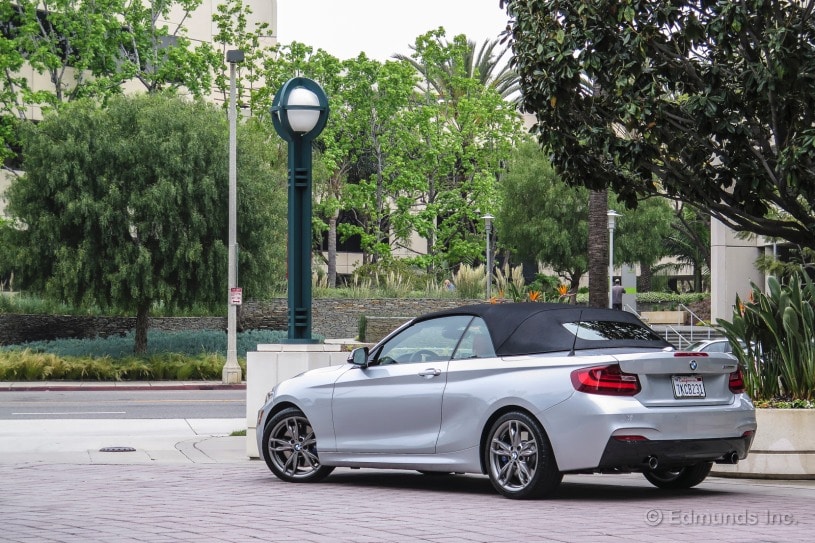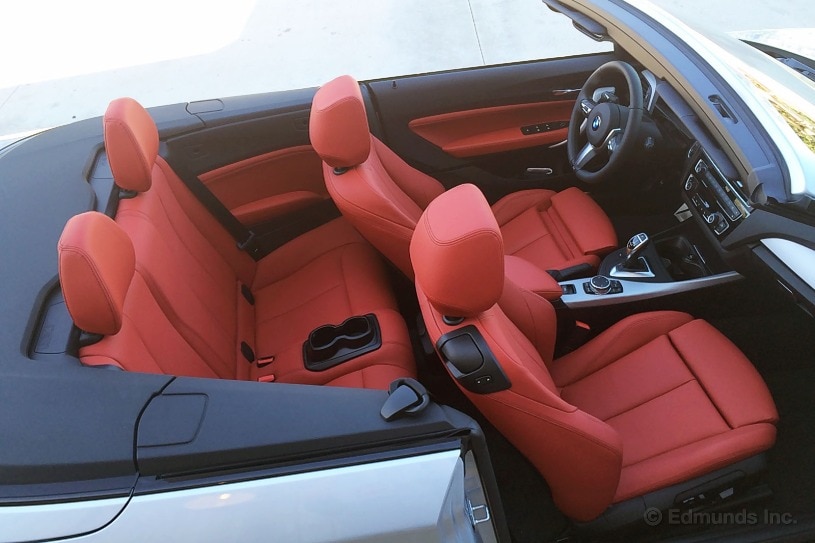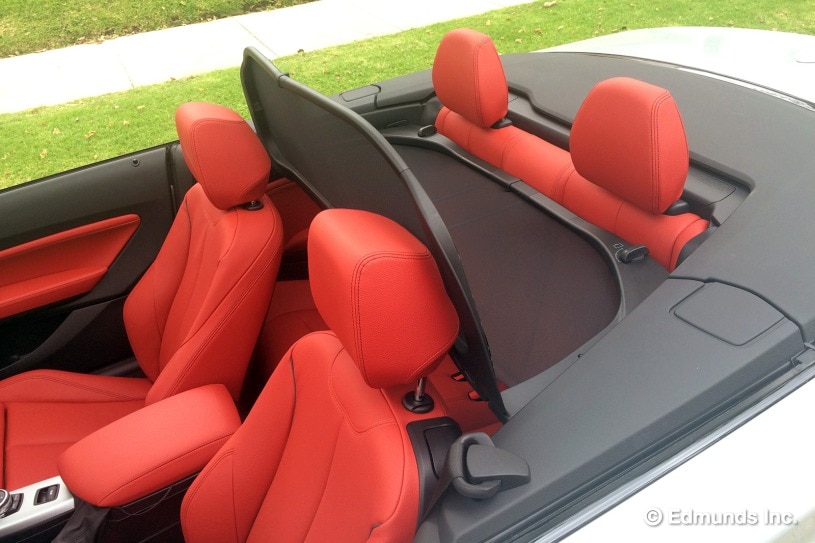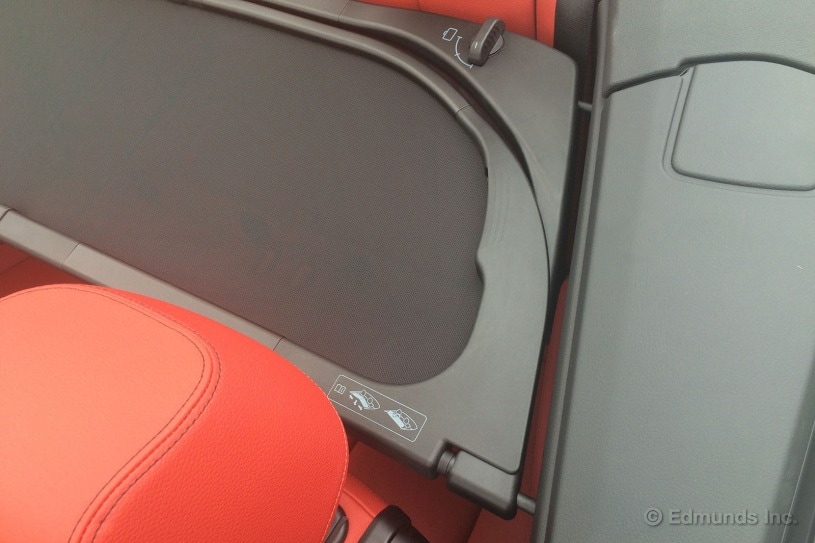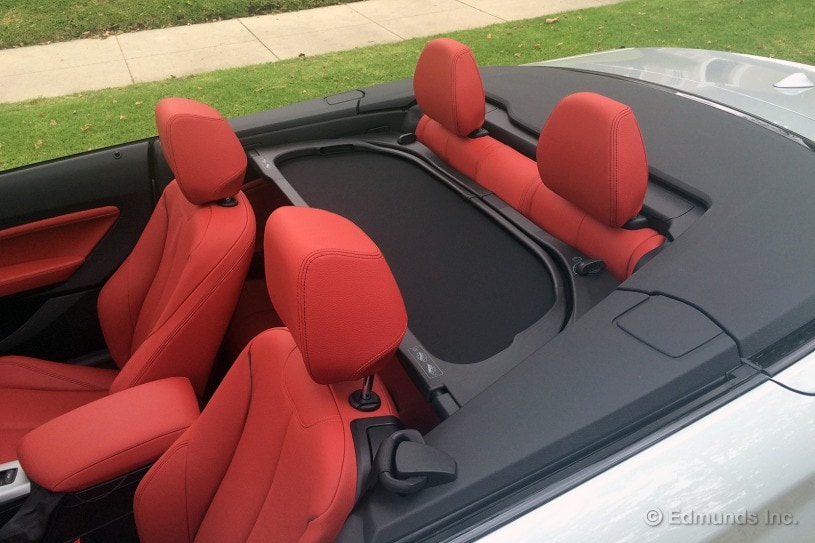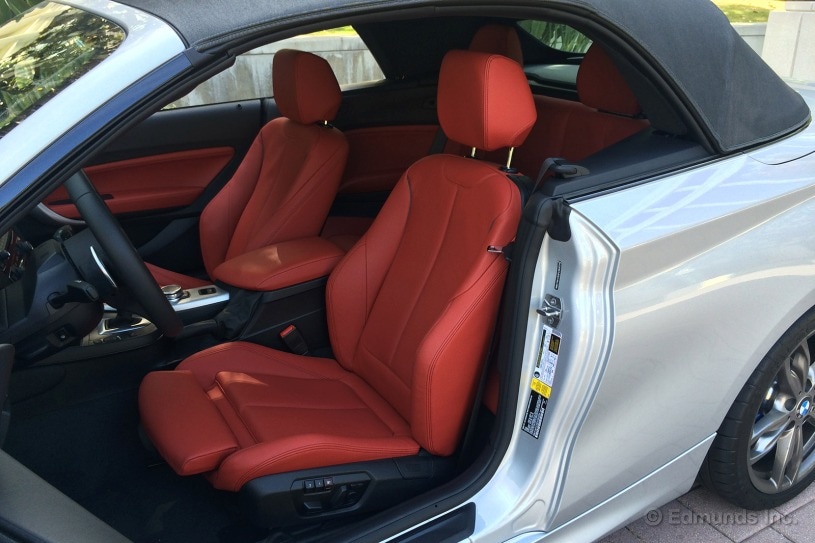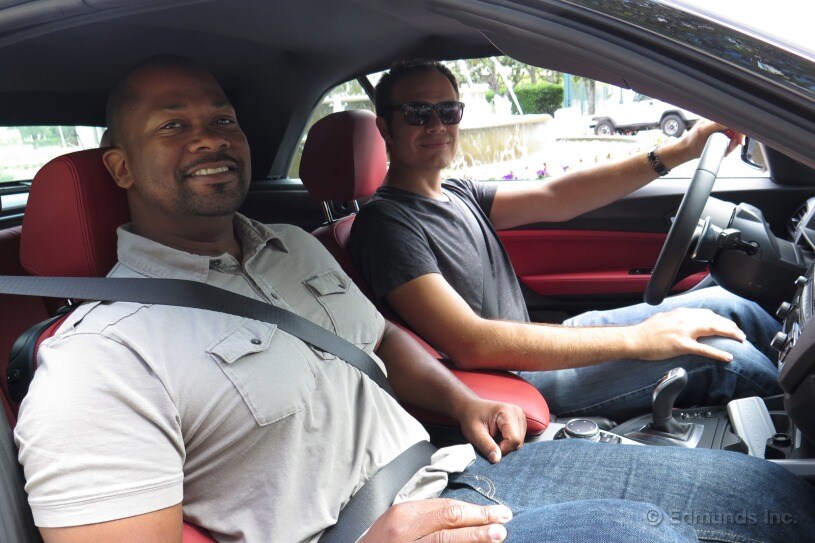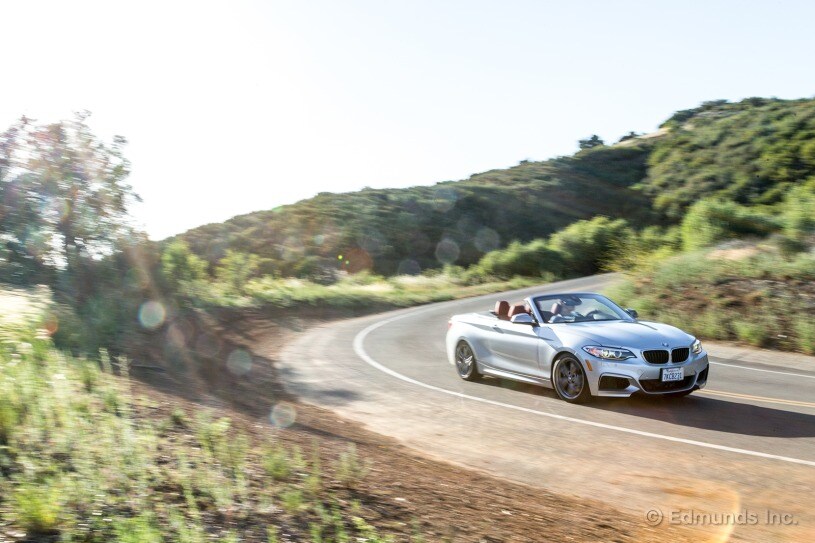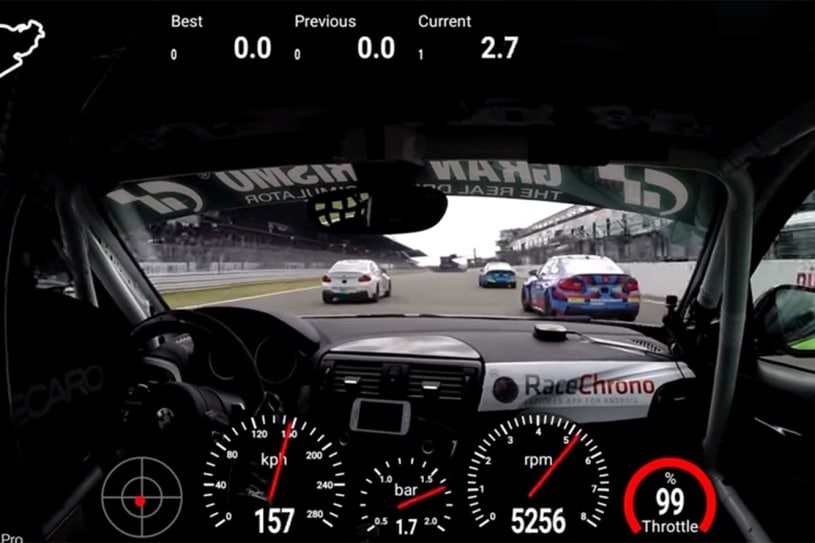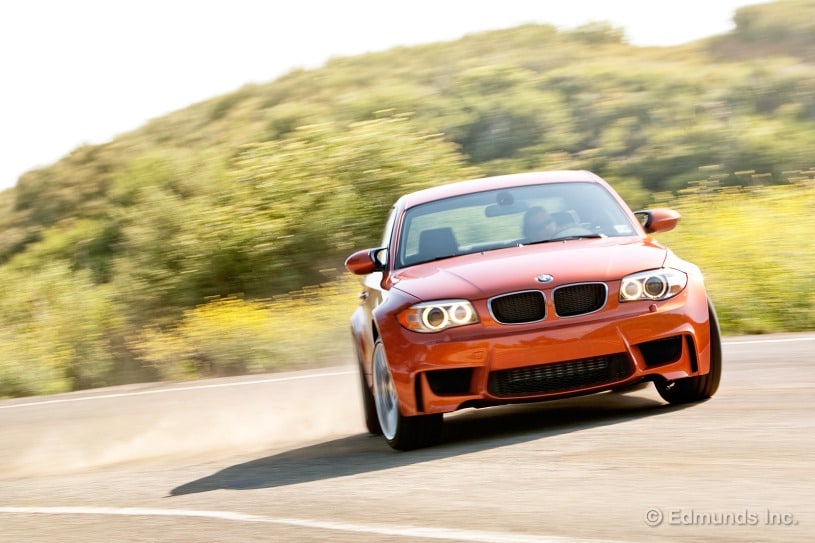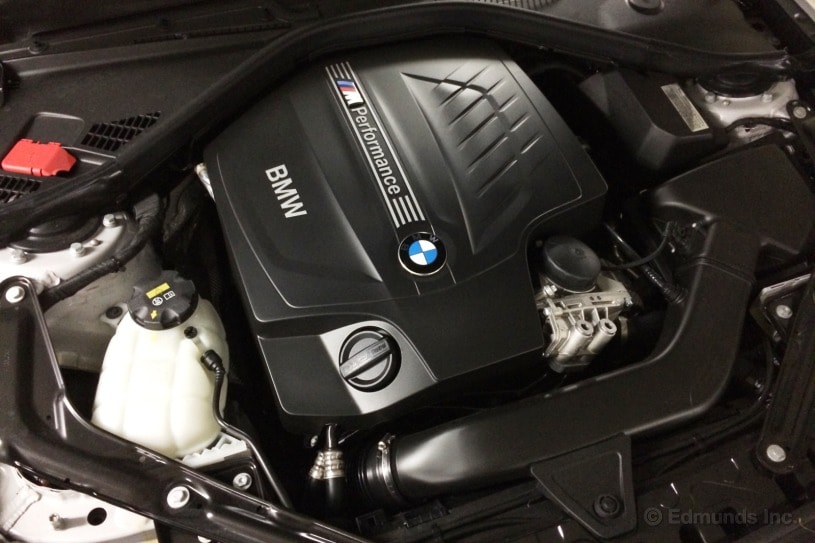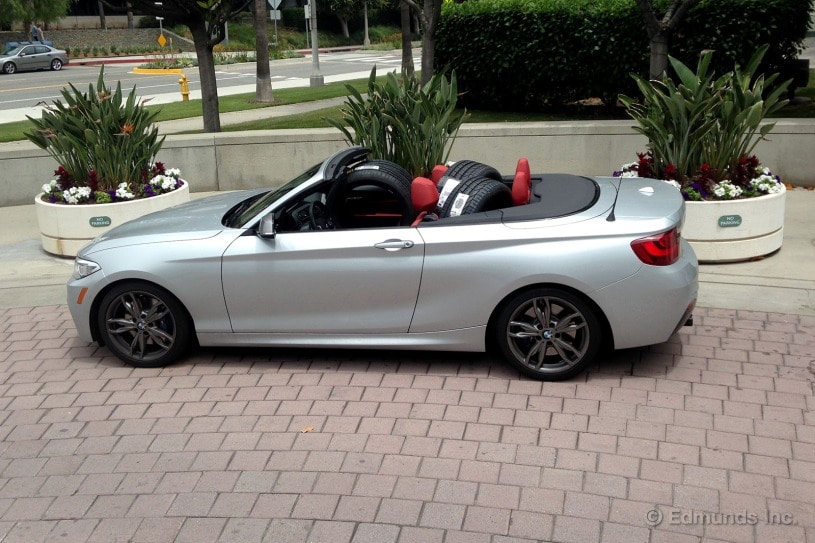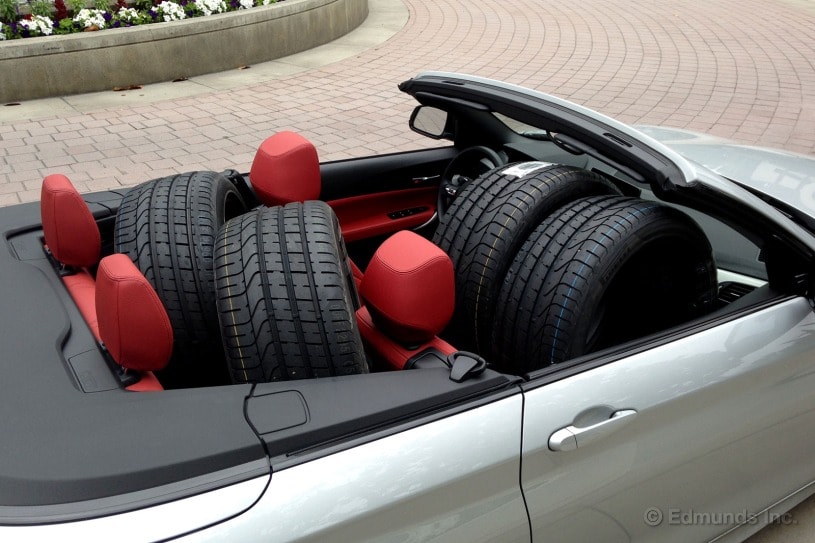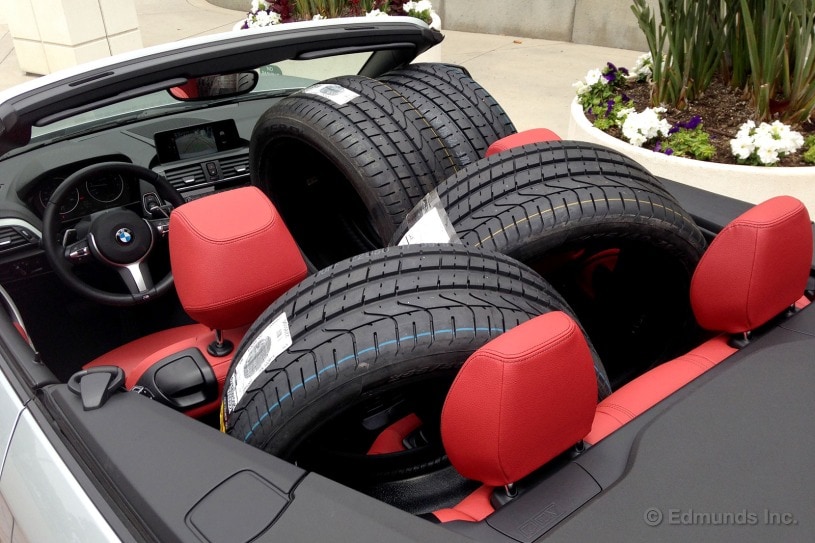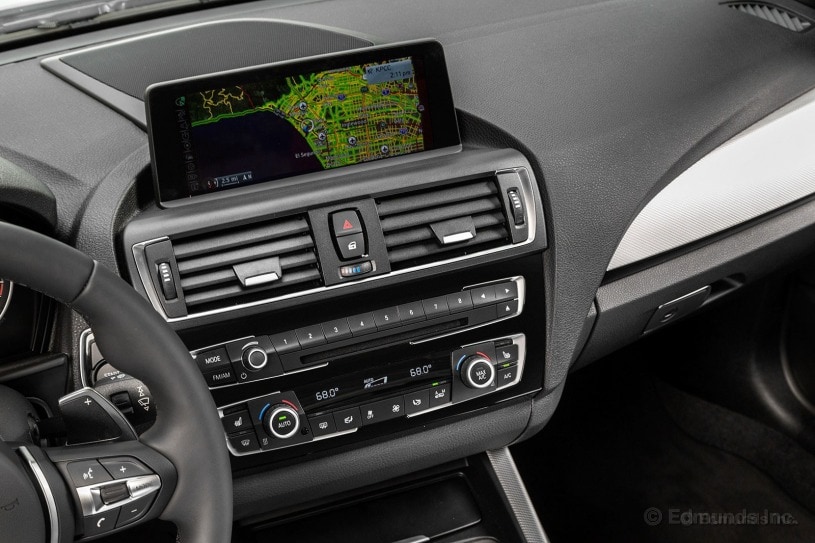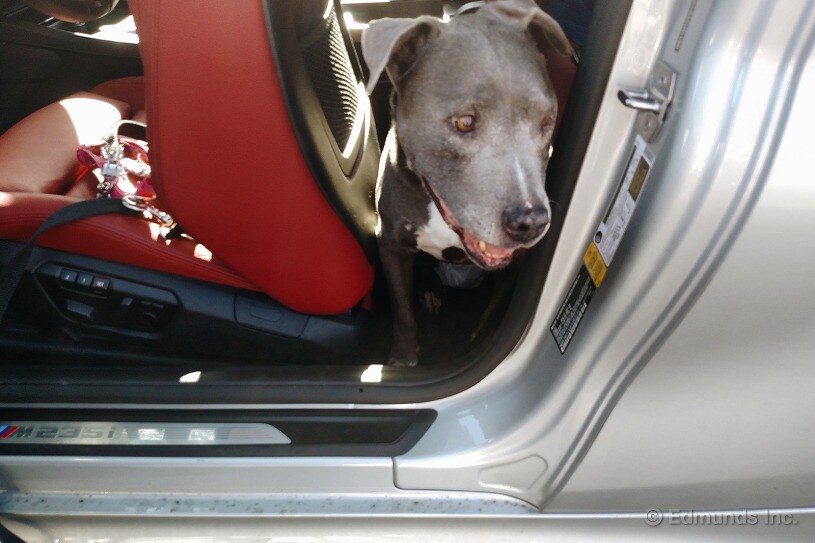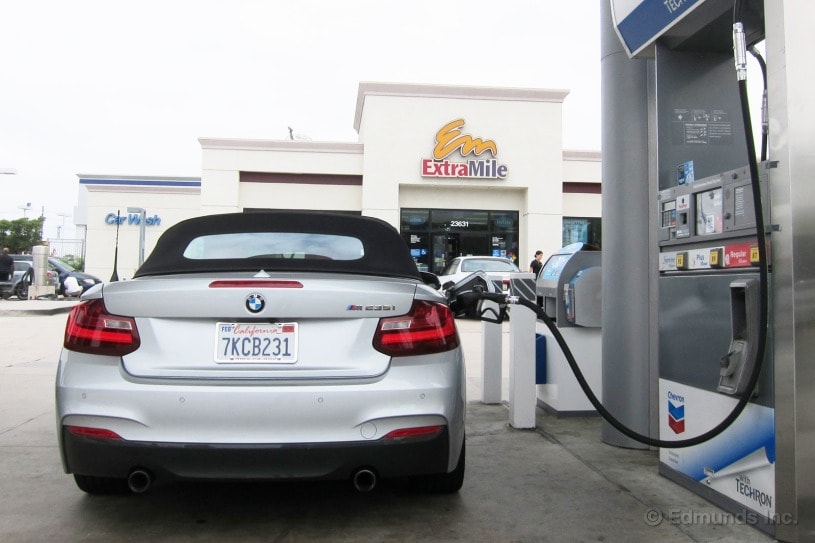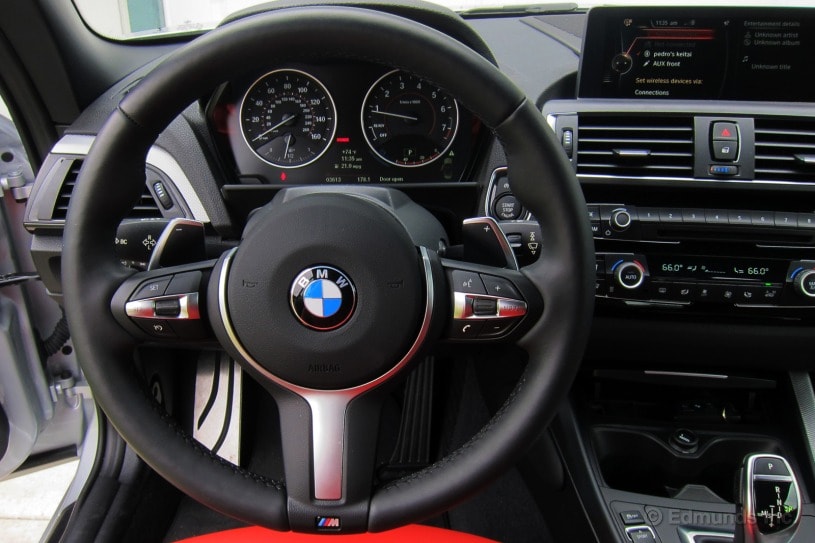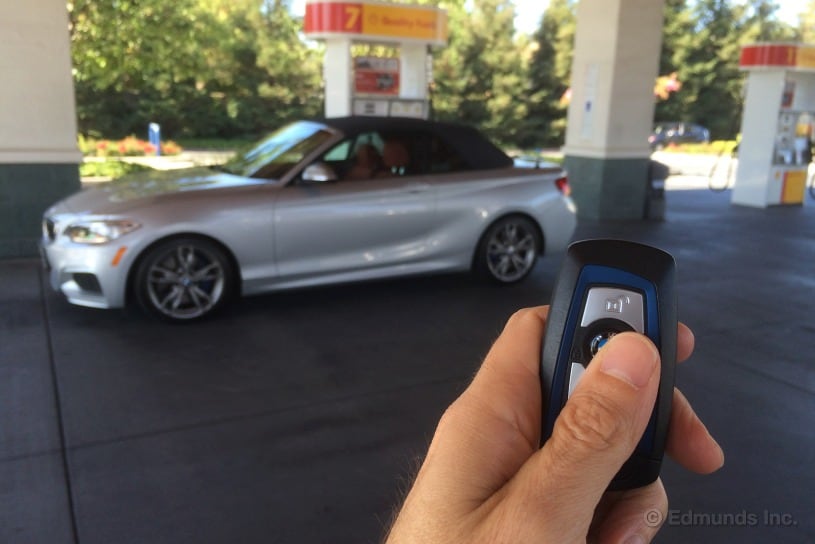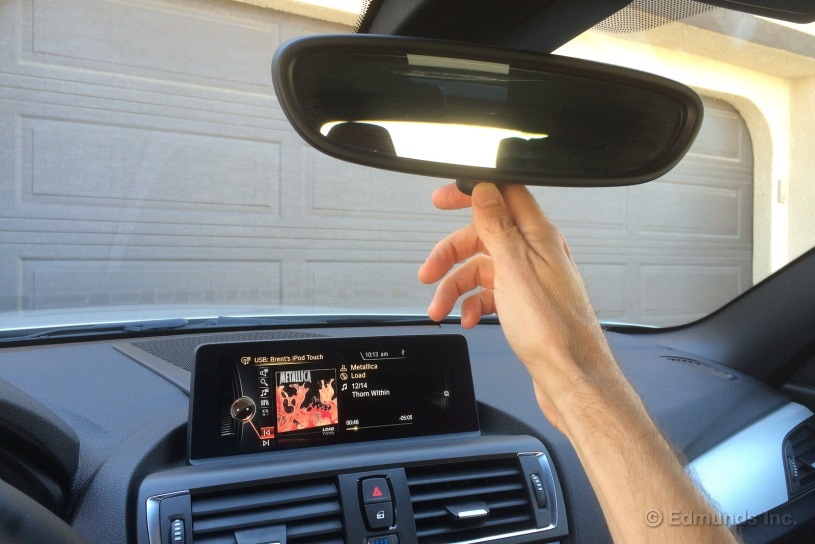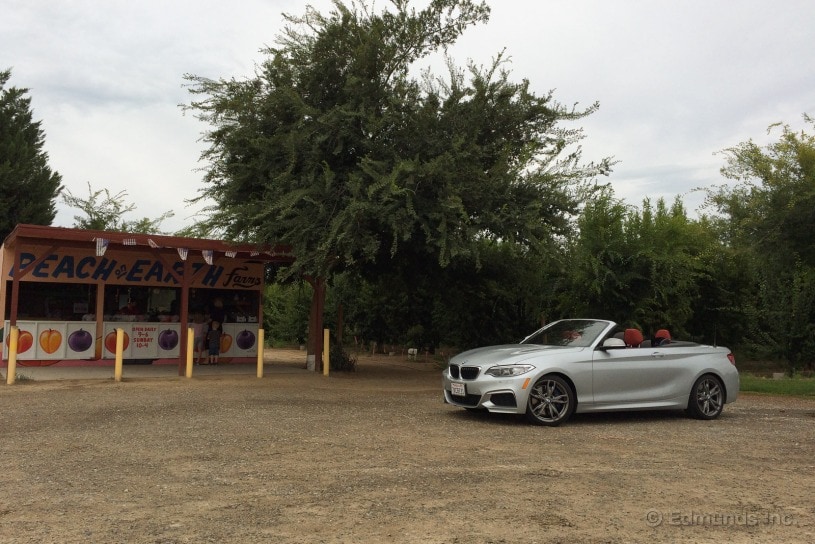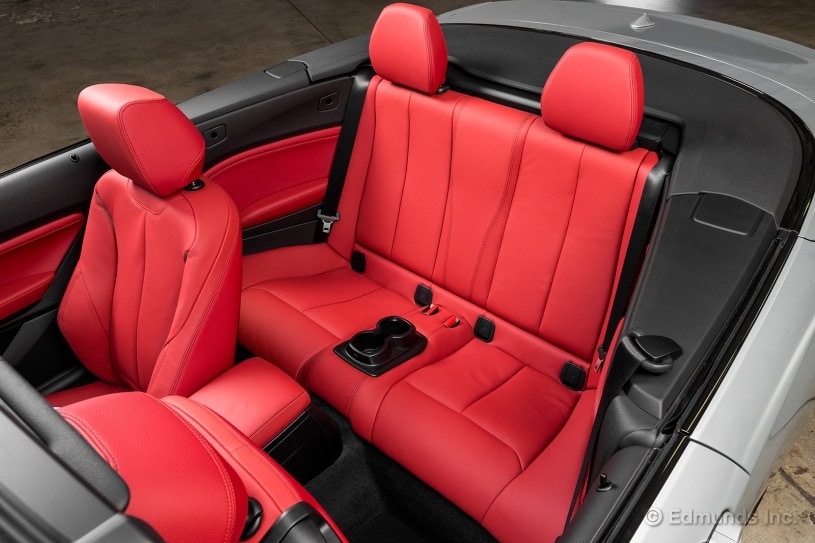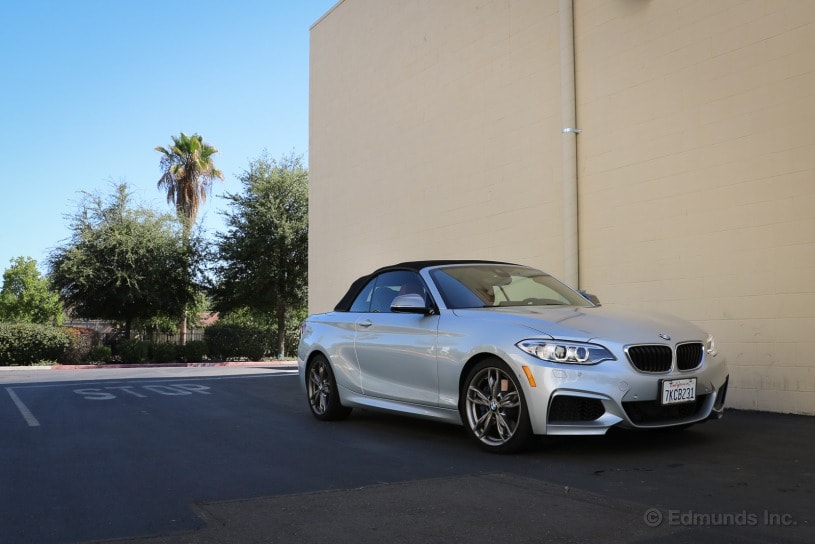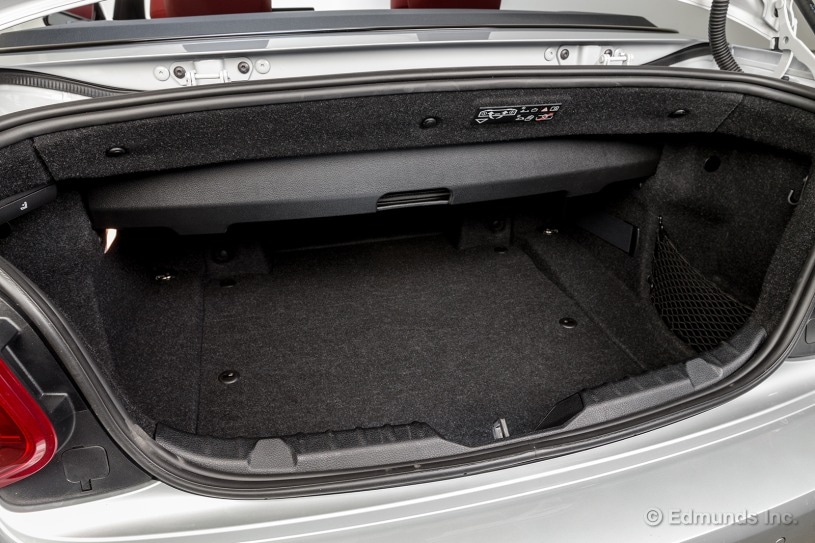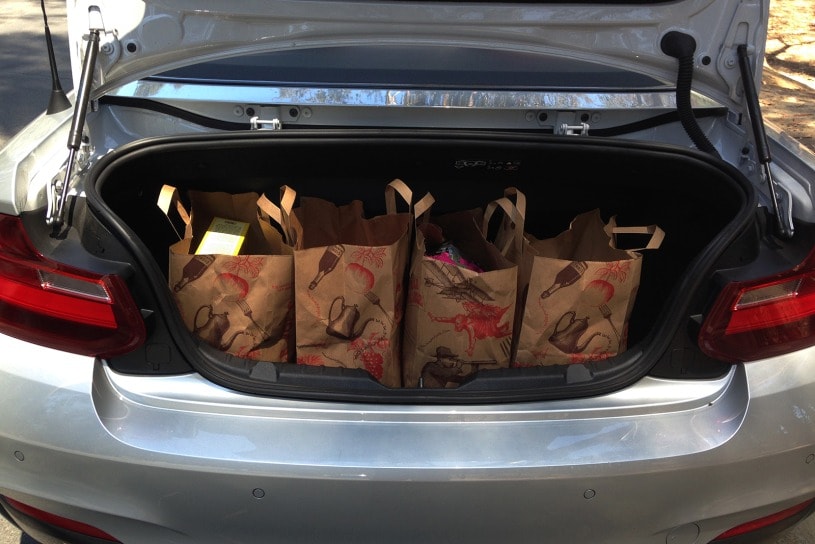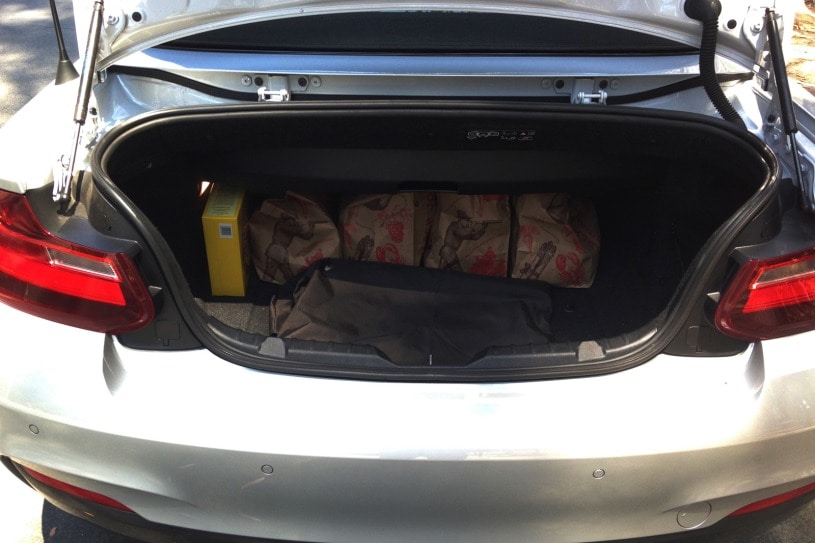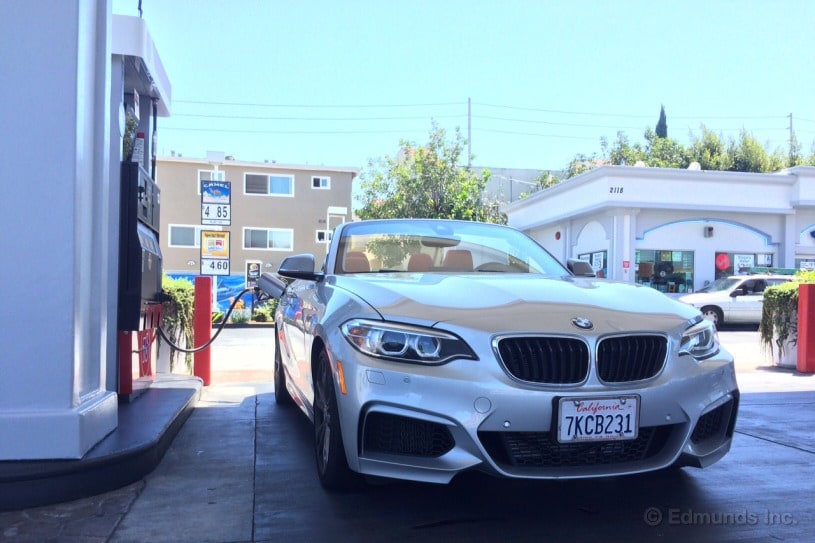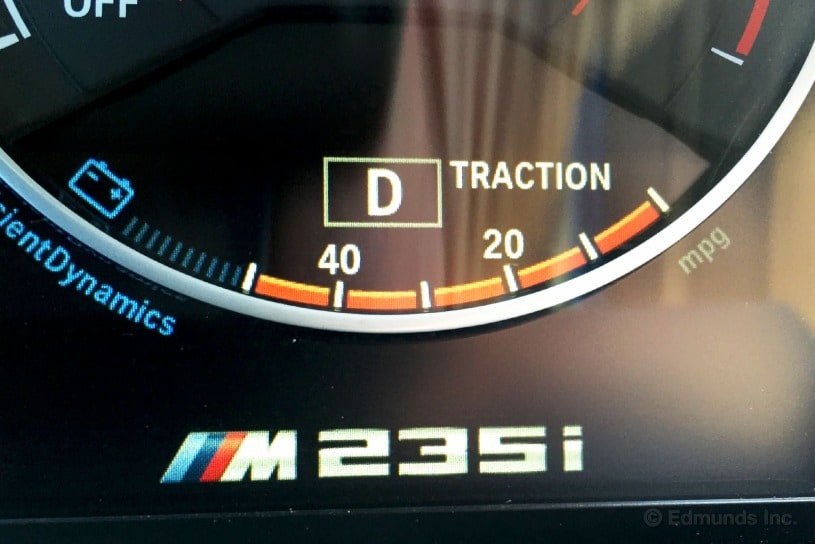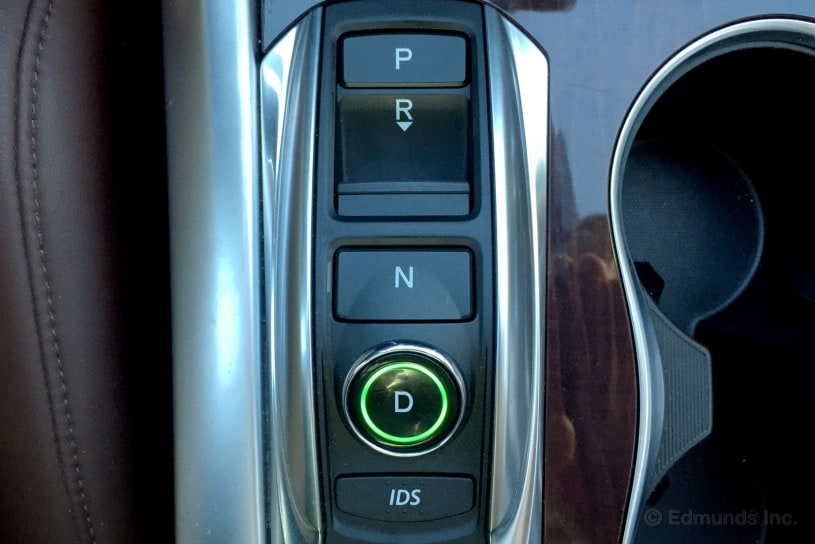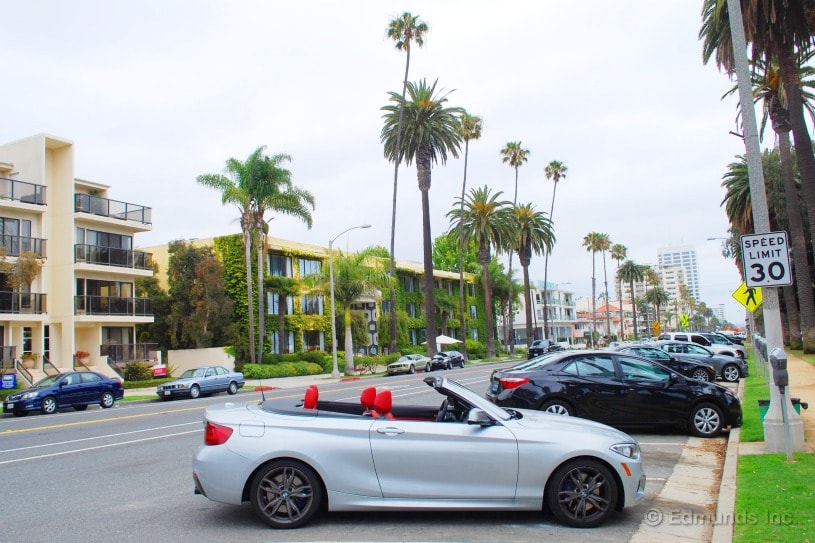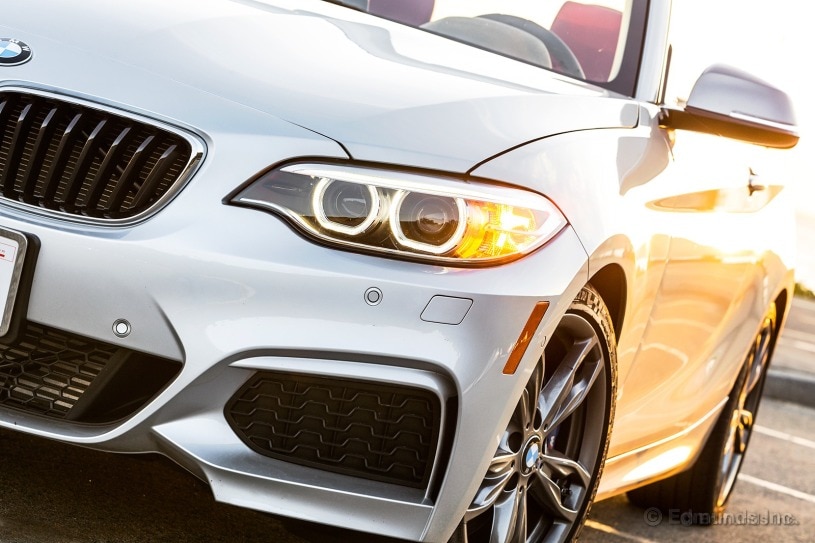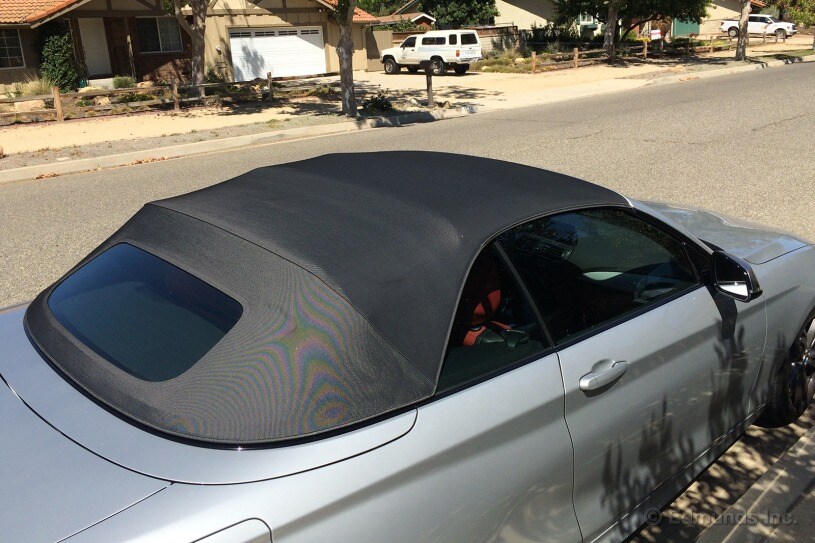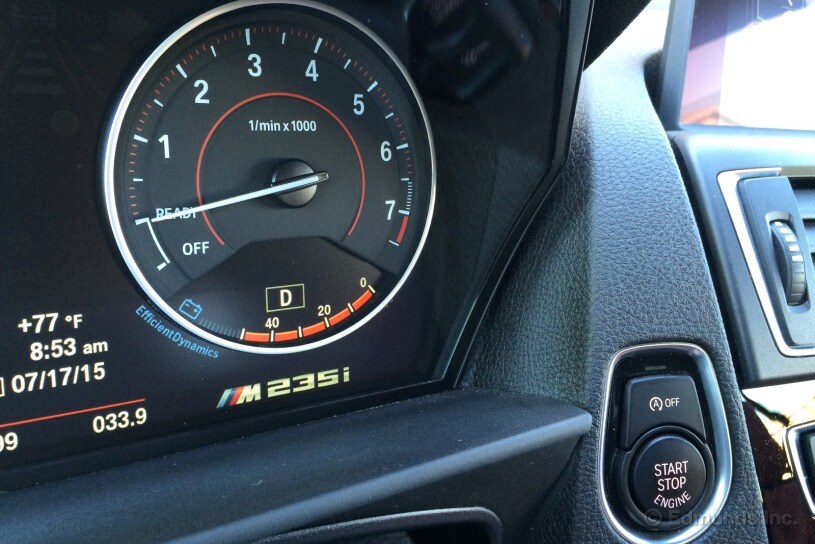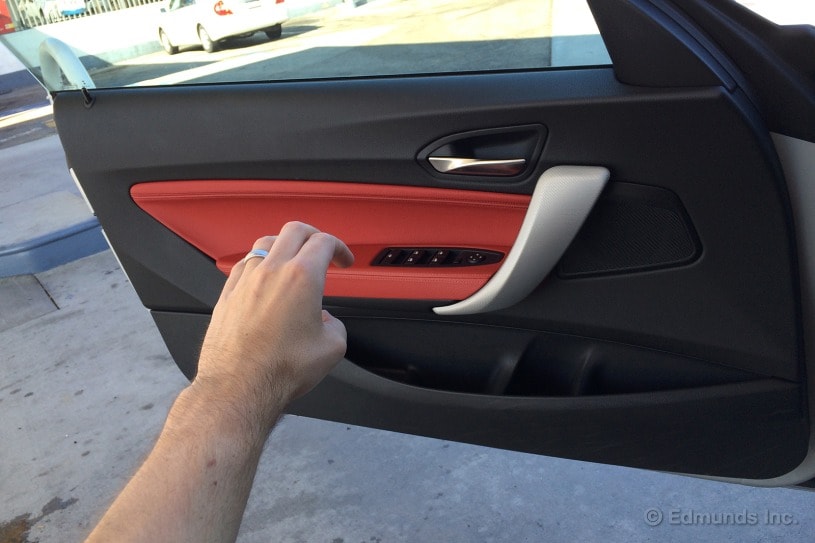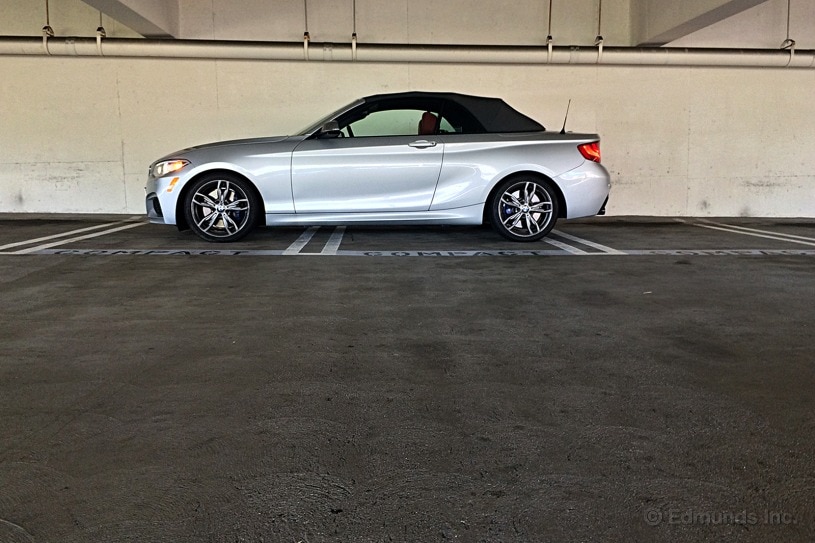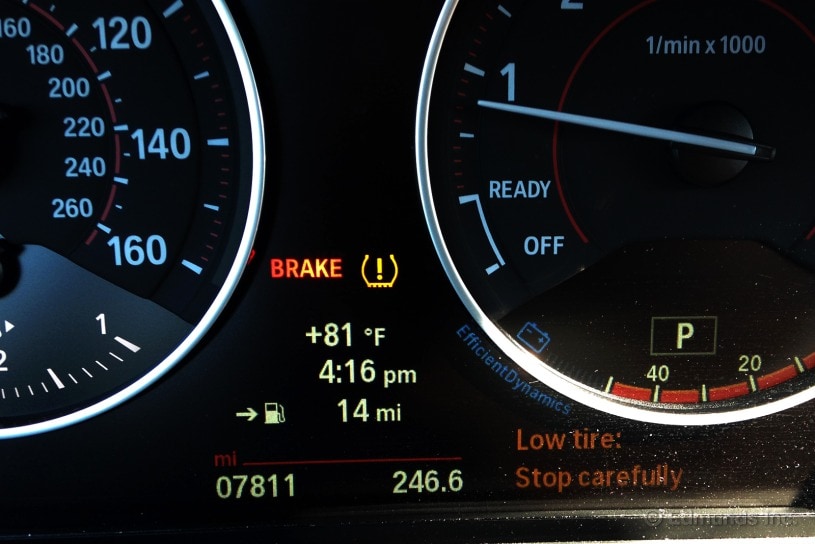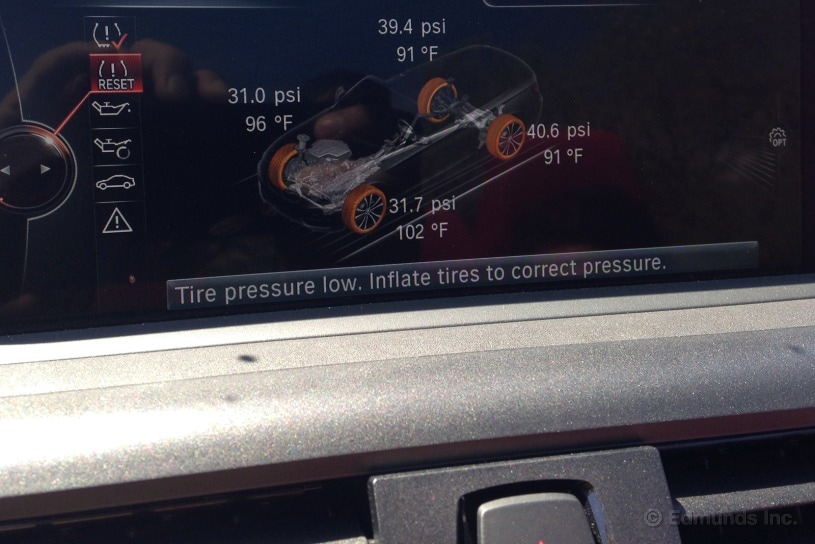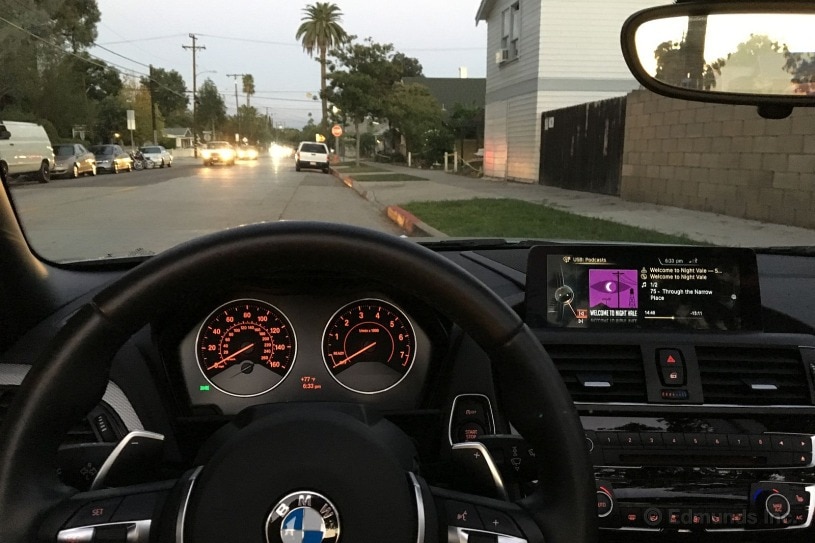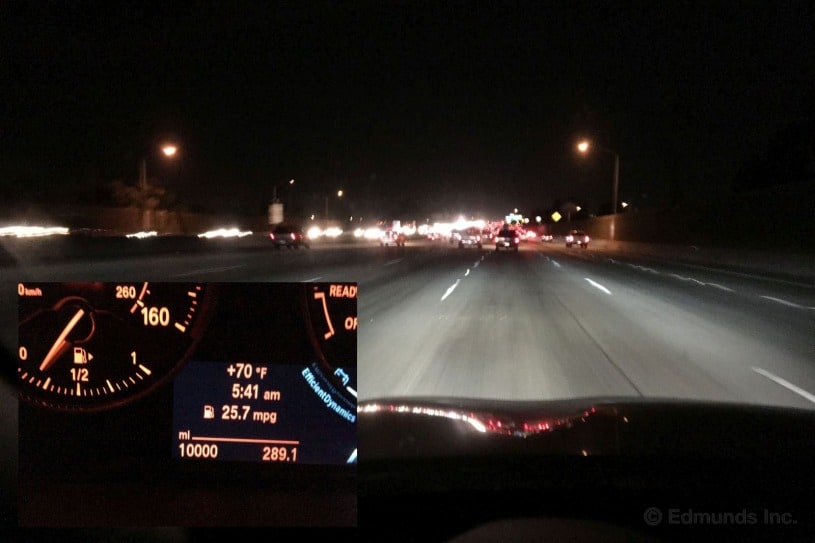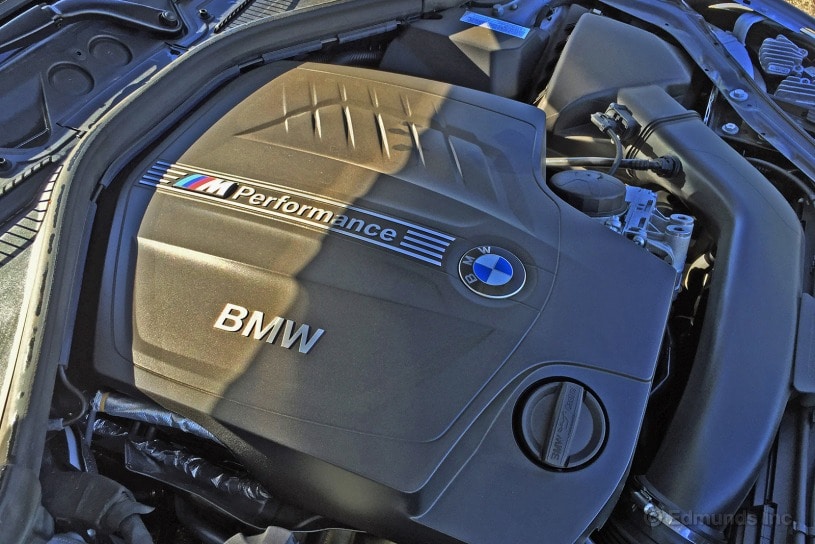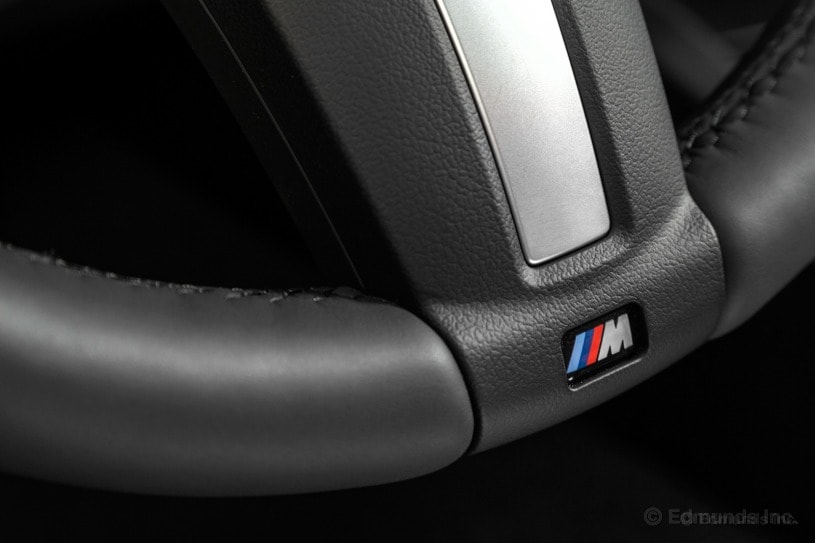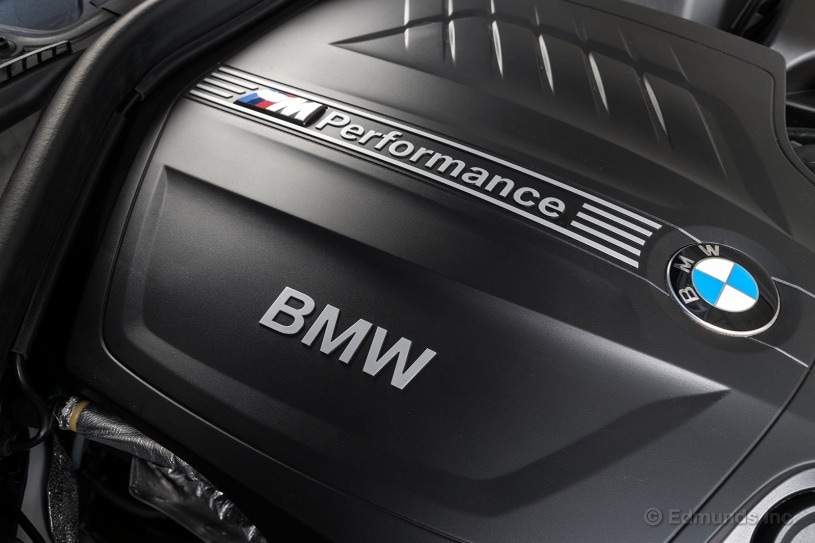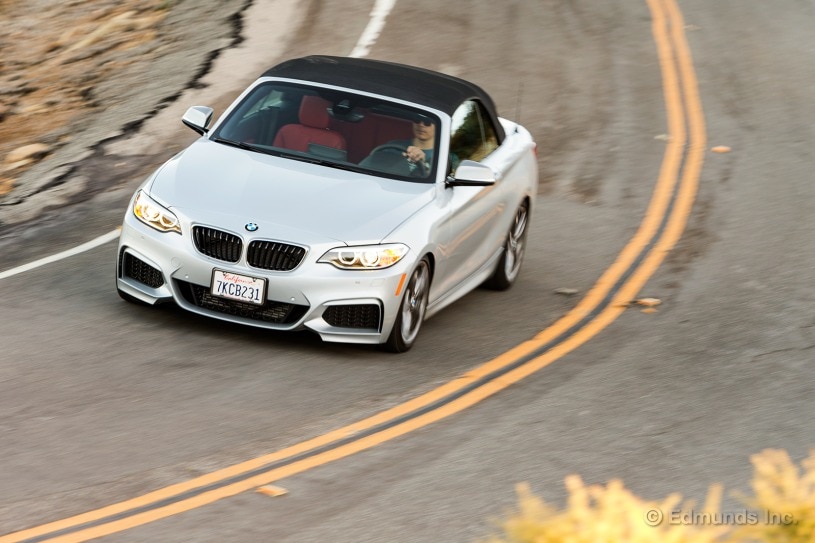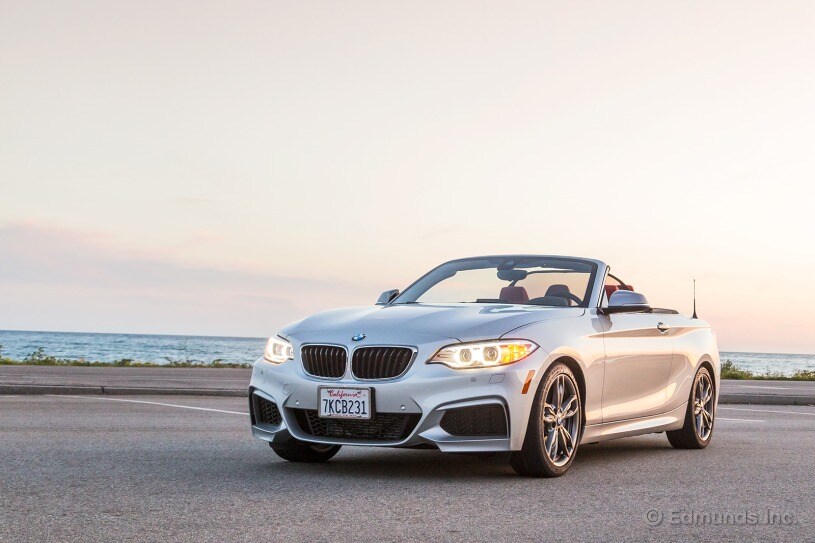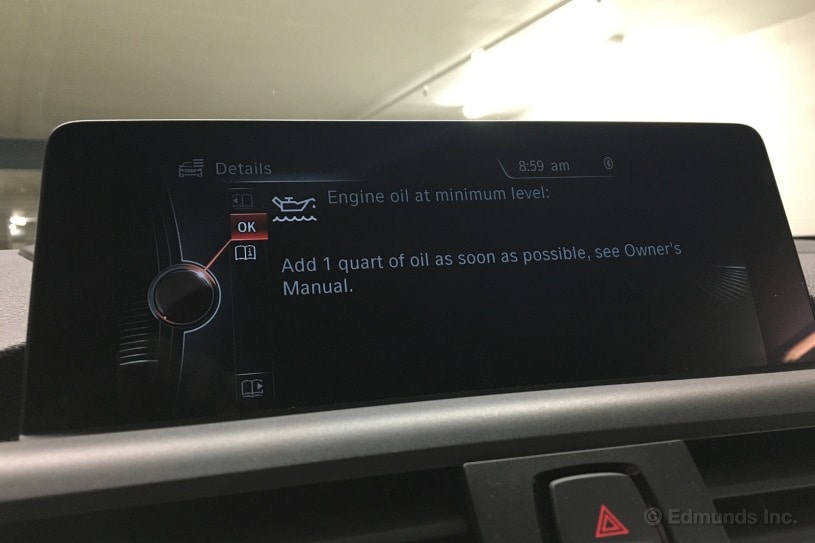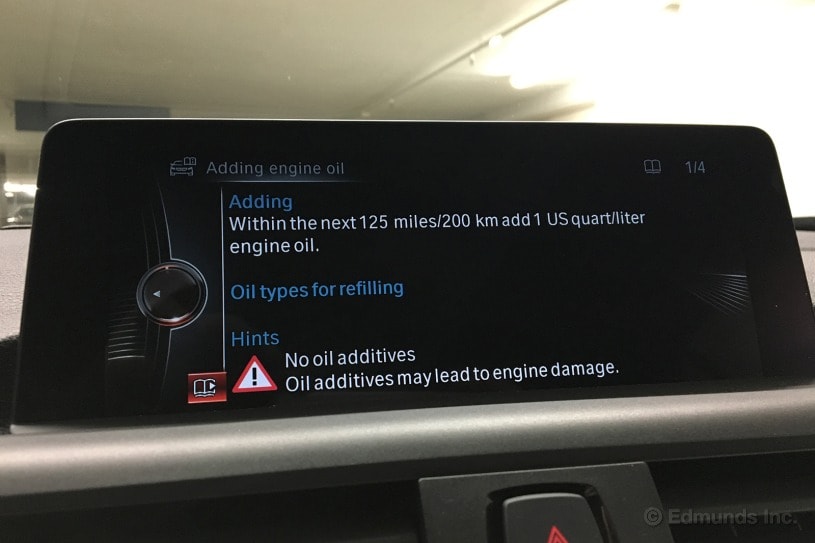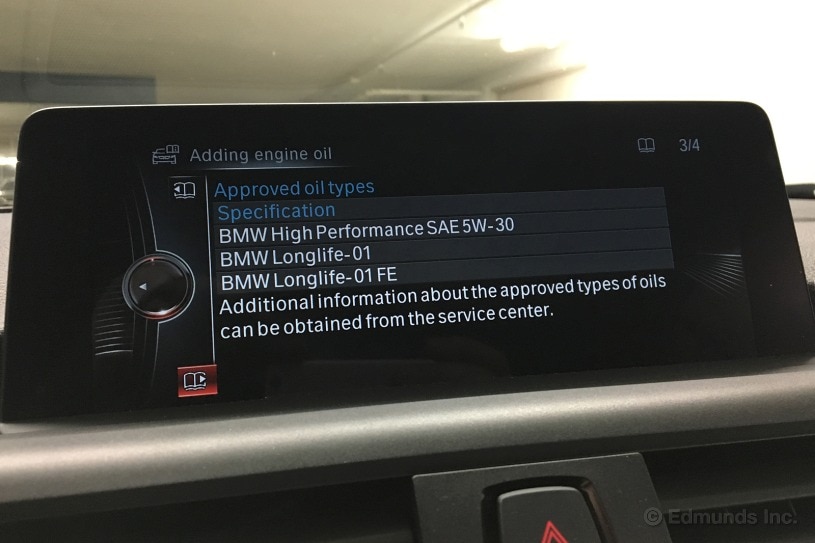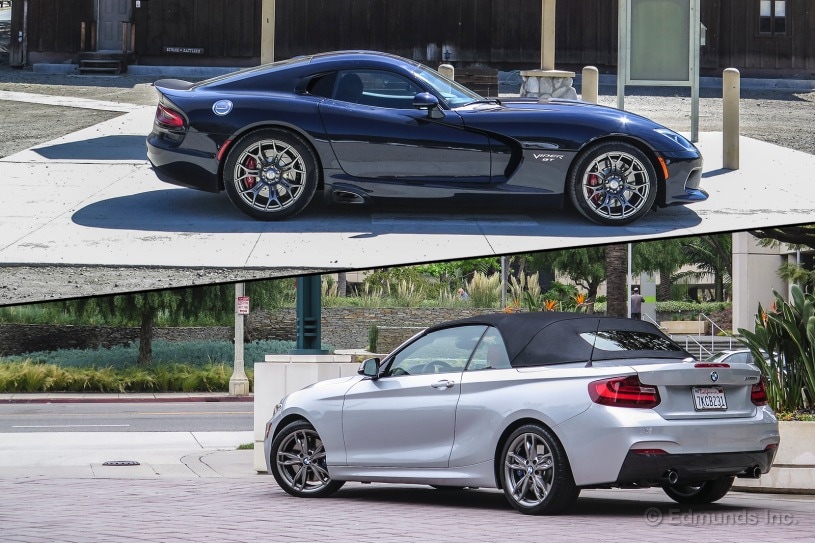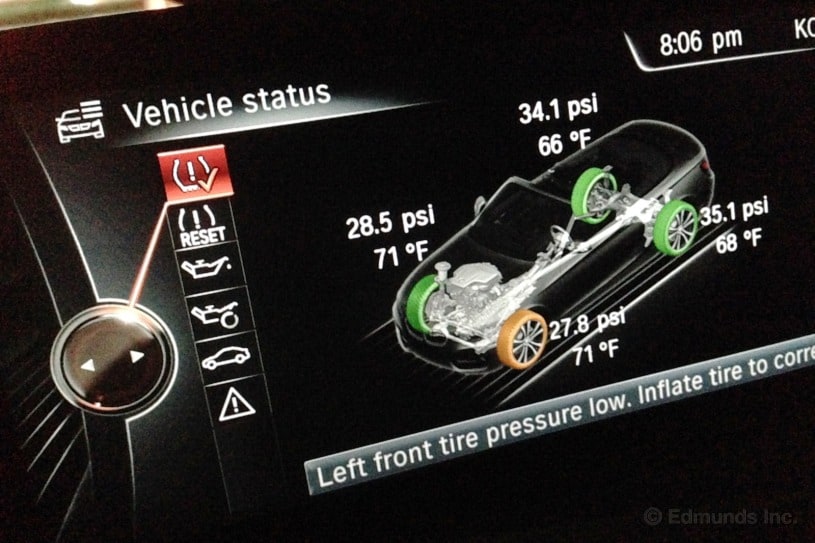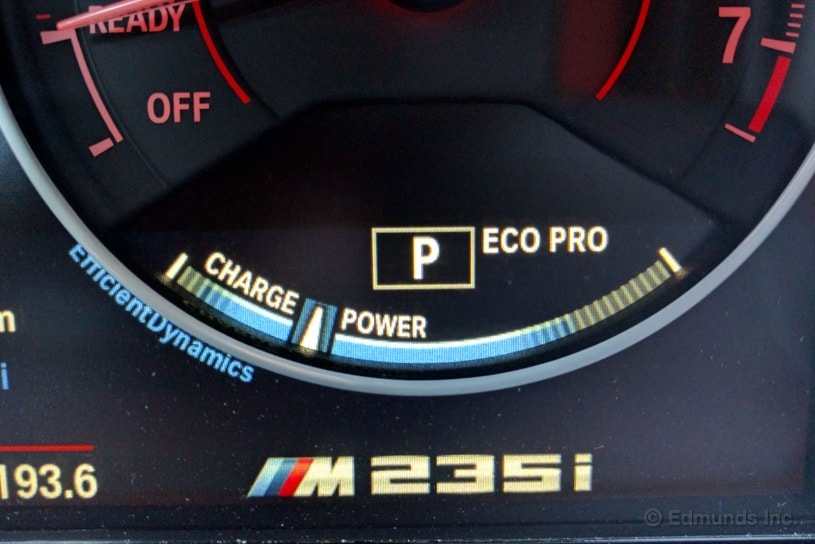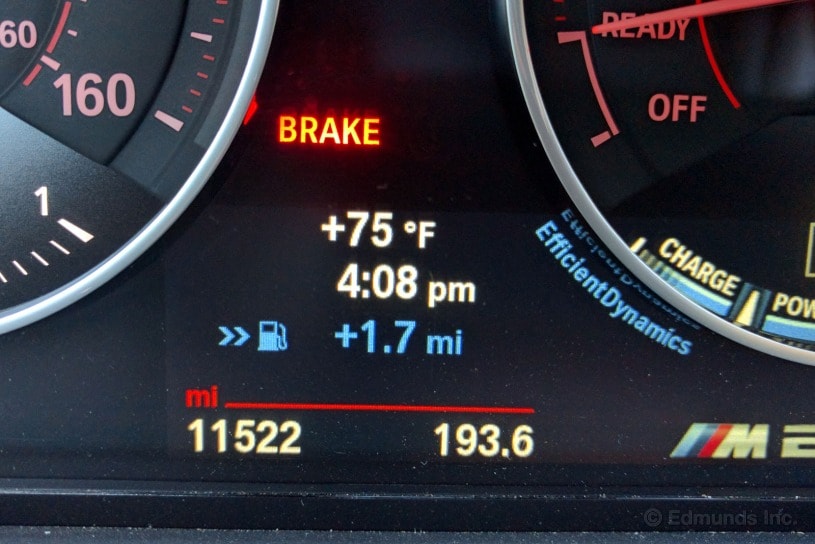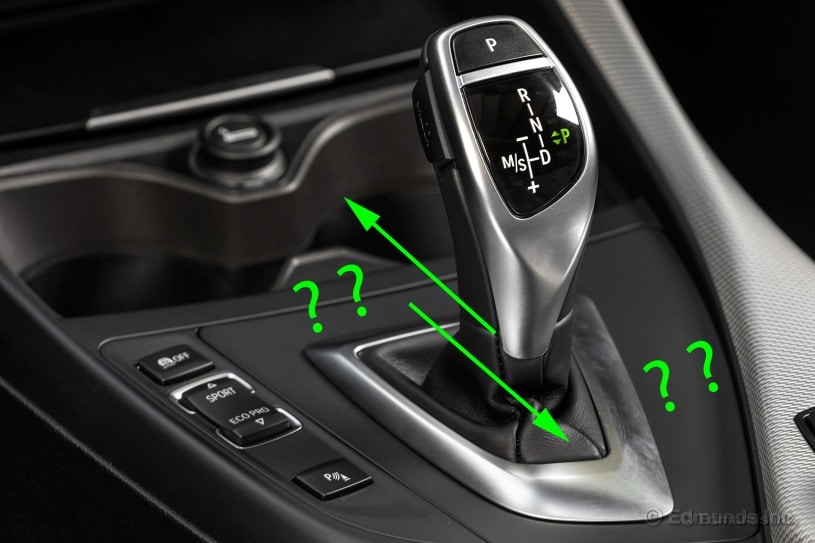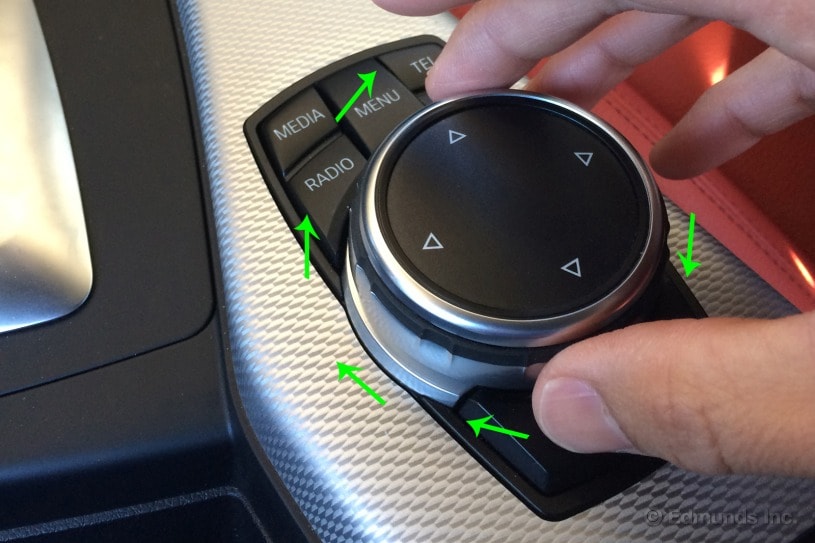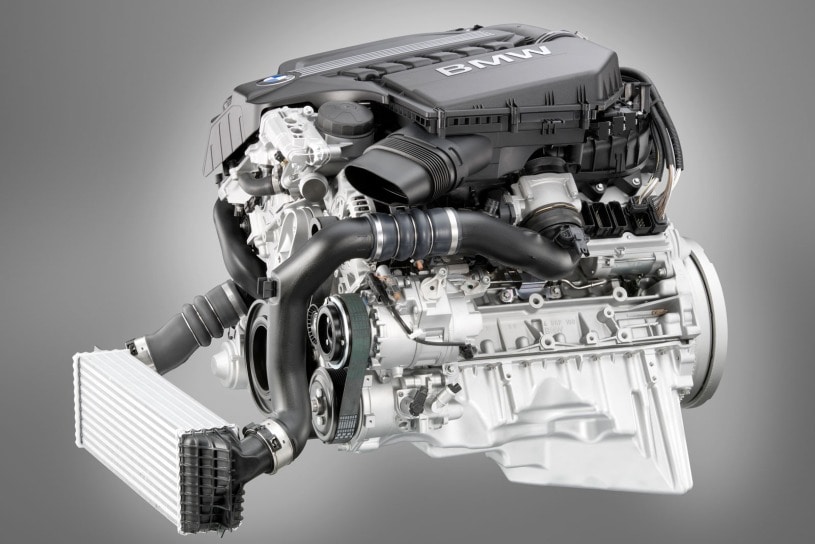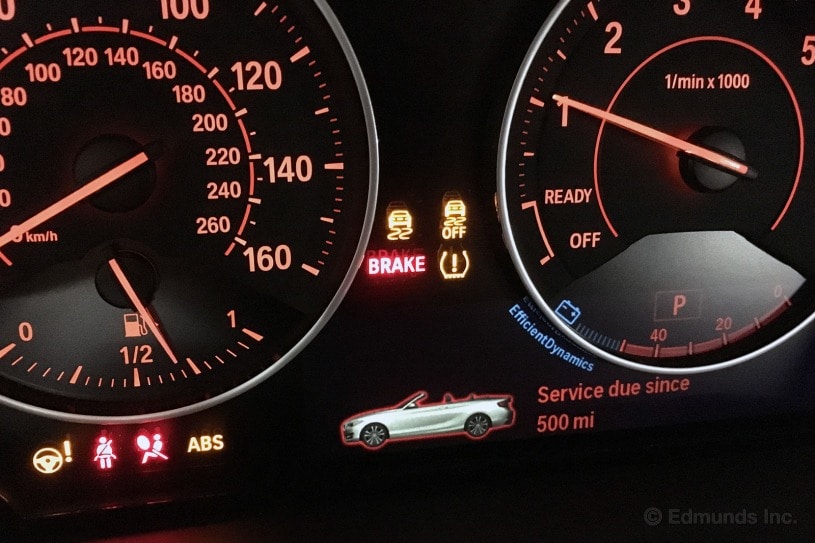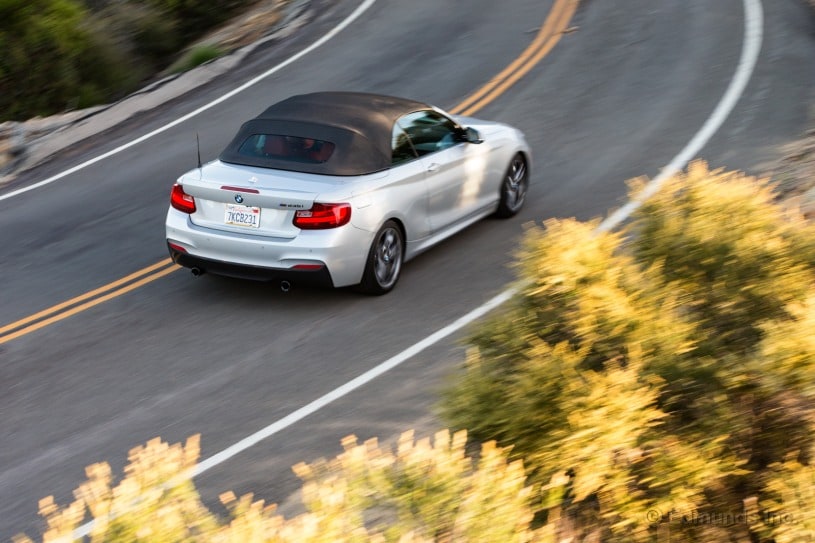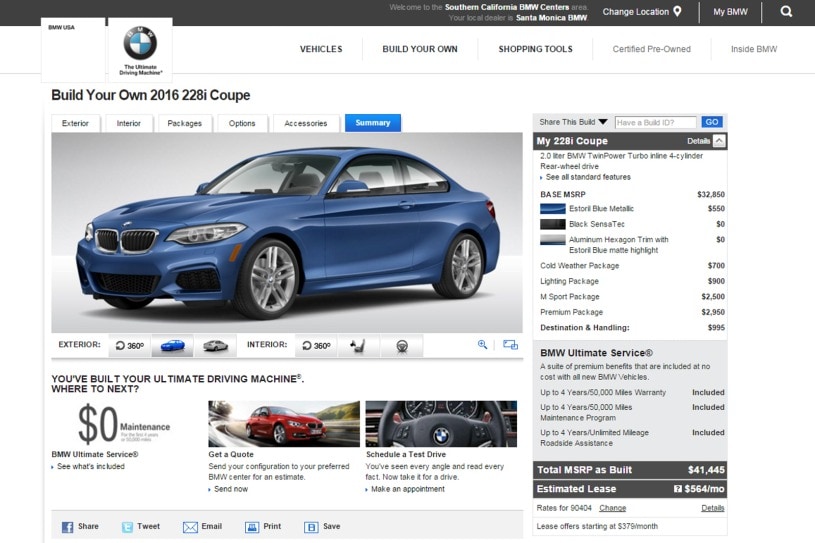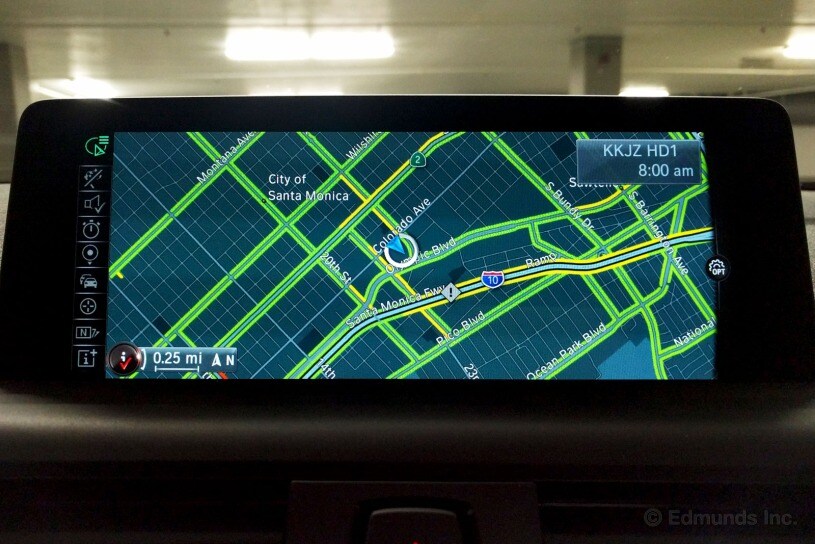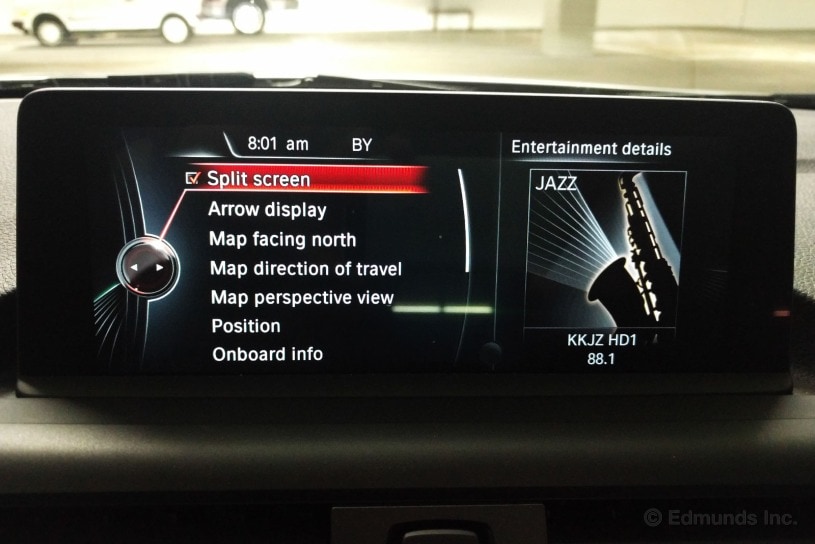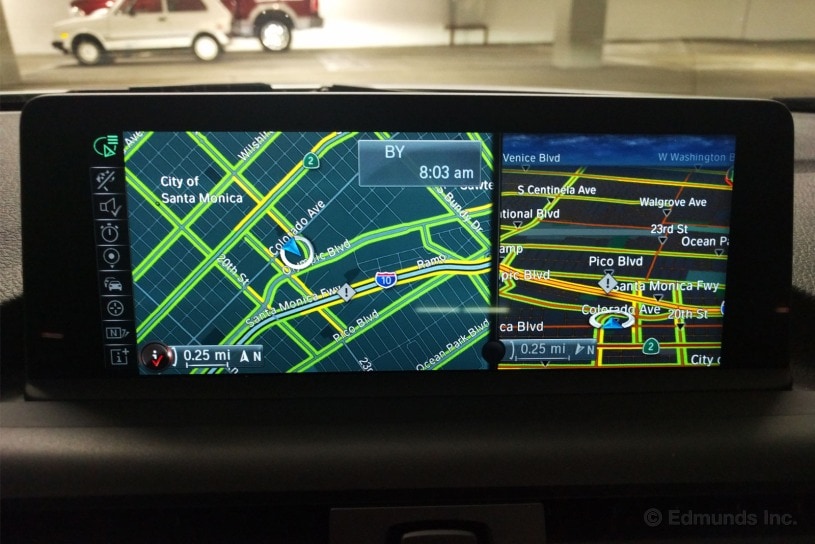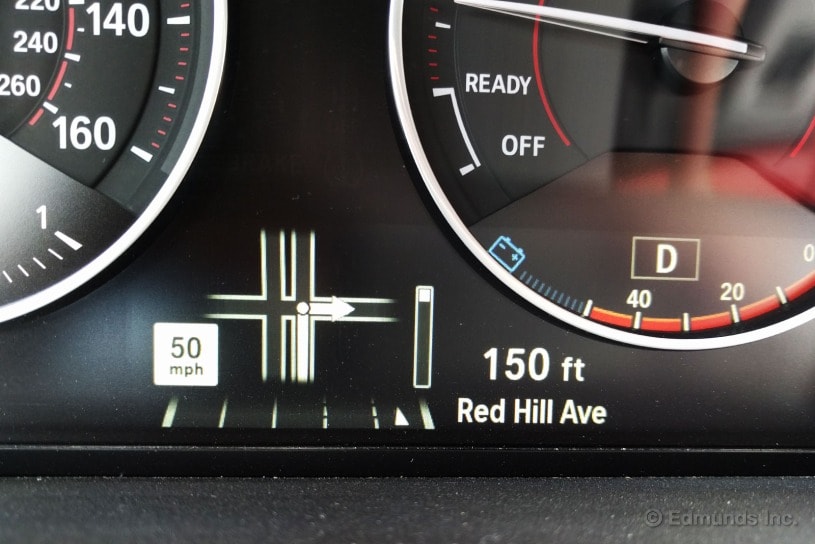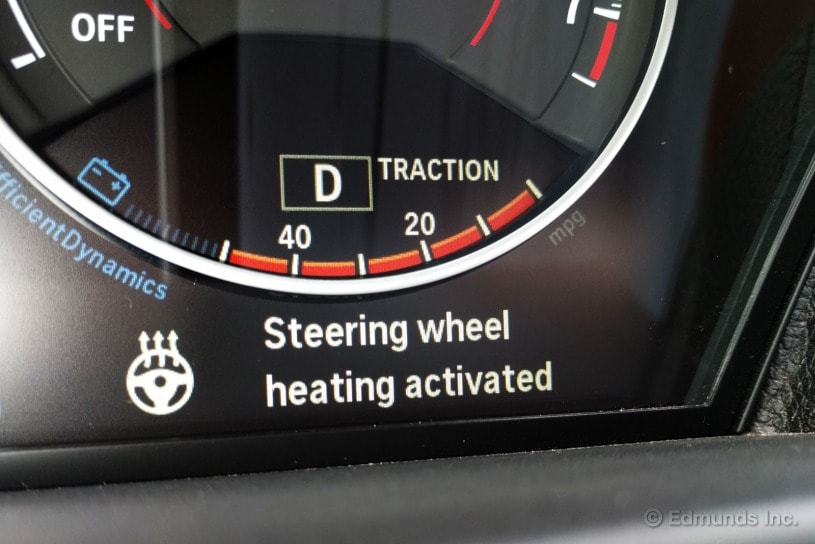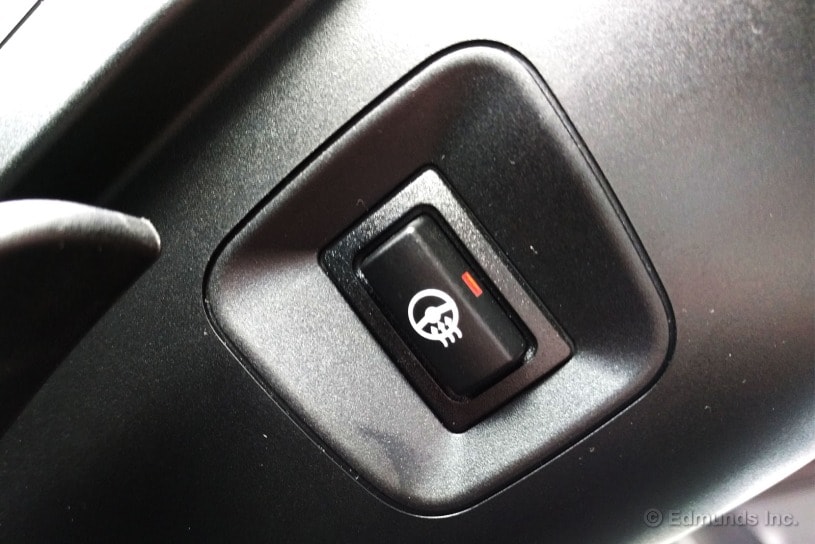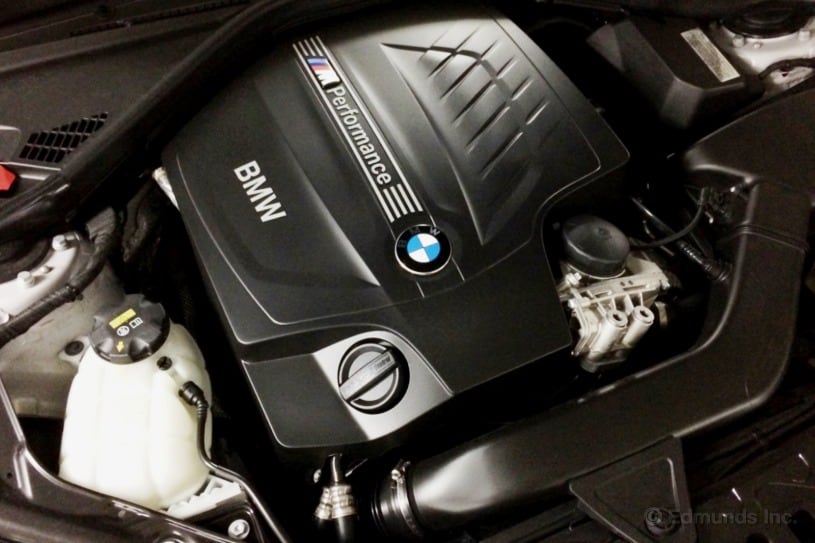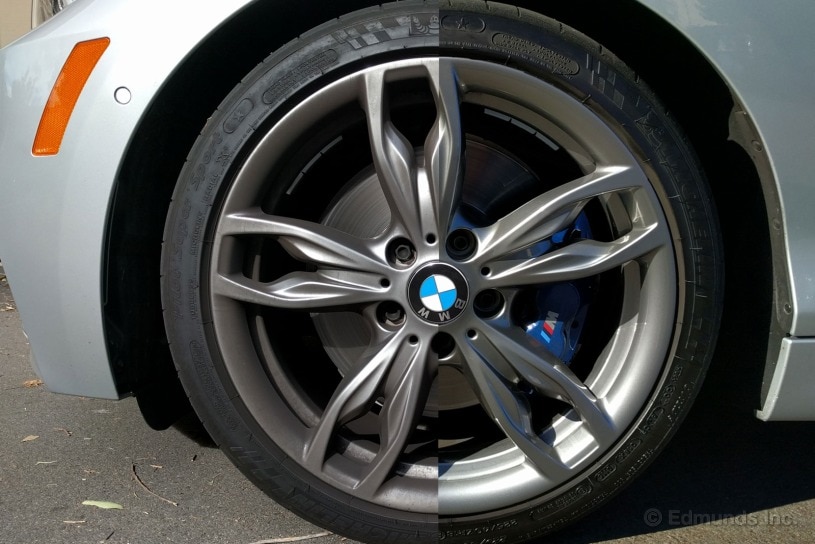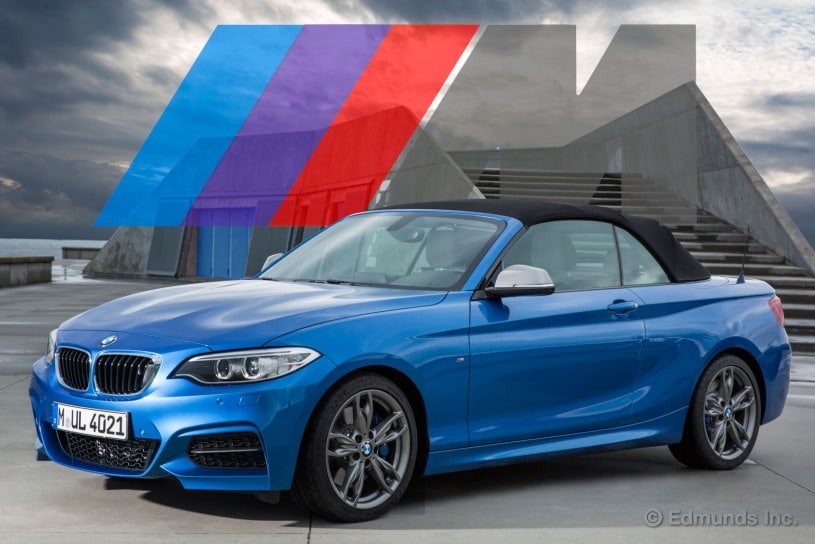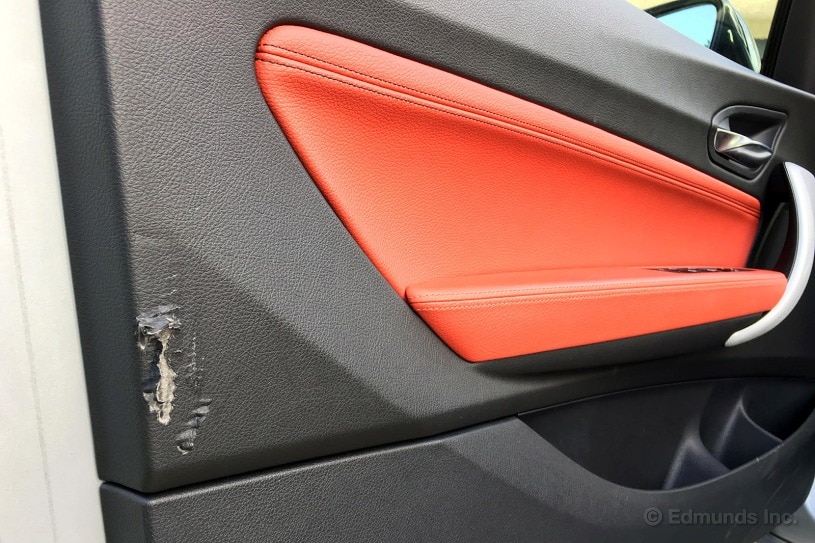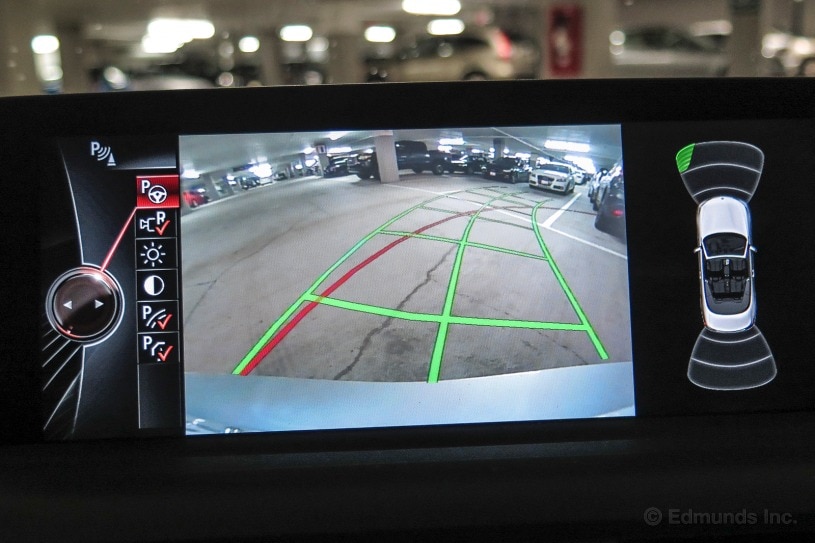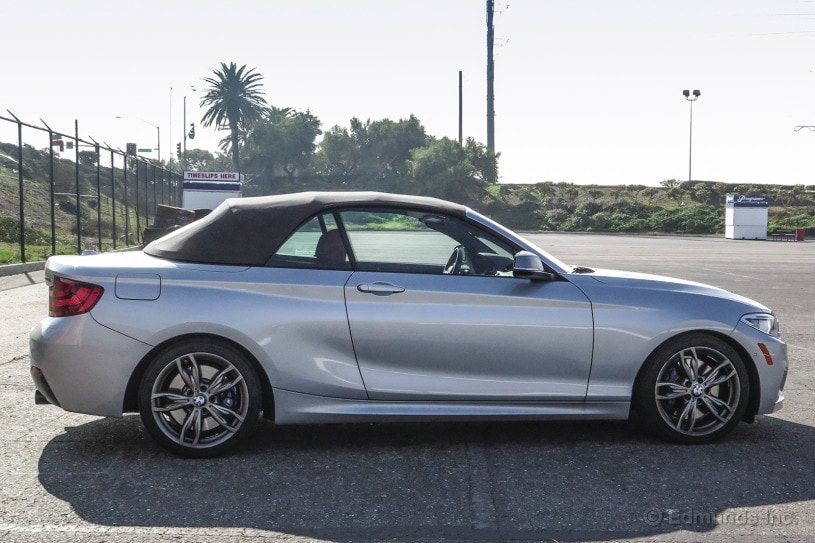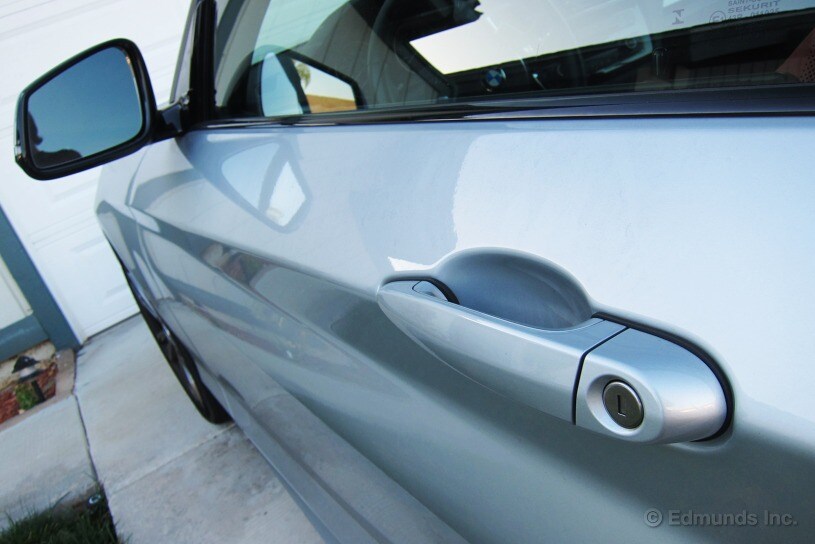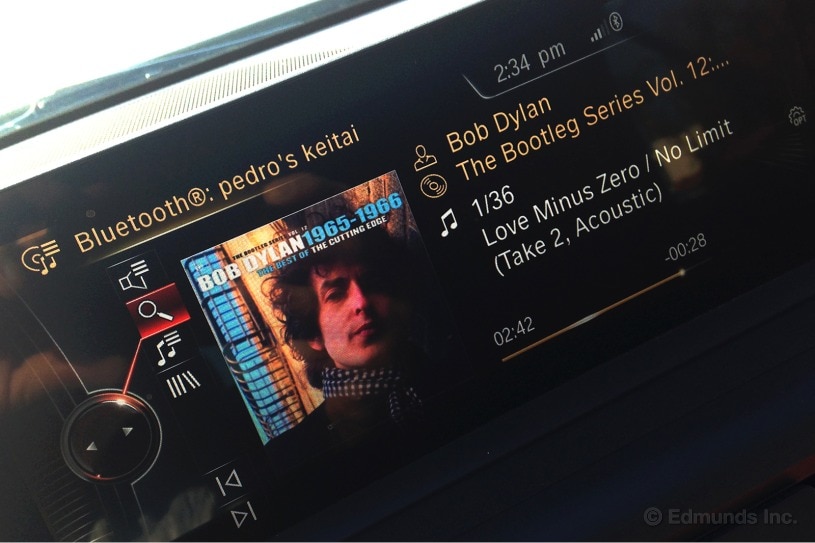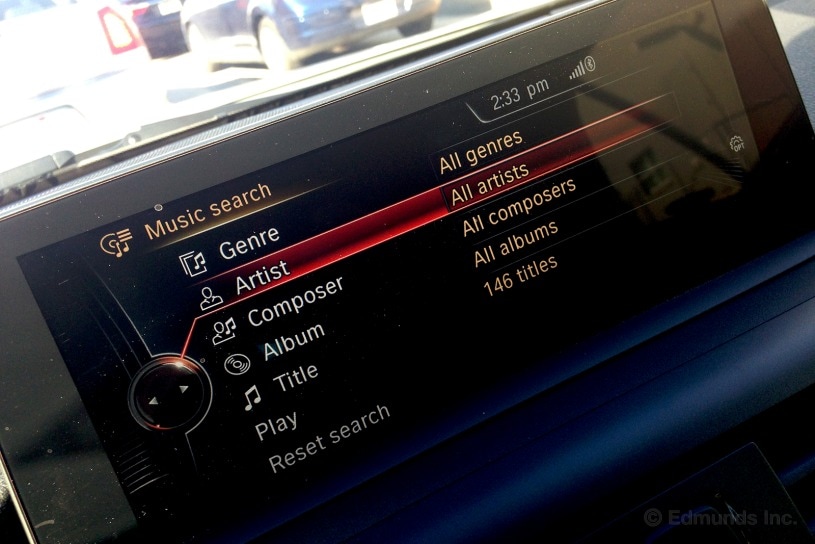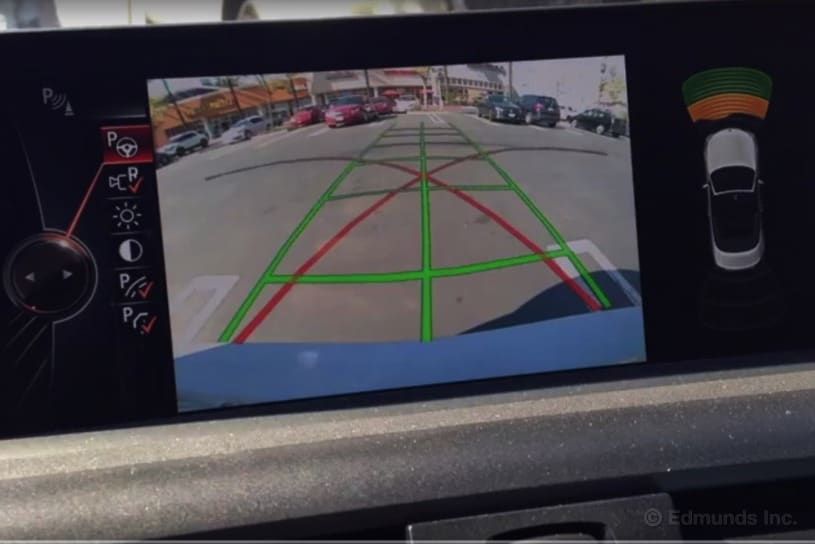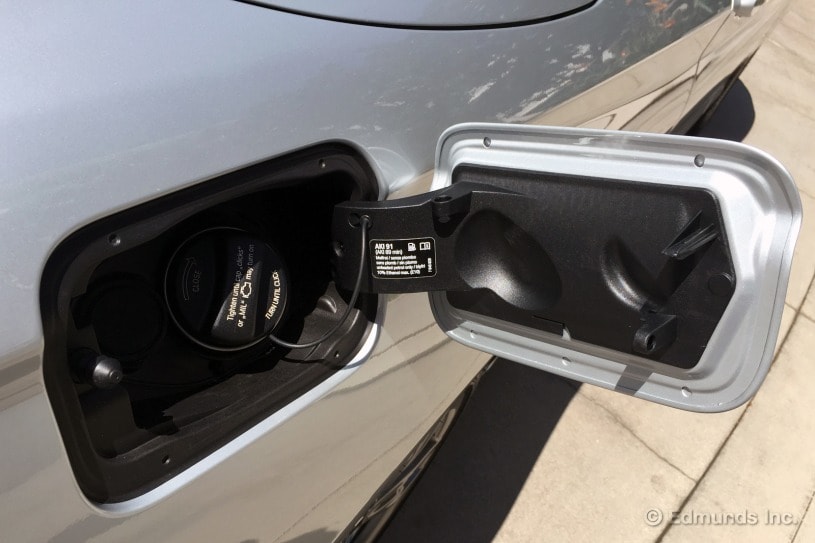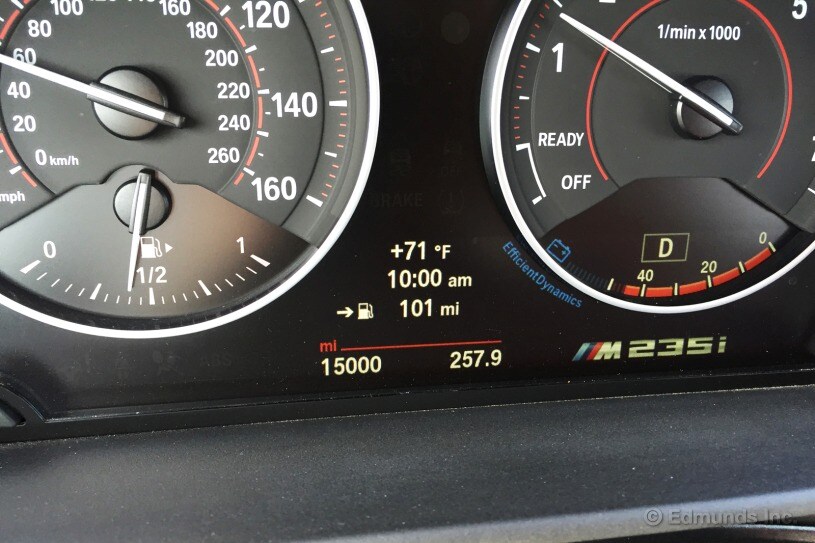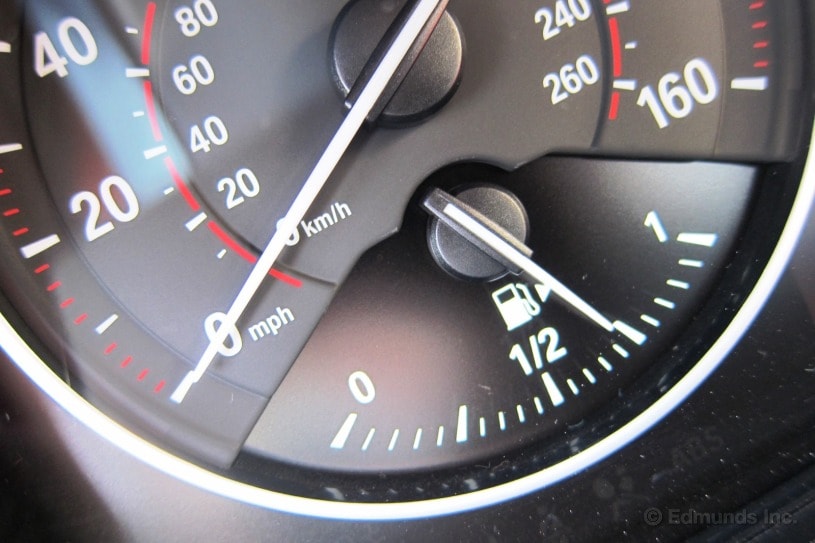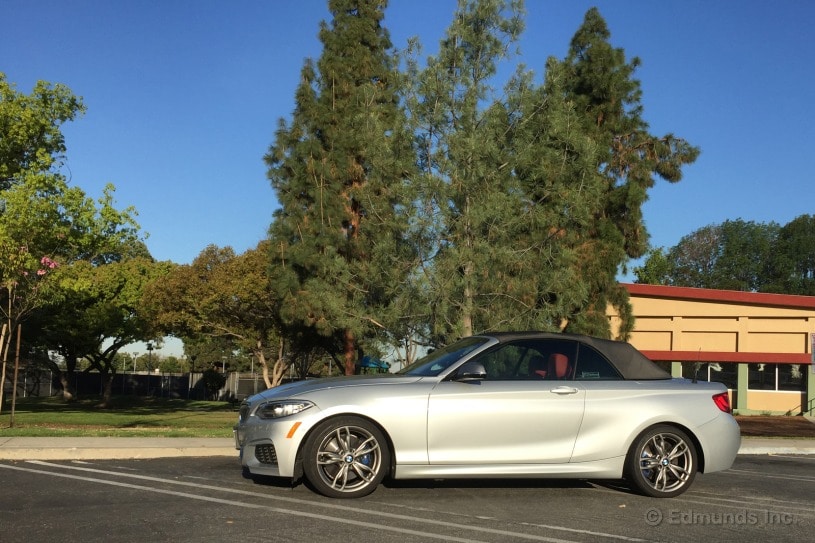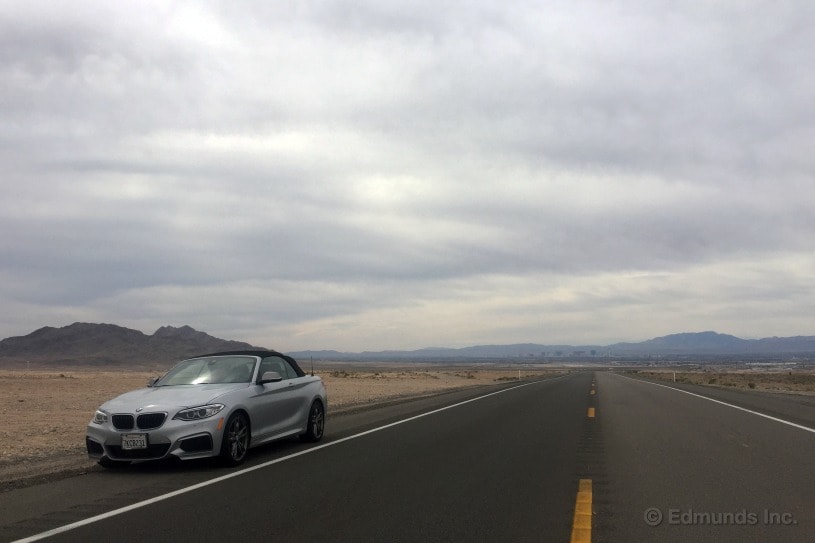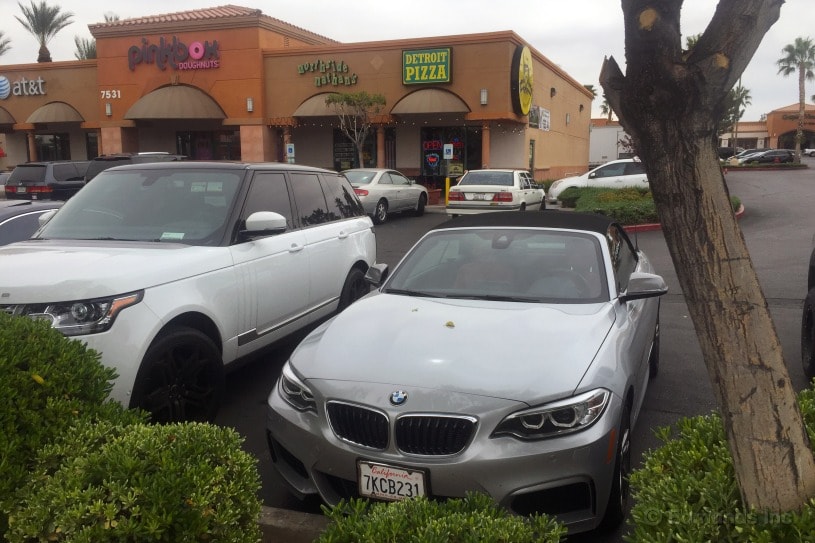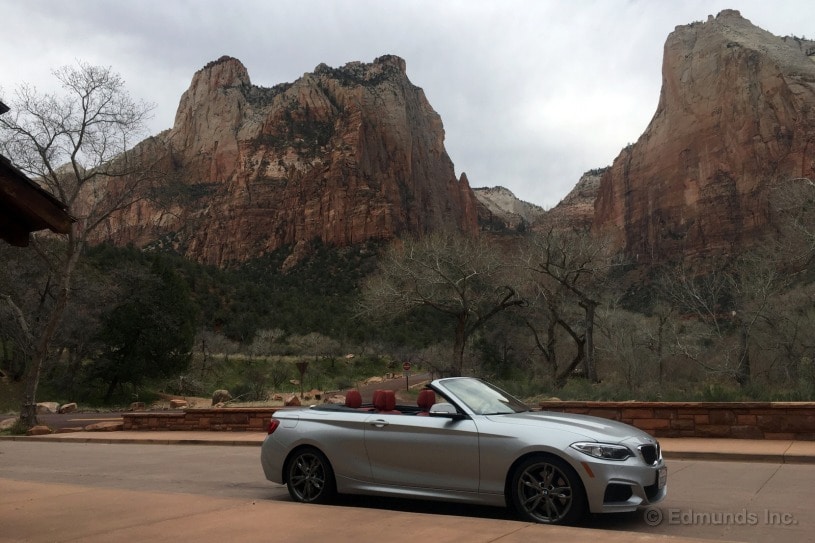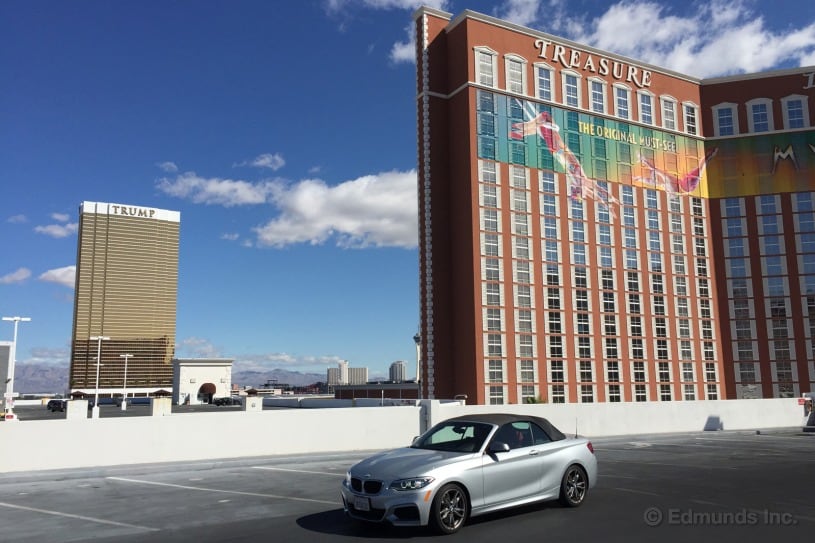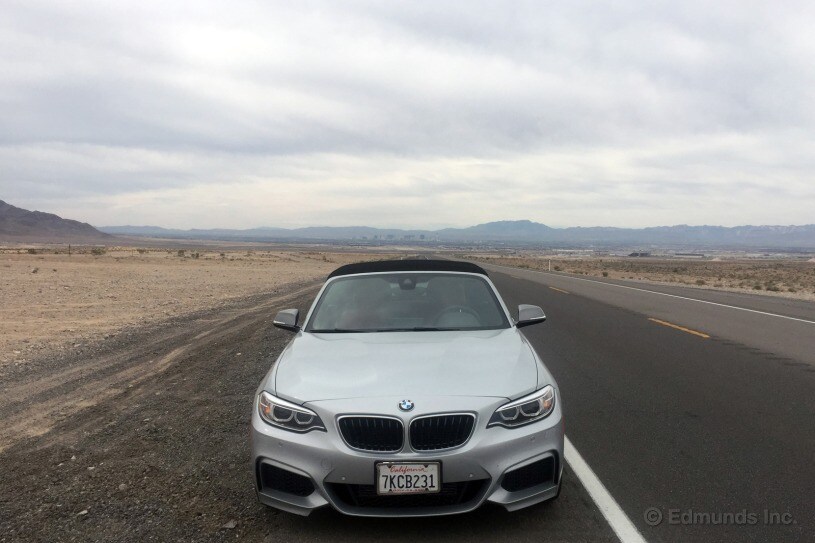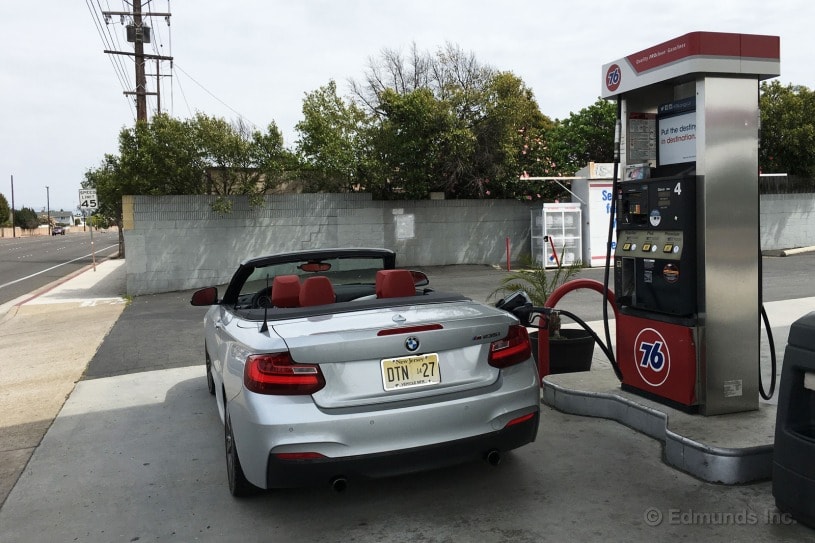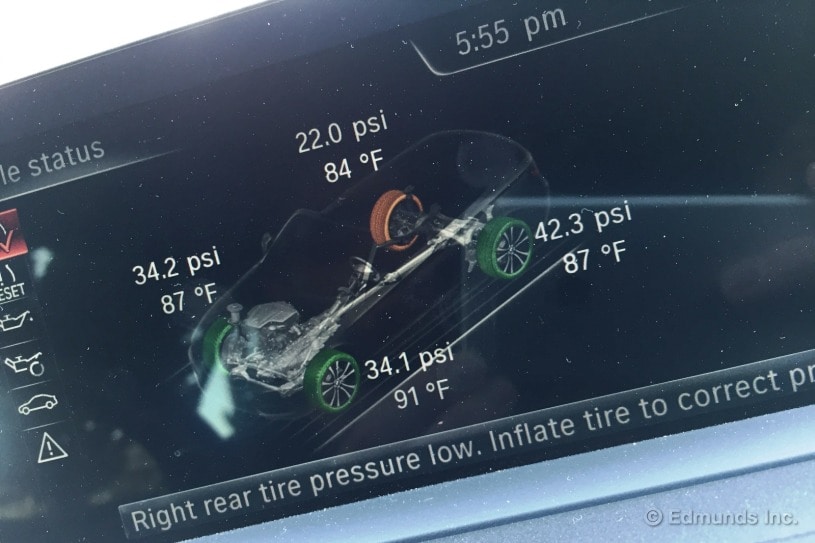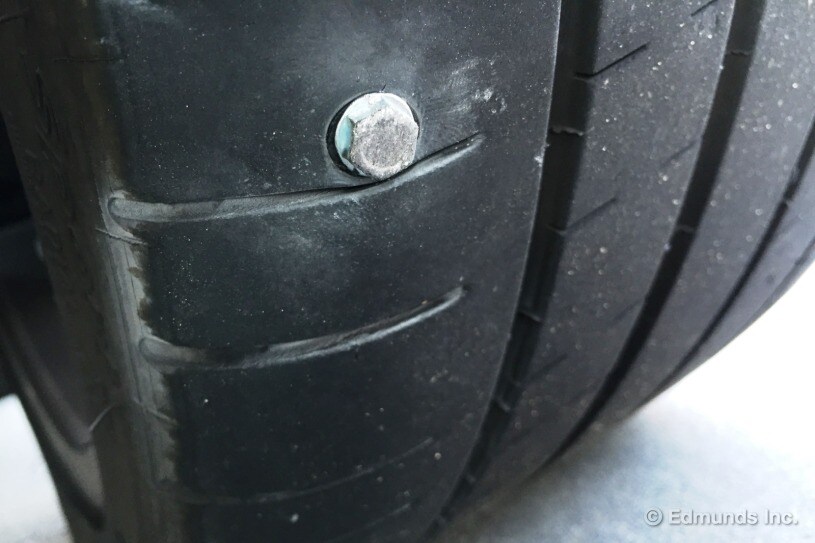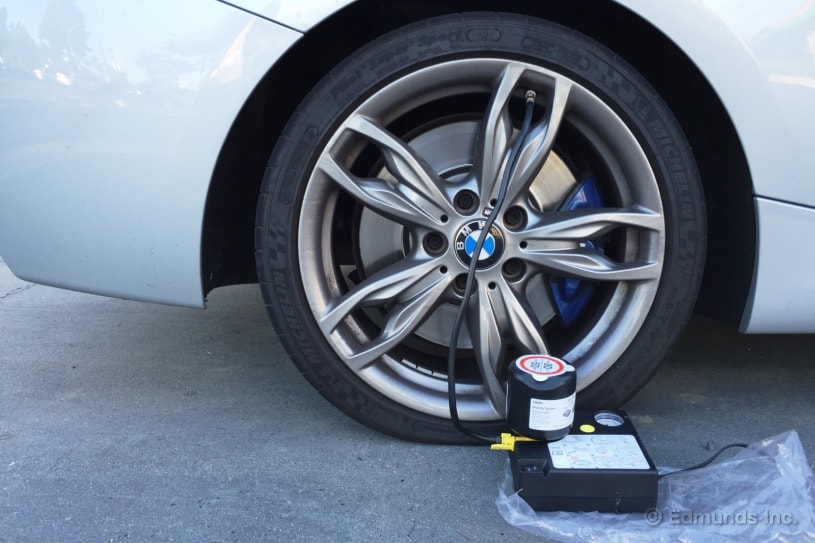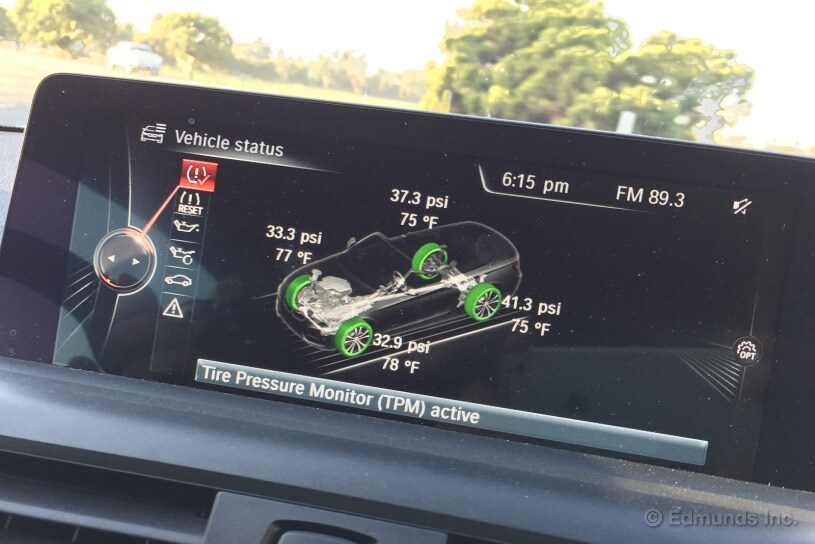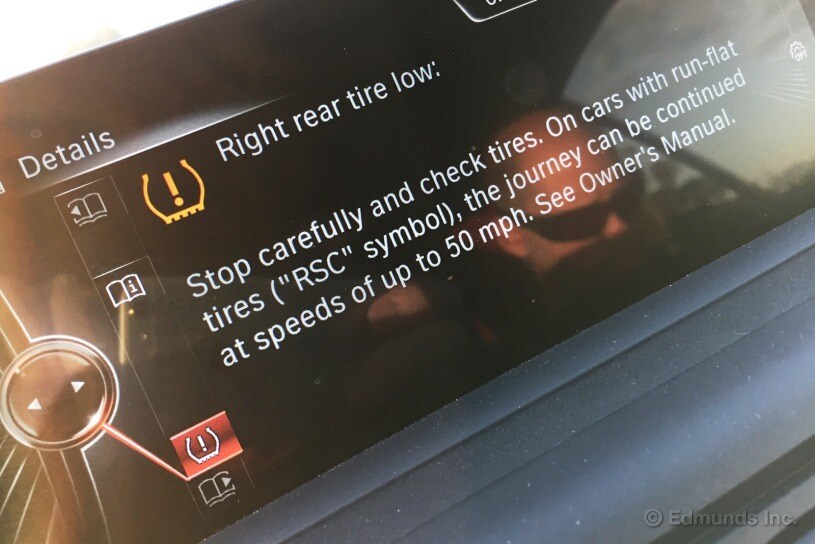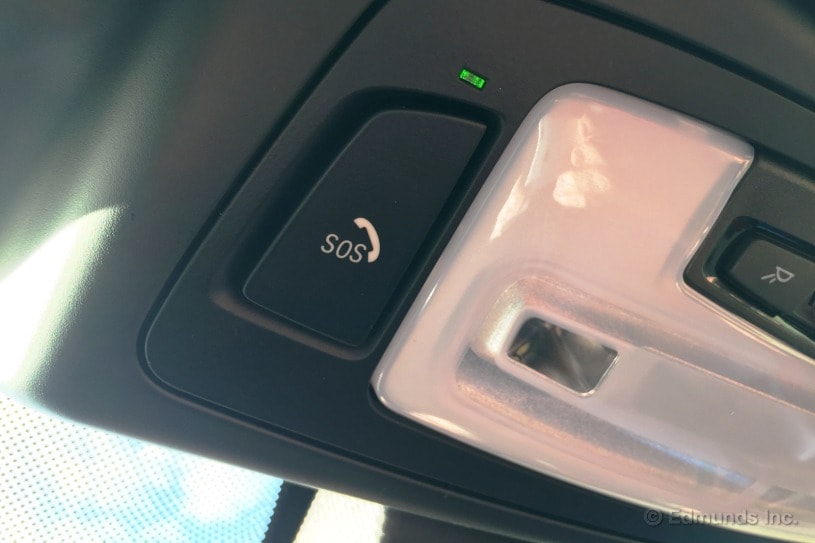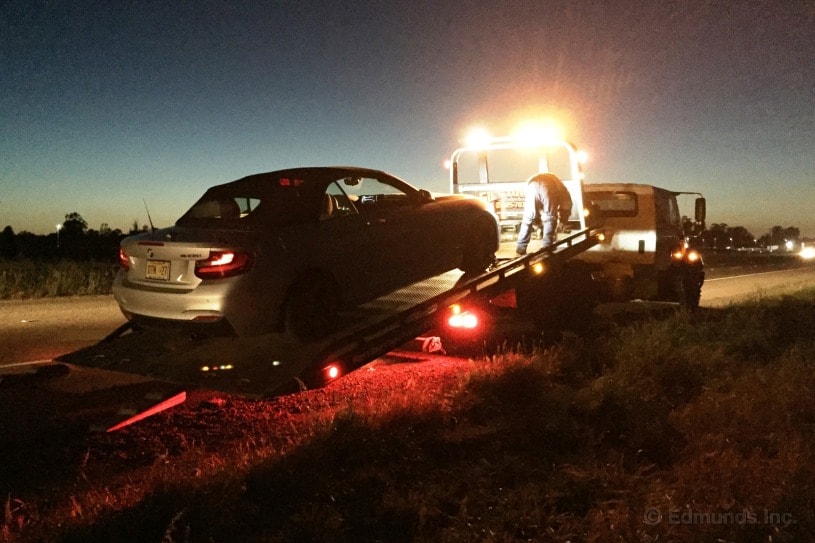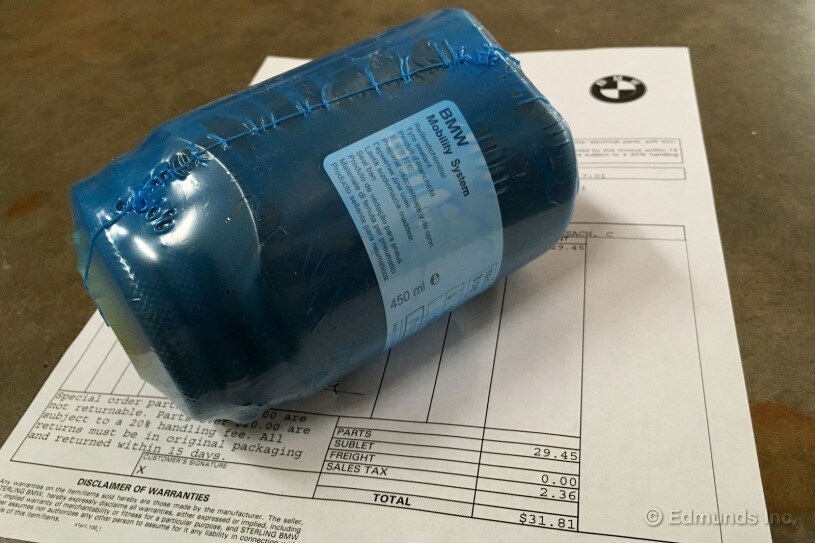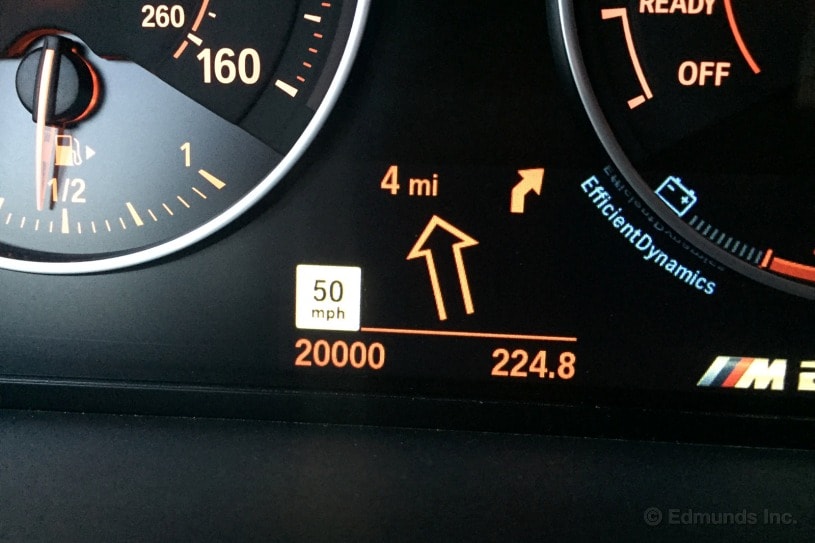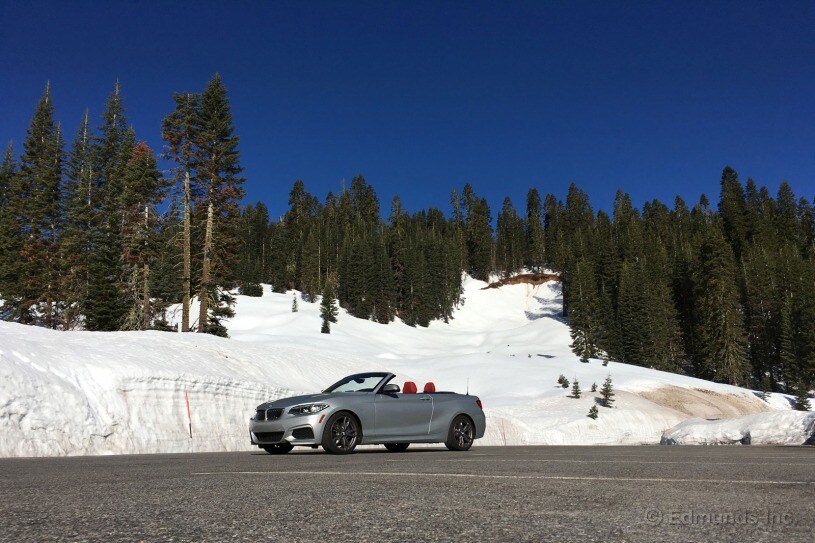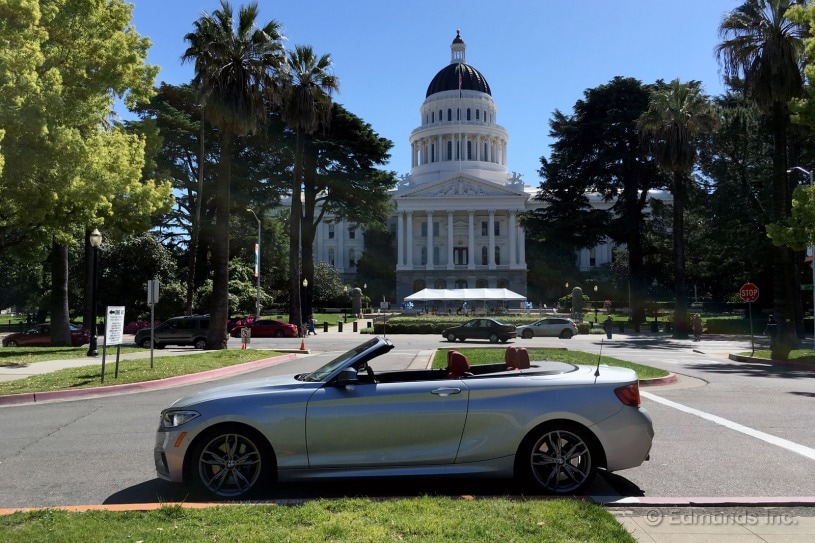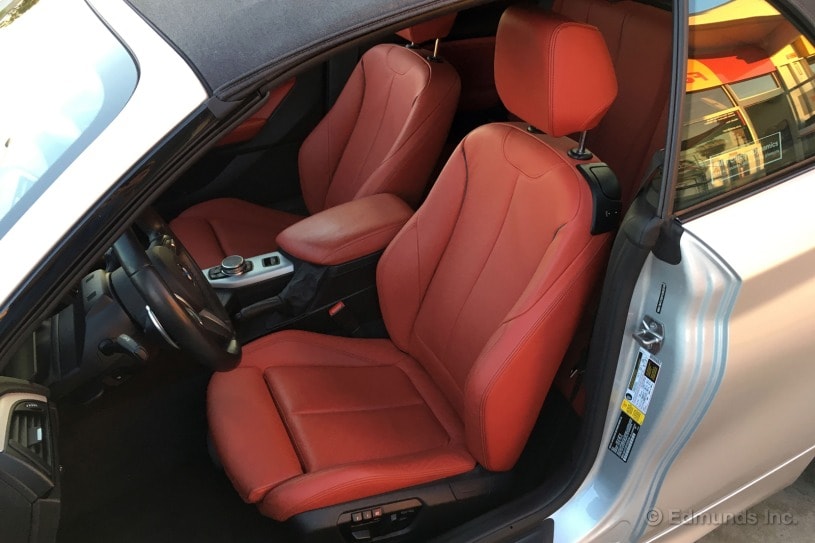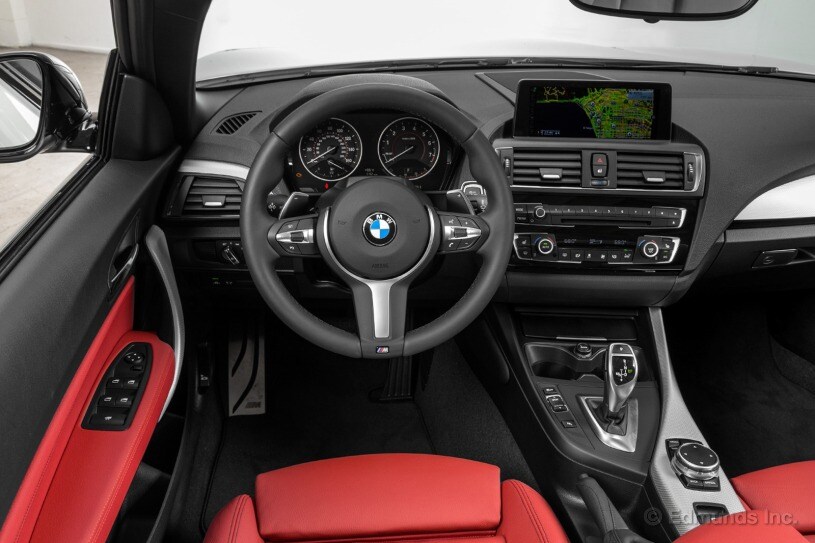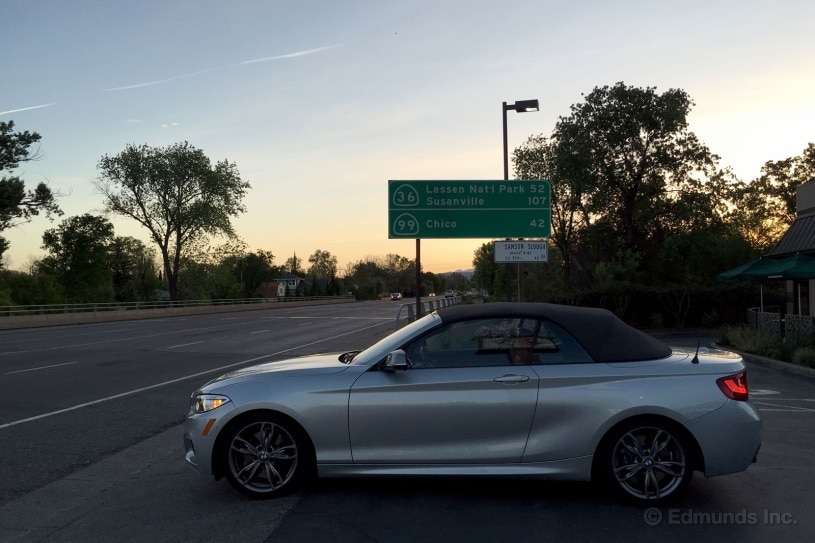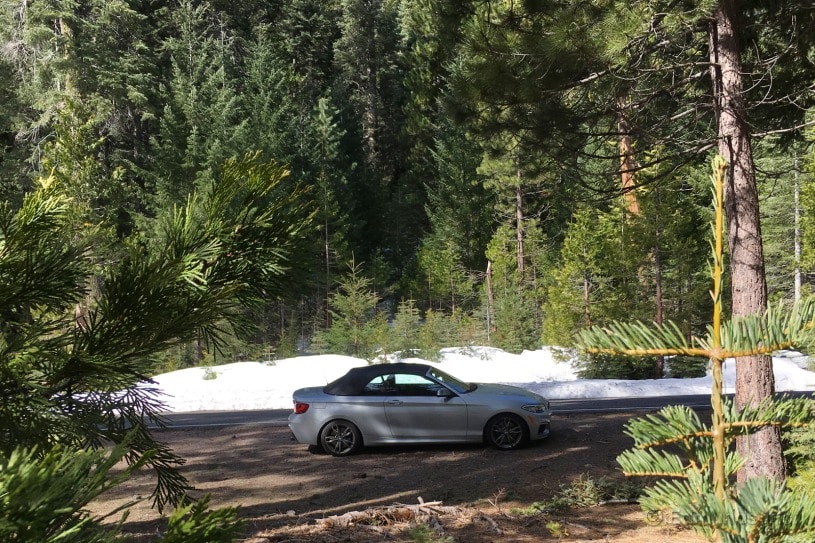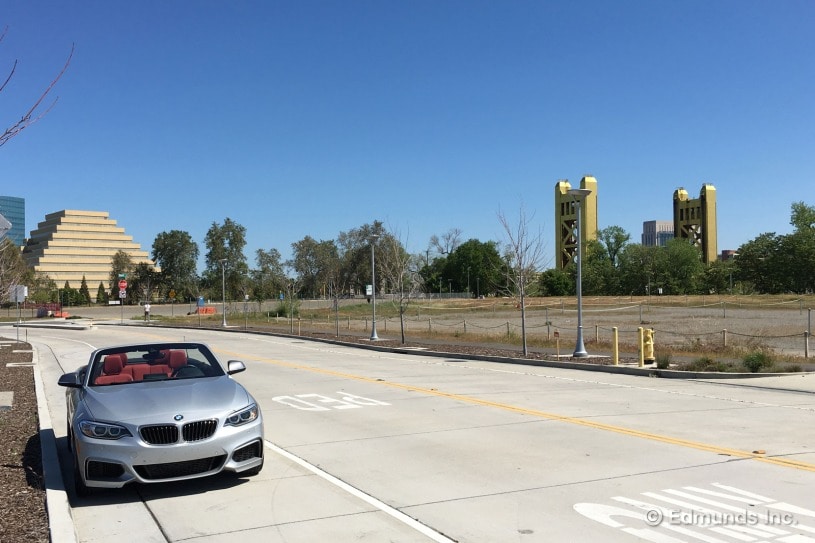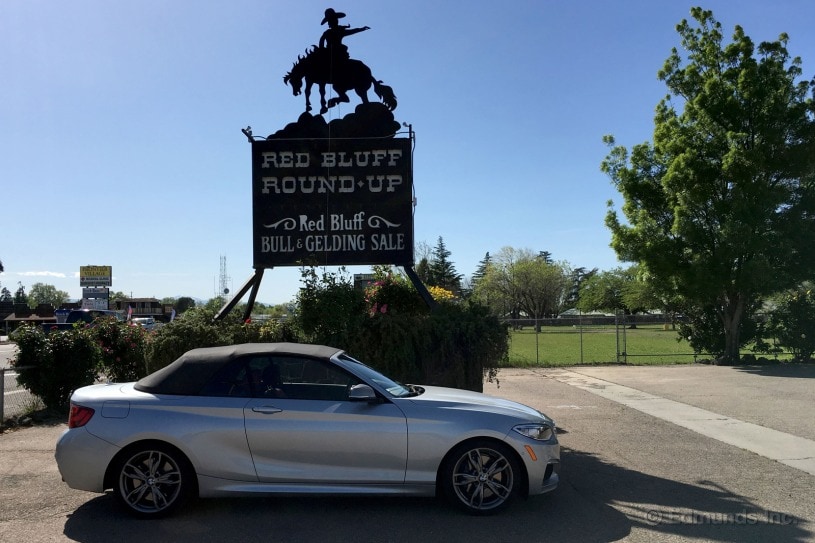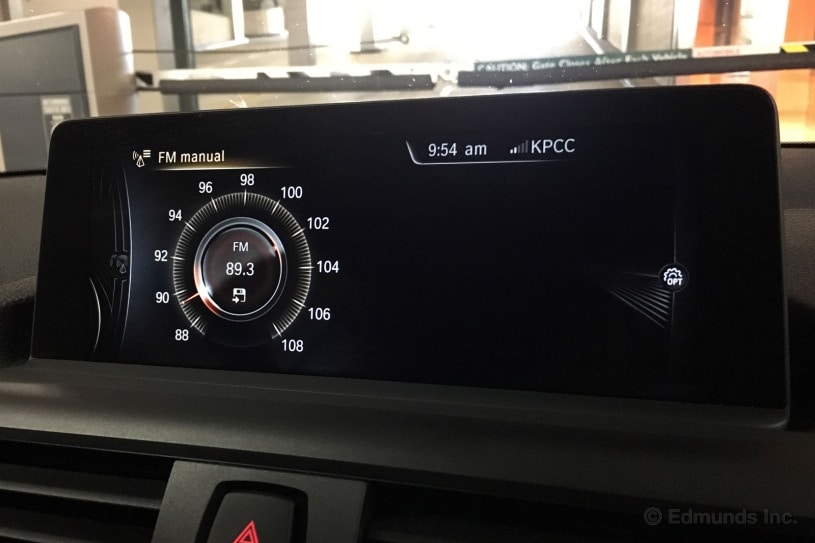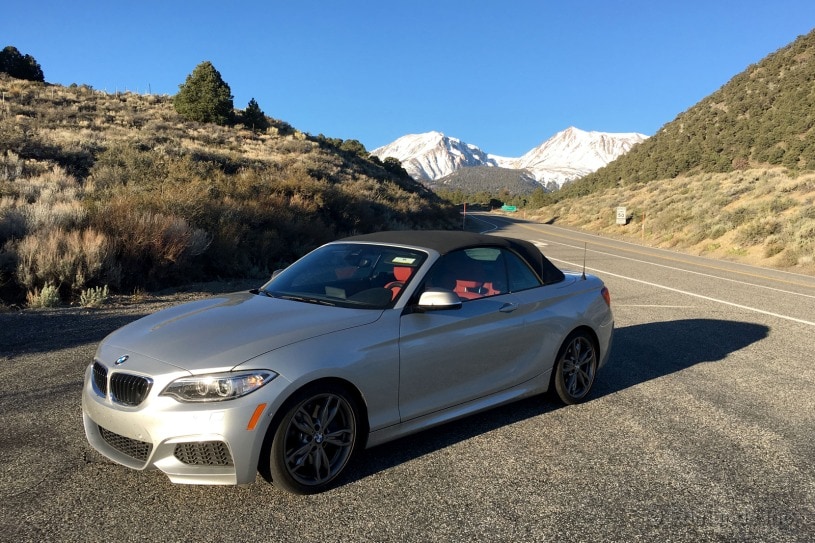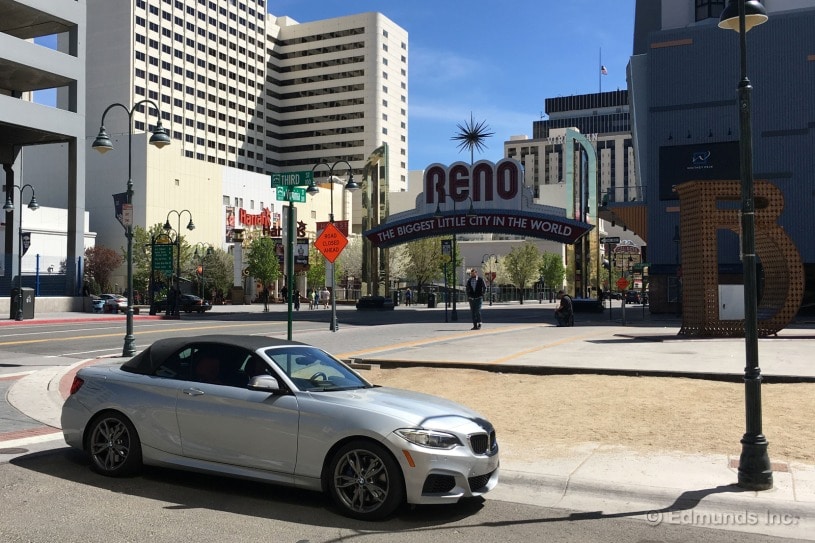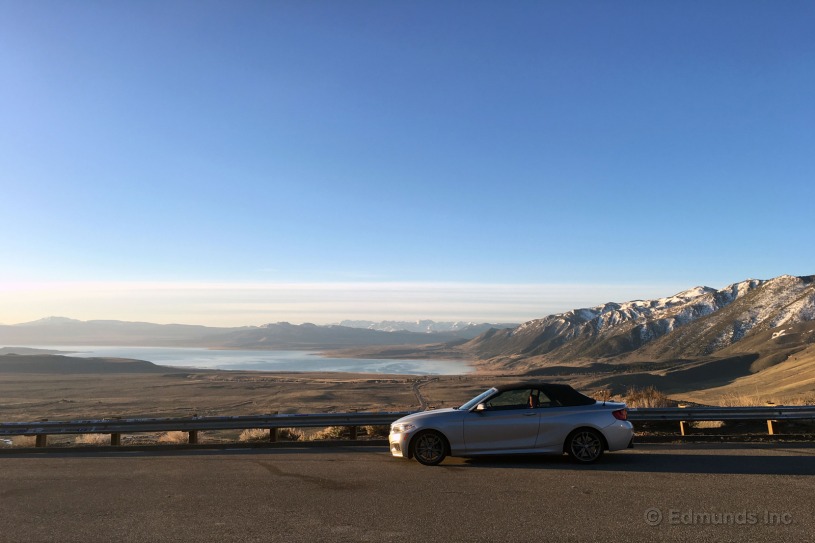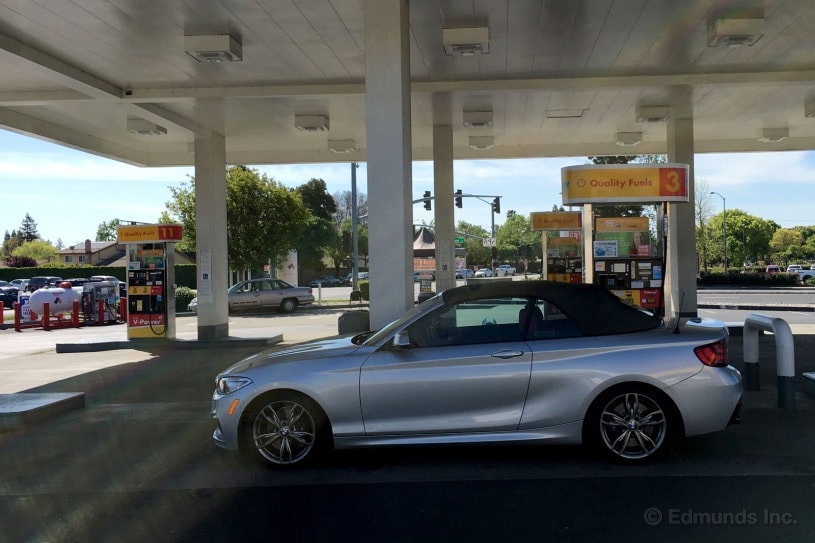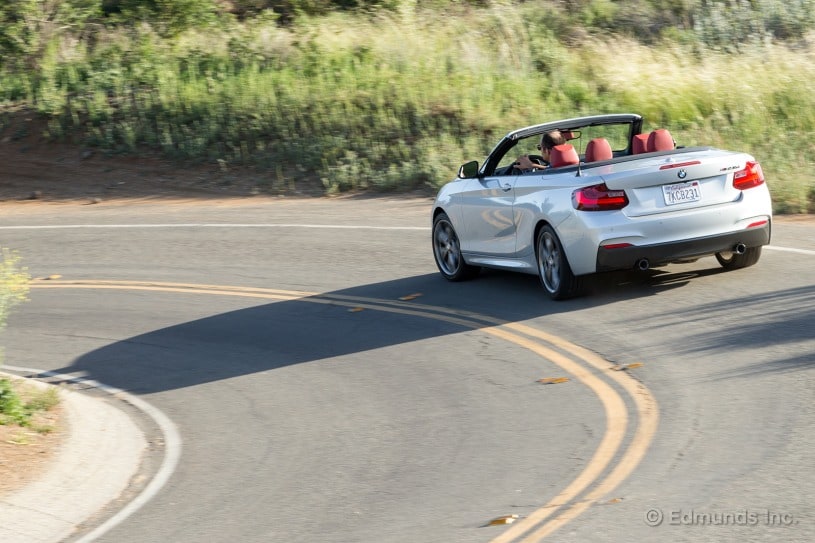2015 BMW M235i Convertible: What's It Like to Live With?
Read the latest updates in our long-term road test of the 2015 BMW M235i Convertible as our editors live with this car for a year.
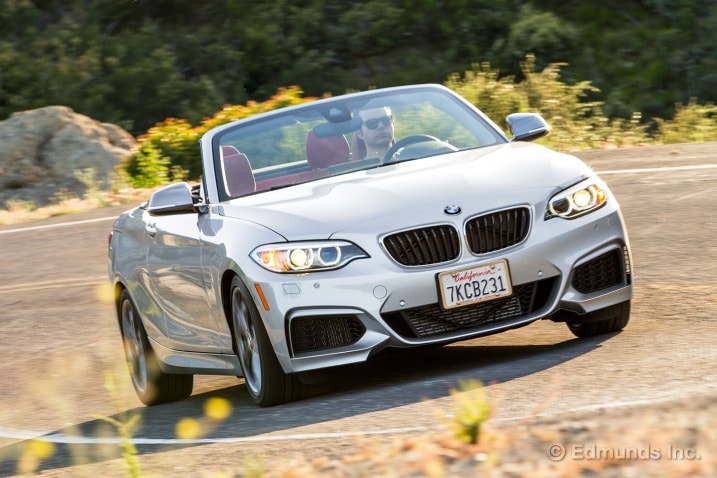
What do you want to know about?
- Introduction
- Break-In Period Requires Many Miles of Restraint
- First Chance to Test Sun-Reflecting Leather
- Hair-Saving Wind Deflector
- Best Seats in the Fleet
- One Size Fits All
- Performance-Tested — Stiff, Sharp and Committed to Going Fast
- Driven Hard at the Ring
- Five Reasons We're Psyched On the M2
- A Benchmark Powertrain
- Pony Parts Hauler
- Bluetooth Glitch
- Dog Report
- Fuel Economy Update for June - Just Getting Started
- Steering Sells BMWs
- Why You'll Want the Premium Package
- The Speedy Sunday Driver
- Tight Back Seat for Adults, But That's OK
- Stiff Structure Doesn't Ruin the Ride
- Trades Small Rear Seat for Bigger Trunk
- Fuel Economy Update for July — New Record
- Gaining Traction with DTC
- Smart Shifter Improves Driving Experience
- Understanding the Convertible Impulse
- About That Blind Spot
- Fuel Economy Update for August - Best Tank Yet Still Falls Short of Highway Rating
- Well-Insulated and Impressive Soft Top
- Six-Cylinder Smooths Out Auto Stop/Start
- Swampy Seats
- There Should Be a Door Grab Here
- The Bad Kind of Loud
- Sensitive Tire Nanny
- A Quiet One Among Performance Cars
- Busy Weekend Highlights Impressive Engine, Pushes Odometer Past 10,000 Miles
- Feels Like a Luxury Car Should
- M Designation Ruminations
- Fuel Economy Update for October: Quiet Month, Incremental Gains
- I'll Take the Audi Instead
- The One Button Every Car Needs
- Low Oil, Handy Manual
- The Case for a Practical Sports Car
- Tire Pressure Monitors Do More Than Monitor Pressures
- Going Eco Pro
- BMW Controls And The Human Brain
- The Other Benefits Of a Powerful Engine
- First Service at 12,000 Miles
- Like It, But I'd Buy a 228i Coupe and Pocket the Difference
- Split Screen Gives You Options
- Thanks for Remembering
- Clever Secondary Turn-By-Turn Display
- Heated Seats and Steering Wheel Are Smart, Lifesaving
- Fuel Economy Update for December - Achieving Combined MPG Requires the Improbable
- The Satisfaction of Cleaning Up Brake Dust
- Not So Hot Concept, But Excellent Execution
- Door Panel Disintegration
- No Need to Fear the Front Bumper Scrape
- Great Rearview Camera Screen
- Top-Down Takes a While
- Keyless, Pointless
- Mixed Opinion on Bluetooth Audio
- Sensitive Sensors
- Fuel Economy Update for January — Commuting Takes its Toll
- Still a Top Pick After 15,000 Miles
- Fuel Economy Update For February - Slight Boost in Lifetime Efficiency
- Zion Bound
- Setting Records on its First Road Trip, Part 1
- Setting Records on its First Road Trip, Part 2
- Road Trips Help Fuel Economy
- A Spare Tire Would Have Made All the Difference
- Road Trip Preview
- 20,000-Mile Update
- 1,300 Miles in Three Days
- Taking a Bow
- Wrap-Up
Introduction
What Did We Get?
It's been a couple of years since we last had a convertible in the Edmunds long-term test fleet. Now that BMW has released a drop-top version of the compact and lively 2 Series, we figured it's as good a time as any to break out the sunscreen.
Rather than settle for the 240-horsepower turbocharged four-cylinder in the already capable 228i, we opted for the six-cylinder turbo in the M235i and its 320 hp and 330 pound-feet of torque. We stuck with the standard eight-speed automatic transmission instead of the six-speed manual since it's the overwhelming choice among buyers today. Plus, it's actually quicker than the manual. BMW's xDrive all-wheel drive is available on other 2 Series models with the automatic transmission except for our M235i convertible, but we'll be just fine with rear-drive only.
Standard feature highlights for all 2 Series models include dual-zone automatic climate control, leatherette upholstery, BMW's iDrive infotainment interface and a 10-speaker audio system. Our M235i further benefits from a cloth folding roof, pop-up roll hoops, 18-inch wheels with summer tires, an adaptive suspension, variable-ratio steering, upgraded brakes, a sport exhaust and an aerodynamic body kit. Upgrades continue inside with power-adjustable sport seats, a sport steering wheel and ambient lighting.
What Options Does It Have?
Pricing for the base 228i coupe starts at $33,050. Going the convertible route bumps the price another $5,800. Graduating to the M235i Convertible kicks it up to $48,650, and the options piled on top added another $7,950.
For more cash, we added the Cold Weather package (headlight washers and heated seats and steering wheel), the Driver Assistance package (rearview camera and parking sensors), the Driver Assistance Plus package (lane departure warning and speed limit display) and the Technology package (navigation, emergency telematics, real-time traffic, an updated instrument cluster and in-car apps). Stand-alone options include the Glacier Silver Metallic paint, Dakota Red leather upholstery, automatic parking system, enhanced Bluetooth connectivity and BMW Concierge Services.
This brings the as-tested price to a choking $56,600, which is a stone's throw away from a fully loaded price of $58,625. All we're missing is the Premium package (auto-dimming mirrors, keyless entry and ignition, satellite radio and a garage door opener), the Harman Kardon premium audio, an anti-theft alarm and automatic high beams.
Why We Got It
Entry-level luxury cars are hot right now, and the 2 Series is BMW's least expensive model. It'll be a good comparison to our current Audi A3 and previous Mercedes-Benz CLA250. Sure, we could have gone the sensible route with a 228i, but we already have enough experience with that engine thanks to our long-term 328i Gran Turismo. Our generously optioned M235i will also allow us to evaluate all of the bells and whistles.
Why a convertible? Well, with Edmunds headquartered in sunny Santa Monica, California, why not? Some of us are looking a little pale, so this ought to restore our youthful glow. Follow along for the next 12 months to see if the 2015 BMW M235i Convertible meets our expectations and how it holds up against its rivals.
EPA estimated fuel economy: 25 mpg combined (21 city/32 highway)
Best MPG: 17.7
Worst MPG: 16.3
Average MPG over 190 miles: 17.2
The manufacturer provided Edmunds with this vehicle for the purpose of evaluation.
I was genuinely excited when the sign-out sheet came around and our newest long-termer, the 2015 BMW M235i, was still available. I drove a hard-top M235i a while back and truly loved the experience. It had sharp, direct steering and a fantastic feel for the road, both of which I was anxious to experience again. Sadly, I couldn't really put our new convertible through its paces since we're still in the break-in period. It's a long one, too.
According to the owner's manual, we need to keep the M235i's inline-6 below 4,500 rpm for the first 1,200 miles. It also instructs us to stay below 100 miles per hour and to "avoid full load or kickdown under all circumstances." Keeping it below 100 mph isn't a problem, but avoiding full load or kickdown meant keeping a light foot all weekend.
Other instructions include driving conservatively for the first 200 miles to help the tires achieve "full traction potential" and driving "moderately" during the first 300 miles to achieve "optimal performance between brake discs and brake pads."
We see a road trip in the BMW's near future so we can take off the training wheels and see what the car is really like.
We've had a great many long-term BMWs during my eight-plus years at Edmunds, but our 2015 BMW M235i is the first convertible. That means we've never had a chance to try a feature that has intrigued me since it was introduced for the last-generation 3 Series convertible: sun-reflective leather.
According to BMW, a special sun-reflecting pigment is applied during the treatment of the leather that can keep the seats and steering wheel as much as 77 degrees cooler. This temperature swing is dependent on weather/sun conditions as well as the seat color. An Oyster cream-colored seat will forever be cooler than a black one, with our Coral Red seats somewhere in between.
During the next year, it would be nice to come up with some test to observe how well this sun-reflective stuff actually works. Of course, with a fully-powered roof that raises in 20 seconds and at speeds of up to 30 mph, I'm not really sure why you'd park with the roof down anyway. For, if you're sitting on the seat, the sun-reflective pigment isn't really doing much and I'm guessing that seat ventilation would ultimately be more appreciated on a hot day.
There are definite cons to driving a convertible. One is a sunburn, another is fussed hair. Donning a hat can be a solution to both, but with time can also cause the dreaded hat hair. Or perhaps you'd like the feel of a light breeze in your hair, but would rather not resemble Diana Ross upon arrival. While clouds or the roof can fix the sun issue, our 2015 BMW M235i's wind deflector can take care of the, well, wind.
Enclosed in a fabric bag, the wind deflector folds up to roughly the size of a pizza box and can live in the surprisingly spacious (for a convertible) trunk. To affix it, you unfold it and plug the longer bit into the round plugs behind the front seats. You then turn the knobs to fit the rear section into its plugs. That's it.
Raising and lowering the deflector is easily accomplished while moving and can remain in place even when the roof is raised. And really, why not, considering that the back seat is barely habitable?
As for its performance, the wind deflector successfully eliminates the breeze that swirls from behind, preventing annoying ear wind and unfortunate cow licks. Raising the side windows (there is a button that can raise or lower all at once) further reduces the side wind, leaving the desired light breeze even at highway speeds. Female companions may not even need that otherwise requisite hair tie.
This wind deflector isn't quite as impressive as the fully-powered one in our former long-term Porsche 911 Cabriolet, but it's nevertheless a very useful and well-executed feature. After all, who likes fussed hair?
The seats in our Volvo have received praise here. And they're fine if you like firm seats with minimal adjustments, rigid bolsters, stiff leather, no thigh support and a headrest that's constantly punching you in the brain stem.
The seats in our 2015 BMW M235i have none of these downsides and are my new favorite seats in the fleet. By far.
First off, look at the seat bottom. See that thing sticking out? Adjustable thigh support! My favorite feature in the world right now and the BMW has it. The Volvo has a short seat bottom that doesn't sit back far enough.
The M235i's seats also have — get this — adjustable bolsters, because not everyone wants their kidneys squished all of the time. BMW also makes allowances for people with heads as the headrests here are adjustable too.
Finally, the seating position is near-perfect. It's low enough that I feel like I'm in the car, but not so low that it hampers ingress/egress. When seated, the reach to the pedals is fantastic and the wheel telescopes where you need it. Oh, and they're heated.
If BMW ever gets tired of being in the whole-car business, they could make a killing just building and selling seats. If I ever have to drive the Volvo again, I'm going to swap in the seats from the 235i.
I am height-challenged in the sense that my gawky, 6-foot 4-inch frame makes it difficult to fit perfectly in many compacts and sports cars. Imagine my delight when I climbed into our 2015 BMW M235i for the first time to find that the small convertible offered plenty of room to stretch my legs. Even better is the ample head room afforded by a tall roof and adjustable seat bottom.
I'm not the only one surprised by the M235is unexpected amount of driver space.
That's Senior Editor of Retail Experience, Matt Jones, sitting shotgun in the above photo. Matt's built like a 9/10-scale version of actor Vinnie Jones and is good-natured enough to have once squeezed himself into an Alfa Romeo 4C for my amusement. Hoping to witness more gymnastic futility, I invited him to examine the BMW soon after it arrived at our office. To my shock, he climbed in without any sort of bodily contortion. Even the prominent side bolsters in the standard M Sport seat presented no problem for Matt.
We know from our time in the 2014 BMW 328i xDrive Gran Turismo that BMW's seats are highly adjustable and the bottoms can drop considerably. Combined with the soft top's high ceiling, the M235i has plenty of room for people my size and possibly a few inches taller. It is spacious enough that I wouldn't even have to consider a 4 Series.
Our 2015 BMW M235i convertible packs a wallop worthy of the tri-colored M badge. This new model has a turbocharged 3.0-liter inline six-cylinder engine that generates 322 horsepower and 332 pound-feet of torque. It has an eight-speed automatic transmission and is driven by the rear wheels.
The convertible is about 300 pounds heavier than the 2014 coupe we tested last year, but it's just as willing to attack corners and deliver a thrilling driving experience. Read on for our instrumented performance numbers gathered at the test track.
Vehicle: 2015 BMW M235i Convertible
Odometer: 1,279
Date: 5/5/2015
Driver: Josh Jacquot and Mike Monticello
Price: $56,500
Specifications:
Drive Type: Rear-wheel drive
Transmission Type: 8-speed automatic
Engine Type: Turbocharged inline-6
Displacement (cc/cu-in): 2,979 / 182
Redline (rpm): 7,000
Horsepower (hp @ rpm): 322 @ 5,800
Torque (lb-ft @ rpm): 332 @ 1,400
Brake Type (front): One-piece ventilated disc with four-piston fixed calipers
Brake Type (rear): One-piece ventilated disc with dual-piston fixed calipers
Suspension Type (front): MacPherson strut with dual lower ball joints
Suspension Type (rear): Independent multilink
Tire Size (front): 225/40ZR18 88Y
Tire Size (rear): 245/35ZR18 92Y
Tire Brand: Michelin Tire Model: Pilot Super Sport
Tire Type: Asymmetrical, summer
As-Tested Curb Weight (lb): 3,789
Test Results
Acceleration:
0-30 (sec): 2.0 (w/ Traction Control on: 2.2)
0-45 (sec): 3.2 (w/ TC on: 3.5)
0-60 (sec): 4.8 (w/TC on: 5.3)
0-60 with 1-ft Rollout (sec): 4.6 (w/TC on: 5.0)
0-75 (sec): 6.9 (w/TC on: 7.5)
1/4-Mile (sec @ mph): 13.1 @ 105.1 (w/TC on: 13.5 @ 103.2)
Braking:
30-0 (ft): 26
60-0 (ft): 104
Handling:
Slalom (mph): 71.3 (69.3 w/ESC on)
Skid Pad Lateral acceleration (g): 0.93 (0.93 w/ESC on)
RPM @ 70: 2,000
Comments
Acceleration: The super-smooth engine has plenty of power everywhere and loves to rev. The car gets off the line with minimal hesitation and then revs hard to its upshift point. Shifts are quick yet smooth.
The launch control system is a bit odd: It seems more like power-braking (overlapping gas and brake pedals at the line to bring the revs up), as the car wants to creep forward and it doesn't allow the revs to rise very much as most systems do. You know you're in "launch control" when a display lights up on the instrument panel. Also, it was finicky. Sometimes it would get way too much wheelspin, other times it wouldn't get any. All of this leads me to believe it's a launch control system in name only.
Still, our quickest run did come with "launch control" in Sport Plus mode with traction control off. I think we lucked into the right amount of wheelspin. Our next-quickest run was with the car in Sport Plus mode, transmission in Sport, stability control fully turned off, and using power-braking. We got very little wheelspin on that run, but the transmission went into some kind of quick-shift mode, with much more abrupt upshifts. Still, it was three-tenths slower to 60 than the coupe version we last tested, although this convertible is almost 300 pounds heavier. Manual shifting is via steering wheel paddles or the console lever (push forward for downshifts). It blips the throttle on downshifts and will hold gears to a 7,300-rpm limiter.
Braking: The M235i exhibits excellent braking abilities. Pedal was firm with short travel and hardly any ABS noise was heard. Exhibited minimal nosedive and the car stayed perfectly straight on every run with hardly any brake pad odor by the final stop. Braking distances were minimal thanks to zero pedal fade.
The first stop was the shortest at 104 feet, the fourth stop the longest at 107 feet and the sixth and final stop was 106 feet. Overall, braking is a stable, secure and confidence-inspiring experience.
Handling Slalom: This is a real driver's car with sporting intentions that become more obvious the further you dial up its drive modes. In Sport Plus, it's stiff and sharp and wholly committed to the task of going fast. In this mode, ESC is marginalized until it's desperately needed. And it's stiff enough that more compliance is needed on an imperfect surface. Plus, it'll lay down a very respectable slalom speed without much hassle. The car is capable and fast in rapid transitions.
Handling Skidpad: The BMW has lots of grip and relatively heavy steering effort. It's a bit of job to wrestle the M235i around the skid pad, but it's clearly capable and impressive as a driver's car. It doesn't step out under power very easily, but would rather stick and turn.
The 2015 BMW M235i makes really nice sounds. Its inline-six burble and purr is even better enjoyed with the top down on a bright, warm California day. Haters gonna hate, but I'm glad we got the ragtop. What we lose in structural rigidity, we gain in driving experience. At least that's the story I'm selling myself.
But if you want to hear an M235i driven in all its angry, tenor, production-model glory, with a little turbo whine backing harmony, check out this video:
This in-car video is taken from a driver in the M235i Racing Cup class at the 2014 Nurburgring 24 Hours. This privateer is ostensibly sponsored by RaceChrono, an Android-based lap-timing, data-logging and analysis software package that integrates with GoPro video.
This class and companion Belgian-based one-make series uses production M235i's that are very much like ours. Except with a fixed roof, stripped interior, roll cage, stiffer suspension, and better brakes. Pretty much the same really. Same engine and transmission anyway.
As you might glean from the YouTube title, the driver ends up punting it, but it's hard to fault him. You'd probably be flat-out too if you had SLSs, 911s, R8s and Aston Martins opening wide gaps in front of you. Until they weren't.
Start at around 21: 00 to watch the whole thing begin to unfold or just watch from the beginning and enjoy the audio.
As may be obvious from the title, this isn't about the 2015 BMW M235i in the Edmunds long-term fleet. Instead this is a musing about the next 2 Series that will join the fleet, or so say some of the staff editors. I sense they're slightly delusional; the beads of drool that collect at the corner of their mouths when they talk about the M2 seems like a dead giveaway.
But carried along in their rapture, I worked out some reasons why everyone should be excited about the forthcoming M2.
It's a Smaller, Lighter M car
Every iteration of the BMW 3 Series is larger than its predecessor. The current F30 generation 3 Series is nearly as large as the E39 5 Series sold from 1997 to 2003. This leaves plenty of room below the 3 Series lineup for something a bit nearer to the original M3. The 2 Series is close to the same size as those much-loved older 3 Series cars, and an M2 should appeal to enthusiasts who feel the M3/M4 twins have grown too big and heavy.
We Loved the 1 Series M Coupe
The 1 Series M Coupe (shown above) sold only for the 2011 model year, was a parts-bin car that took the suspension, steering and brakes from the E92 M3 and stuck them under a 135is chassis. The body was widened due to the increased track, and the 3.0-liter inline six-cylinder's output was raised to 335 horsepower. That power might seem modest compared to the M3, but in a car that weighed several hundred pounds less, it was plenty. The 1 Series M Coupe was equally at home on the track or on the street. BMW imported only 1,000 cars and prices on used ones can exceed the cost of the car when it was new.
It's a (Semi) Affordable M car
The base price on an M4 is $64,200. Adding options can push that price closer to $90,000, out of the range of most shoppers. The M2 would have to start for far less than that, splitting the difference between the M235i and the M4, and putting in within reach of many more shoppers. This starting price would also pit the M2 against the Mercedes-Benz CLA45 AMG and forthcoming Audi RS3.
It's a True M car
In the past few years, BMW has tried hard to stretch the M badge across as many products as they can. Currently, there are three flavors: M Sport, M Performance and full-fledged M. While the first two packages might feature parts from full M cars, they lack the comprehensive performance approach that models like the M3/M5 offer compared to the tamer standard versions. An M2 would have a reworked engine, suspension, brakes and bodywork that incorporates more exotic materials like carbon fiber, aluminum and magnesium.
In This Case, More is Better
More competition for Mercedes-Benz and Audi is a good thing, driving all companies to improve their cars. More choices for performance-minded drivers are also always a good thing. And getting more out of the 2 Series, a car we're fond of in its standard guise, has the potential for something great.
Our long-term 2015 BMW M235i has a powertrain that works. I don't mean "works" as in "is functional," but as in "the operation of which was obviously fussed over by people who know what they're doing."
The M235i's 3.0-liter turbocharged and direct-injected inline six-cylinder is not new. This engine family ostensibly started life as the N54, a twin-turbo mill, then transmogrified into the single-turbo, Valvetronic-havin' N55. Yet despite its tooth length, it's just so darned good.
But it's not without some character flaws.
First, the good. With this engine, you get its creamy smooth inline-6-ness which, if you've never experienced, there's really something to it. It's a trait unique to this configuration, much as flat-sixes sound like a ripsaw, and crossplane V8s go lub-lub-lub. Now imagine that straight-six sewing machine characteristic mated to a seriously stout — and broad — torque curve.
Wait, that's too clinical. Try this: the M235i freakin' rips. I unceremoniously laid into the right pedal near the end of a 15-minute drive with two jaded car nerds aboard and both uttered words to the effect of, "Dang! What's this thing powered by again? Dang!"
It sounds great, too. Well, it sounds great at full whack. Really great. Mostly intake honk, a little exhaust, and the only time you hear the turbos is when the compressor bypass valves do their muted sigh during gear changes or when you lift suddenly. At part-throttle, it just sounds good.
Let me reiterate. This is a fast car, and the ZF 8-speed gearbox is complicit to the M235i's sense of urgency, particularly when you select 'Sport' via the little rocker on the console. When you do so, gear changes speed up, downshifts are rev-matched, throttle gain increases, and the transmission shift schedule gets more enthusiastic about holding gears and downshifting.
It's all good stuff, but none of those words really do justice to just how refined this transmission is. It's calibrated so well. The way it takes up from low revs with so little torque converter slop, minimal shift shock (looking at you, Chrysler nine-speed) and just plain crispness. Eight gears are probably too many when you've got an engine with this much torque, but it works better than expected.
I do have a couple of beefs with the M235i's engine, though — more specifically, its throttle calibration. There's a distinct throttle lag when you tip in from zero throttle, whether from a standstill or from a roll. It's not turbo lag. It's a bit of absolutely nothing, while the Congressional committee inside the ECU bickers amongst themselves, debating how much torque you requested a split-second ago (are they using an abacus? A Speak-n-Spell?).
It then opens the throttle to a degree commensurate to that torque request, but in the meantime, you've dipped the pedal even further. And because it's Congress and nothing happens until the committee implements an emergency deadline measure, ultimately you leave the line looking like it was your first time driving a car, ever. So BMW, fix your stupid throttle response.
My other issue is with its stop-start function. It's woefully abrupt during stops. Mainly because it stops the engine before you've actually reached a halt, which makes for a very lurchy stop about three-quarters of the time and, again, makes it appear to your passengers as if it's the first time you've driven a car. Ever. The restarts are smoother, though not particularly hurried.
The elastic throttle response is more irritating than the stop-start thing, but on balance I have to imagine other manufacturers, while benchmarking the N55, wonder how on earth they're going to top the way this engine just oozes competence.
We needed to pick up four new tires for our long-term Ford Mustang GT but the only car available at the time was our 2015 BMW M235i. It seemed like a good impromptu test of the BMW's cargo capacity.
The Pirelli PZeros were sized 255/40ZR19 up front and 275/40ZR19 in the rear. At a glance we thought one of the fronts might fit into the M235i's trunk. The lowered convertible top tucks into a compartment slightly recessed from the top lip of the trunk opening.
But it hung just low enough to deny the Mustang tire entry. It was so close that we think a front M235i tire (225/40ZR18) may fit, but that was not on the agenda today. So we opted for the path of least resistance.
We dropped the BMW's top and tossed the tires inside. It was really the easiest way to do this. Our only concern was the tires rubbing on the red seat leather. But we loaded them carefully and drove cautiously for 1.5 miles to the office. Everything was fine. We may have just found a new test fleet tire hauler.
Our 2015 BMW M235i convertible is displaying a peculiar and intermittent Bluetooth problem. Without warning it disconnects phone calls. Or so it seems.
It sounds like the call drops completely. No more voice through the speakers. The radio turns back on. And that's when it happens. The radio mutes once again and the call resumes. It's all over in a few seconds. We've experienced the issue twice now. So far it's only occurred using an iPhone but we have a feeling that has little to do with it.
We'll see what the dealer has to say about it next visit.
Our long-term 2015 BMW M235i isn't ideal for medium-size senior dogs. I learned this when I took my 11-year-old pitbull Mya to my folks' place for Father's Day.
Since Mya is an old girl she's always uncomfortable, always groaning. She can't jump anymore so we bought her a dog ramp to get in and out of tall cars. But since our M235i was low enough, that shouldn't have been an issue.
What became an issue, however, was that the two-door configuration didn't give her the wide berth she needed to feel comfortable clambering in or out. The front seat only moves forward so much and even with the seat tilted forward, she was skeptical of how to get out (see above photo).
Smaller and younger dogs won't have an issue, I imagine. That center cupholder also made it uncomfortable for Mya to stretch out. During the 50-minute ride, she kept fidgeting and finally just sat up and stared hopefully out the window, waiting until we reached our destination. Small dogs can just curl up in one seat.
But at least there were rear-seat vents that were at "sleeping dog" face level, especially crucial that weekend when temperatures hit the high-90s.
Our 2015 BMW M235i served light-duty commuting duties through most of June. No road trips, no track romps, no long-distance cruising (although we did pull a very good tank comprised of some long highway commutes). Instead we used it for the fairly blue-collar task of hauling new Mustang tires, driving the dog around (Mya was not impressed) and waxing on the really, really nice powertrain.
We still managed to add almost 1,600 miles though, and observed one tank that returned 25.5 mpg after 311 miles. That's our second best-fill so far and maybe a more legitimate result than the standing record of 25.7 mpg, achieved with just 123.6 trip miles back in April.
June is the first month we actually put some real miles on the car. We started driving it in April, but had fewer than 800 miles to report, even fewer in May. In the first two months, we averaged 17.5 mpg. Over eight tanks in June, we raised that to 20.6 mpg, which also bumped our lifetime average up to 18.6.
That's still well south of the combined EPA estimate, but we've got another 16,000 miles to see how the M235i truly performs.
Worst Fill MPG: 12.5
Best Fill MPG: 25.7
Average Lifetime MPG: 18.6
EPA MPG Rating: 25 Combined (21 city/32 highway)
Best Range: 311 miles
Current Odometer: 3,516
What's one of the most oft-used descriptions for BMW, Mercedes-Benz and Audi cars? Anecdotally, I'll say "solid." Or maybe "vault-like." You hear those little chestnuts all the time from us, the car-geek pressery. And while the car nerds take into account everything from chassis welds to spring rates to door thunk when describing German cars as "solid," I'm convinced that what sells Bimmers like our 2015 BMW M235i to most people is really the steering.
That's after you get past the Roundel's social cachet and relatively generous lease terms, however. For many people, that's the only reason to get a BMW, because it says you can afford more than a Honda Civic (Bob Marley once said he owned one for an entirely different reason: it bore the initials of his band, Bob Marley and the Wailers. He was probably also the only guy that could leave his car unlocked around Kingston, Jamaica, in the 1970s).
But whether you come to a BMW as a learned enthusiast or hollow materialist, I think the steering is the first line of defense in that impregnable opinion of "solid." Grab the wheel in our M235i and you're immediately impressed with its thickness and fat grip. Your subconscious makes some kind of connection with racing and high-performance. Sure our car has the M-specific wheel and not the standard issue, but regardless, BMW wheels feel right.
Back out of the driveway and onto the street and the first thing you notice is the weight. Steering effort is firm but fluid, with a thick on-center feel and just the right amount of resistance to impart a feeling of substantial mass in front of and underneath you.
Our car has variable sport steering, which adjusts ratio based not only on speed but also steering angle, but you need to be hustling through some bends to really appreciate this feature (BMW says the VSS is specifically calibrated to the M235i, but doesn't elaborate). But even BMWs with plain-old Servotronic (speed-based dynamic steering) or all-assist, all-the-time, share this same feeling.
In our introduction of the 2015 BMW M235i test, we listed all the great stuff that we got for $56,600 (Yes, this car is a loaner so consider it 56K worth of Monopoly money. You get the idea.) The list includes all the neat go-fast M235i hardware, a navigation system, auto-parking, lane-departure warning, and a concierge service among other things. There were just a few lingering features we didn't get on our M235i.
Yet I'm finding that the absence of those features is obvious.
This largely has to do with us not getting the $2,150 Premium package. With it, the M235i also comes with keyless ignition and entry ("Comfort Access"), auto-dimming mirrors, satellite radio and a universal garage door opener. For a lot of luxury car buyers, you might say this package could be renamed the Essential package.
The 2 Series still has push-button engine start though, so that means when you're approaching the car and want to unlock it, you'll likely need to fish the remote out of your pocket/purse/bag first. And once you're inside, you then need to either put the remote back or find a place somewhere in the car to stow it. It's just an inconvenience, but one that stands out nonetheless.
That also goes for the lack of the auto-dimming mirrors and garage door opener on a luxury-branded car. Who expects to do manual nighttime rearview mirror tilting on his or her new BMW, even if it is an entry-level one? No satellite radio isn't quite so dramatic as there are so many audio sources these days. But I've noticed that the quality of the base sound system is pretty average. Maybe it would have been nice to also get the stand-alone Harman/Kardon premium sound system for $875?
Other cars in our long-term fleet have lacked features we'd expect (like our 328i xDrive Gran Turismo or Audi A3, for instance), so I'm not singling out the M235i. But I will use it to show how important it is to research what comes standard and what is optional when you're reviewing inventory on Edmunds.com or looking at window stickers on dealer lots. That way you'll have the best chance of getting the features you truly want without paying too much.
Convertibles or roadsters show up only occasionally in our long-term fleet, so it's always nice when we're able to test out something like the 2015 BMW M235i. Personally, I'm not a fan of having the top down for everyday driving, mostly because I find the wind and sun tiresome and stares from other motorists intrusive (and no doubt my inopportune nose pick or crotch grab will end up on somebody's smart phone as well).
But on certain occasions, such as heading out for a drive on a relatively cool Sunday morning, there's really not much else than can beat a drop-top for motoring magic. And if your drop-top happens to pack 320 turbocharged horses, that's just all the better.
For my recent trip, I took my family (wife, two small children) out to the countryside to a stone fruit stand we really like. My wife wanted truly ripe peaches to make an unbaked peach pie, so regular store-bought fruit wouldn't do. Plus, little kids seem to love convertibles.
The morning's overhead cloud cover kept the air temperature agreeable while the early morning departure time and rural destination meant there wasn't much traffic. As James Riswick wrote previously, our M235i has a wind blocker, but since I had my kids in back, we couldn't use it.
No matter, though. We weren't in a hurry, so I kept my speed to about 50 mph and the expected hair ruffling stayed at acceptable levels. Thinking back, it was really quite idyllic. Dawdling about at 50 mph is not what BMW's engineers had in mind for the M235i when they built it though, even if car is happy enough to do it.
I couldn't resist lighting up the inline-6 as we exited the fruit stand's dirt lot. The exhaust crackled, my kids squealed, the transmission snapped off some impressively quick upshifts, and I had a big grin on my face. This car is fun.
About a month ago, Caroline wrote that the backseat of our long-term 2015 BMW M235i is not all that dog-friendly. You pretty much know that if a back seat isn't comfortable for dogs, it's not going to be all that great for humans.
That didn't stop me from trying it out anyway. If you're sitting in back with the top up and you're taller than 5-foot, 10-inches, your head will rub against the ceiling. Legroom is similarly tight, although you can splay out your legs a bit to give you a bit room for your knees.
If there's another adult sitting next to you, hope that he or she smells nice since you'll be sitting shoulder-to-shoulder (here in the office, I'd personally pick Mike Monticello to sit next to, since he's a bit shorter than me and always smells delightful).
The thing is, though, I'm actually quite fine with our M235i having a small backseat.
You almost expect a luxury coupe or convertible to have a small backseat. Many of them are ridiculously tight, in fact. By comparison, I'd say the rear quarters of the 2 Series are actually pretty decent. But really, what are you doing hauling around adults in your M235i anyway? Going golfing? Good luck trying to fit golf bags in the trunk. Frisbee golf, maybe. Try the 4 Series instead.
Now, loading up your kids (should you have some, of course) in the M235i for school or other activities is a more realistic endeavor. Little kids are small enough to be comfortable in the back and skinny enough to slip past the narrow opening provided by powering the front seat forward.
Here's the takeaway: I see buying a new 2 Series as the closest approximation you can get to the iconic 1999-2005 BMW 3 Series, at least in terms of driving spirit. Smaller usually equals less weight, and less weight usually equals more fun. If having a small backseat is the sacrifice to gain the M235i's dynamic goodness, I'm quite okay with that.
In Edmunds testing, our 2015 BMW M235i long-termer accelerated from 0-60 mph in 4.8 seconds, zipped around the slalom course at 71.3 mph and held on around the skid pad at 0.93 g. Even if it's not a traditional M division car, the M235i has very respectable sporting cred.
And just like BMW's best cars, the M235i still has enough comfort baked in to make it suitable for driving every day.
Chopping off the 2 Series' roof to make it a convertible doesn't seem to have degraded the car's structural rigidity. In the last two weeks of driving our M235i, I've only noticed minor vibrations in the structure once or twice that probably wouldn't have occurred in the coupe (when driving over bumpy corners). Otherwise, this thing is stout.
That probably helped BMW's engineers further dial in the suspension tuning they wanted. Compared to a typical workaday family sedan, yeah, the M235i rides a bit stiff, even with the standard adaptive suspension dampers set to the Comfort driving mode. But considering what kind of car this is, I don't find it to be too much. I like the stable, buttoned-down feel, and many road bumps are smoothed out.
Adjusting the suspension to Sport does tighten everything up to the point where you probably wouldn't want to drive around with it on all the time. It can get pretty rough. But the tuning is really easy to adjust with the rocker switch right next to the gear shift lever.
If you're coming up to a turn where you want to drive with enthusiasm, just punch up Sport or Sport+, then turn it back to Comfort when you're done.
That the 2015 BMW M235i should be able to handle some grocery-getting and other details of the day-to-day shouldn't be surprising, even if it is a convertible. This is, after all, a $50,000 car. And even if it's main purpose is to be a tightly-wound little carving machine that can dress down when the sun is up, you should expect some measure of daily utility for fifty large.
The flipside of the M235i's stingy rear seat room, well-documented in our travels, is that it enables a trunk shape and volume that's fairly useful for resupplying the pantry. Although it tapers closer to the rear seat backs, the trunk is surprisingly deep, if narrow
I had assumed the folding fabric top, mechanism and tonneau cover would significantly eat into trunk space when the top was down. It does, but it's all so neatly hidden away and centered over the top of the trunk that it's not the space-eater you'd think.
Nearly one year after the M235i convertible's launch, BMW still isn't showing SAE trunk volume numbers. Back on its release, BMW noted that by European measurements, which differ from SAE standards, the 2 Series improved on the 1 Series convertible trunk volume by nine percent with the top up, seven percent with the top down.
The 1 Series convertible offers 8 cubic feet of storage with the top down, so figure that the 2 Series offers a shade more than one-half cubic foot. That's not mind-bending expansion clearly, but better than none and as you can see in the photos, you can haul eight grocery bags in tidy fashion.
The bags that back up against the rear seats get compressed a bit from their normal 14-inch height from the soft-top well up above, but they fit. The black fabric bag in front of the bags holds the folded wind deflector, if you were wondering.
Time to see how much luggage and golf gear will fit.
Our 2015 BMW M235i proves to be a popular car, as it sat in the Edmunds garage only two nights in July. Most of those nights, however, it went home with editors who live in the immediate vicinity of the office. This accounted for 1,322 miles, slightly off pace from our 1,700-mile goal. Something tells me a sunny, top-down road trip is not far off in our convertible's future.
Brent achieved a new single-tank fill record of 26.9 mpg during his highway-heavy commute. A few hundred miles sans traffic boosted the M235i's overall fuel economy from 18.6 mpg to 19.6 mpg, although that's nowhere close to its 21/32/25 city/highway/combined EPA rating.
By nature, performance-oriented cars rarely achieve fuel economy on par with ratings set by the EPA. However, the 5-mpg disparity between the EPA numbers and our own is worrisome. Maybe that road trip will make a difference.
I quickly settled into a startup process with our long-term 2015 BMW M235i. One: Start car. Two: Tap the stability control off button. This activates Dynamic Traction Control, or what you can call The Go Faster Mode.
Look up DTC in the owner's manual and you'll find the following enjoyable corporate euphemism for fun: "The DTC system is a version of the DSC where forward momentum is optimized."
Translation: A little tire spin makes you go faster. So DTC puts some slack in the stability control reins.
When you tap the stability control off button, a few warnings of impending fun appear on the dash. After they go away, "TRACTION" stays illuminated next to the gear indicator. This mode also activates automatically when you put the car in Sport+.
BMW's stability control system is generally pretty good, but the robust low-rpm power from these new turbo motors often means you'll see a flashing traction control light when driving hard. You'll also feel the invisible hand of safety-minded electronics reducing power and selectively applying the brakes.
I'm not one who completely disables stability control systems on public roads unless they are particularly obnoxious, but I do enjoy when the system allows some breathing room. DTC does just that. Stomp the throttle from a standstill and you'll hear the tires chatter. Work the chassis and you'll find an extra bit of freedom at your disposal.
There's a bonus too: Our M235i has an open differential. So when you do break traction, it destroys one tire mercilessly. DTC allows you to have some freedom, but helps prevent unsightly one-tire fires. Opting for the $2,895 torque-sensing limited slip differential BMW sells as an accessory is a better solution.
If our M235i were a coupe, I'd be pining for one of those differentials. As is, I'm happy with DTC.
Smart Shifter Improves Driving Experience
Our 2015 BMW M235i has a great shifter. You'll find this design in most new BMWs, but a recent drive in our long-termer provided a good reminder of why I like it: It improves the driving experience without needless reinvention.
Though different, the operation is more of an evolution of current shifter designs. The shift pattern is familiar: up for reverse, down for drive, move left for Sport, and press the P for park. There's no stepped path you have to navigate it through; just push a direction.
While you have to thumb a button on the side to go from park to a gear, you don't need to do so when going from drive to reverse or vice versa. This helps make three-point turns or parking in a tight spot easy to navigate.
I like being able to quickly slide it over to Sport in one motion. Doing so makes the transmission drop a few gears, which helps for slowing down on the freeway when you don't want to contribute to traffic by applying the brakes.
From here, you can enter manual mode by pushing forward for downshifts or pulling back for upshifts. I'll save text on why this is the superior way to do it, because you should be using the paddles on the steering wheel when you want to go fast.
What's better, the shifter feels great. The mechanism may be artificial, but it seems BMW put special care in the tactile feedback. It also doesn't hurt that the 8-speed automatic it controls reacts superbly to your inputs.
Then there's our long-term Acura TLX.
My complaint with this design isn't the functionality. I agree with Ed that this design works fine after you get used to it. I simply can't find an advantage to this design to the driver. It doesn't free up space or improve the driving experience. There's no advantage of learning it that I can see.
The more I drive the TLX, the more I wonder why it doesn't have a simple, PRND column shifter.
Before driving our long-term 2015 BMW M235i, I'd never been behind the wheel of a convertible. I had a friend that owned a Saab 9-3 convertible, but I never spent any time in it. The idea of a convertible never appealed to me. The summers are hot and humid where I grew up, so air-conditioning was nearly always preferable to leaving the windows rolled down. I rarely even opened the shade of my car's sunroof.
My friend's Saab always had a problem, too.
Well, it had a number of problems, but some of those involved the convertible roof.
The top would leak and the hydraulic struts were worn out. Both of those were expensive fixes. When the top was down, the trunk was nearly unusable. With the top up, it was impossible to see out of the back window.
From an enthusiast's view, a convertible is always a compromise compared to a hardtop model. A convertible requires extra bracing, which makes the car heavier, slower, and not as agile as a comparable hardtop. A convertible just always seemed like way more trouble than it was worth.
But after driving up and down the Southern California coast for a few hours, I think I'm starting to understand it. It was a gloomy day, but the temperature was nice enough to warrant going roofless. I rolled the top down and headed out for my first convertible journey. At least with all the clouds I didn't have to worry about sunburn.
The sound of the inline-six was great enough for me to cut off the radio and hold a gear longer than necessary. Modern cars feature so much sound-deadening material that a lot of that aural stimulation is lost. That's why many companies, like BMW, have resorted to pumping synthetic noise through the speakers. It was nice to know the noise I heard was real, and that engine is one of the best sounding out there.
Being in Los Angeles in the middle of the day, there wasn't much of a chance for me to really push the car. Maybe it would have changed my opinion if I could feel the extra heft. But I could imagine cruising around all day, enjoying the sound and the weather in a top-down car. I don't know if I would ever spend my money on one, but I think I'm starting to understand those that do.
Can I just say that I love driving our long-term 2015 BMW M235i? It's the perfect car for getting around Los Angeles, whether picking your way through the city streets or sitting in traffic. I usually hate, hate, hate rush-hour traffic, but when I had this car for the night, I jumped into that slow-moving slog home with gusto. I had no trouble pointing and squirting around cars on Interstate 10. That power. That nimbleness.
The only thing holding me back was that huge blind spot over the driver's right shoulder.
The large C-pillar, combined with the small rear window and rear-seat headrest, makes a double- or even triple-take necessary. Look at the photo above. Am I right? Yes, you can remove that headrest, but to little effect. Even with a triple-take, I wasn't too sure about changing lanes. Check the mirrors, look over the shoulder, look again, look again, hold your breath and switch lanes. Maybe it's something M235i owners get used to.
In any case, that didn't dampen my fun with the car.
Fuel Economy Update for August - Best Tank Yet Still Falls Short of Highway Rating
One of the fuel fill-ups scrawled into our long-term 2015 BMW M235i's log book sometime in August was the car's highest-recorded fuel economy to date: 28.6 mpg. Still, this is short of the car's EPA highway rating of 32 mpg.
The little droptop was driven extensively in August, covering a whopping 2,806 miles and averaging 22.0 mpg for the month. This represents a drop from the previous month's high-water mark of 22.5 mpg.
Its lifetime average fuel economy to date is 20.5 mpg, which is below the car's EPA city rating of 21 mpg, never mind its 25 mpg combined rating. To be sure, this engine is such a treat to drive that it's easy to delve deep into the reaches of the M235i's throttle pedal, the consequences of which are not extraordinary fuel economy.
Maybe Dan Edmunds should take this guy on his favorite stretch of highway to determine if it, too, can deliver on the promise made by its sticker.
Worst Fill MPG: 12.5
Best Fill MPG: 28.6
Average Lifetime MPG: 20.5
EPA MPG Rating: 25 combined (21 city/32 highway)
Best Range: 317.2
Current Odometer: 7,564
Well-Insulated and Impressive Soft Top
While Josh Sadlier and Company were driving the Yugo to Monterey Car Week in what can only be described as an exercise in automotive self-flagellation, I accompanied them in my 1998 BMW Z3 2.8 roadster. Needless to say, my experience was exponentially more pleasant.
However, my old Z3 has only a single-layer soft top, producing intrusive wind noise at 65 mph or higher. Strong winds that weekend made it even worse. After an hour of roar and the odd high-pitched whistle, "tiresome" would be an insufficient adjective.
I share this story to illustrate just how far soft-top convertibles have come, and specifically, BMW's. The one in our 2015 BMW M235i is truly impressive.
Its multiple layers almost eliminate wind noise at speeds that, in my Z3 and other older convertibles, would have me reaching for the Advil. It's so quiet it's actually easy to forget you're even driving a car with a removable roof.
Such excellent soft tops make retractable hard tops like the one on the 4 Series all the more unnecessary. There's certainly something to be said for the look when the roof is raised (although I do dig our M235i's metallic grey cloth), but the added weight, complexity and potential higher repair costs outweigh that in my opinion.
There's also the pro/con of trunk space — a retractable hard top offers a lot with the roof raised, but very little when lowered — and the fact that styling is frequently fouled by a roof-swallowing, Nicki Minaj-esque rear end.
So here's to 18 years of progress and the BMW M235i Convertible.
Six-Cylinder Smooths Out Auto Stop/Start
Our 2015 BMW M235i comes with an engine stop/start feature. To help save fuel, auto stop/start turns off the engine when you come to a stop (at a stoplight, for instance), then automatically fires it right back up as soon as you take your foot off the brake. We've had a few cars in our fleet with this feature now, including our last BMW, the 328i xDrive Gran Turismo. It received fairly positive commentary back then and it seems to work more inconspicuously on our 235i.
I'll credit that to the 235i's inline-6 engine, which fires up more smoothly than the 328i's four-cylinder. It's smooth and quiet enough that I don't mind it at all. And as Dan Edmunds tested out on our 328i GT, using auto stop/start can make a noticeable improvement on fuel economy.
How much improvement we'll get on our 235i is hard to say. Right now it's summertime, and using the air-conditioning limits how often auto stop/start engages. Plus, it's a 235i and the appeal of revving that inline-6 for fun will counter any gains we might be getting. Nonetheless, it's a worthwhile feature in my opinion.
A few months ago, I called out our 2015 BMW M235i as having the best seats in the fleet. Not only did it rhyme, but it was true. These things are great. Well-bolstered, lots of adjustment, great position — love 'em.
Until the mercury rises above 90. Then there are some issues.
One issue, actually: These seats don't breathe. Neither air nor sweat can enter or escape. Any bit of skin is instantly spot-welded to the Dakota Red leather only to be released and leave a pool of sweat deep enough to slightly float you above the material.
And this is with the top up. If the sun's been on the seats, they retain and radiate heat with the thermal effectiveness of a cast-iron griddle.
The picture here is the same picture I used for the original post. I chose this for a couple of reasons. First, I forgot to take a new picture of the seat. Two, you couldn't tell the seats were sticky via picture. Three, this is way more appealing than showing a picture of my back with dark wetspots on the shoulders and in that little pocket of meat right where your t-shirt hits your shorts. That would be disgusting. Nobody needs to see that.
"You jerks should've got the ventilated seats!" you're busy typing. No dice! Ventilated seats aren't available on the 235. Or the 435. Or any 2 series, 3 series or 4 series. You've got to step up to the 528 before you get this kind of fanciness and even then it costs $2,400 as part of the luxury seating package.
Guess I'll just keep a pack of dry t-shirts in the trunk.
Our 2015 BMW M235i needs a second door grab, or perhaps even its only door grab, positioned where that disembodied hand is in the photo above.
The current one is positioned too far forward to provide the leverage and control needed to ideally open and close the door. It also requires more reach than is ideal. Sure, that curved handle with silver trim looks nice, but it's not especially good at doing the job it's there for.
Convertibles have inherent sacrifices. They're heavier, less stiff, and fabric isn't as good at insulating you from sound as are layers of metal and sound dampening.
I'm usually okay with sacrifices in the first two categories. I like convertibles and I like cruising with the top down more than I like the fractional benefit that lightness and stiffness give to my cruising.
It's the third item — quietness — where our 2015 BMW M235i makes me question our decision to get the droptop.
Unfortunately, the noisiness isn't the good kind. It's not engine roar. This engine doesn't roar; it kind of whirs and whistles. It's not an unpleasant noise, but it's not the type of noise we're talking about here so we'll leave this alone.
The next kind of noise that it isn't is wind/road/tire noise. There's some of that, sure, as this thing rides on sticky Michelin Pilot Super Sport tires and cars make a little noise on the highway, even with the top up, so that's totally tolerable.
What isn't tolerable is the overwhelming amount of ambient noise that storms into the cabin at any speed. From Los Angeles's stupid-loud busses to construction sites to particularly loud songbirds to emergency vehicles to other cars simply idling in traffic, every sound is allowed nearly unfettered access to your ear canal.
At some point during my last four days with the thing, I just stopped putting the top up. If I'm going to be deafened by every passing vehicle, I might as well get a little sun at the same time.
The same message you see in the photo above is the same warning I received from our
2015 BMW M235i the night before, about halfway between the office and home. Of course, the warning lit up on a section of freeway about four miles from the next exit where I could pull off and have a look in relative safety.
I heard no pops, I felt no jolt as if I'd run over something, so I was fairly sure it wasn't substantial damage. Had I picked up a screw earlier in the drive? Had someone else before me? The steering felt fine and balanced, but given the minimal sidewall of our non-run-flat Michelin Pilot Super Sports, was I now rolling on the rim? Had the Germans designed this as an urgent do-this-now warning, or more of a lax get-to-it-when-you-can suggestion?
I had four miles until the Seal Beach exit to think about it.
Pulling into a low-lit restaurant parking lot, I hopped out and had a look, scanning the tires with an iPhone flashlight. They all looked fine. I poked, prodded and kicked the sidewalls. I gave the treads a once over with eyes and hand. No nail or screw heads to be found. If a tire was leaking, it would appear to be a slow leak and I could make it home without busting out the "Mobility Kit."
Fairly confident the system was over-reacting, I continued on home. I also finally found my way to the tire-pressure monitoring display in the M235i's Vehicle Status menu. It showed wildly different readings all around, but the right front was the lowest at around 30 psi (again, the photo above was shot the next day, but still with wildly different readings).
No, I didn't stop at a gas station on the way. Maybe I should have, but 30 psi didn't give me great cause for concern. Next day, I topped up the right front to 32 pounds, drove around to reset the TPMS monitor, and didn't hear a peep from the TPMS system again.
Ultimately, I'm glad we have this and at worst, it's a minor annoyance. I could've saved myself a bit of hassle if I'd found the TPMS display sooner and could've discerned — and confirmed with some naked eye-balling — that this was only a heads-up and not an emergency. Would be nice if the M235i came with a donut, though.
Recently there's been some discussion as to how quiet our 2015 BMW M235i is, or is not, during everyday conditions. James complimented its interior sound levels at highway speeds and Mike felt the cabin was too loud at idle.
It seemed like a good opportunity to dust off some test data and compare the M235i with other recently tested convertibles.
|
@ idle (dB): |
@ Full Throttle (dB): |
@ 70 mph cruise (dB): |
@ 70 mph top down (dB): |
@ 70 mph (rpm): |
2014 Mercedes-Benz E400 Cabriolet |
40.7 |
70.1 |
63.0 |
74.3 |
1800 |
2015 Audi A3 Cabriolet |
42.8 |
70.9 |
66.9 |
68.4 |
2000 |
2014 Volkswagen Beetle Cabriolet |
43.8 |
73.0 |
67.1 |
75.0 |
2300 |
2015 BMW M235i Convertible |
43.1 |
79.5 |
66.2 |
74.1 |
2000 |
2015 Ford Mustang Ecoboost Convertible |
46.0 |
79.0 |
66.0 |
76.0 |
2000 |
2014 Infiniti Q60 Convertible |
48.4 |
77.4 |
66.4 |
84.9 |
2250 |
2015 Ford Mustang GT Convertible |
51.2 |
79.7 |
68.6 |
78.7 |
1900 |
The list is in order with the quietest vehicle at the top based on average decibel readings for the categories we record. This should give a general idea of where the M235i ranks within a wide range of convertibles. It is not an absolute quiet-equals-bad scale.
For instance, the BMW is second-loudest at full throttle. That's because it sounds fantastic. Otherwise, it's one of the quieter on this list, despite its emphasis on performance.
Does anything about these figures stand out to you?
Busy Weekend Highlights Impressive Engine, Pushes Odometer Past 10,000 Miles
Last weekend was a busy one and I put some decent miles on our 2015 BMW M235i without actually leaving town on anything I would call a road trip. I shuttled my daughter around some and ran a few errands, but at least half of the miles came from two round-trips between my home and Auto Club Speedway in Fontana, where I helped officiate at a Cal Club SCCA race weekend.
I love the BMW's power. It gets the car up to speed with little apparent effort and the feeling of torque is expansive. It feels like it could go on forever. I need to sign this one out more often.
As the weekend began, the weather finally started to cool off, so I spent some time with the top down during some of the lower speed off-freeway excursions. I'm one of those that dislikes having intense solar radiation beating down on my skull. I like convertibles best on a warm desert evening or a slightly overcast day, and I don't mind if I have to run the heater a little bit to take the chill off.
The 235i's power top goes down easily, but it takes a little too long to chance it while waiting at a red light. I pulled to the curb instead.
I accumulated enough miles that the BMW ticked past 10,000 miles on the way in to work early Monday morning. Very early. It's the only way I can avoid the oppressive traffic. At least I could appreciate the 235i's adaptive headlights. They're quite good. You want them.
I refilled the tank within sight of our building with 294.8 miles showing on the trip odometer. The pump clicked off prematurely after I added seven gallons, which would have worked out to 40-something mpg. No way. I kept going and it clicked off once again a couple of gallons later at something that would have amounted to 33 mpg — closer, but still not believable.
Something in this equation, either the BMW's gas tank or the pump's coaxial evaporative hose, wasn't venting properly. I figured it was the pump because I'd filled up a couple days earlier at a different pump and had no such problems.
I unplugged the nozzle and aired things out for 10 or 15 seconds and tried again, this time at the slowest possible pump speed. There was another premature click right away, but then it flowed smoothly until it shut off at 11.22 gallons. This number worked out to 26.3 mpg.
I decided to stop even though this was slightly higher than the 25.7 mpg showing on the in-car meter. Such meters almost never read low, but it was clear the venting problem wasn't going to allow for an accurate reading. I was either at or no more than a couple of tenths-of-a-gallon away from a true fill, so I threw in the towel.
The 235i's EPA highway rating is 32 mpg, but I wasn't surprised I fell short. Quite a bit of signal-heavy suburban city driving was mixed in with freeway runs to the speedway conducted at early morning weekend go-with-the-flow speeds, and "the flow" was moving along quite nicely. This car's EPA combined rating of 25 mpg seems to be a more appropriate point of comparison for this tank, and on that score, our 235i put in a good showing whether the pump shut off a tad prematurely or not.
I used to think there was a clearly defined hierarchy in the automotive world. Everyday passenger cars had small four-cylinder engines and luxury cars had V6s or V8s. Most Acura, BMW, Lexus, or Mercedes I encountered had a larger engine. I'd eventually learn that this wasn't always the case, but a small part of that perceived "natural order" sort of stayed with me.
This is why I love driving our 2015 BMW M235i so much. It feels like a luxury car should drive. The throttle is responsive, the engine pulls with authority and the stop-start system is not intrusive. Having 320 horsepower and 330 pound-feet of torque doesn't hurt, but I'd feel the same even if it had the old 200-horsepower, inline-six, from the last generation 128i.
Now that I've had a chance to experience other luxury cars, I'm starting to see how four-cylinder engines are a viable alternative. The four-cylinder turbos in current Audis and BMWs are excellent engines and I'd have no problem driving them on a daily basis.
Still, all things being equal, I'd probably opt for the larger engine.
What do you think? Do you prefer a luxury car to have a larger engine?
You don't have to look long at our 2015 BMW M235i to find the "M" logos. They're on the deck lid, door sills, steering wheel, brake calipers and engine cover. And I have to admit that seeing these M badges smattered so gleefully on a motorized softtop-havin' convertible packing an automatic transmission gives me twinge of sadness.
This is not how I want the storied M Division to go down.
Much as I'm okay with the Porsche Cayenne since it allows the Cayman to exist, I'd be fine with the above M-branding exercise if it shared floor space with an M-badged 2 Series stripped of fripperies and focused on driving. But we're not even close to that. Want a limited-slip differential in your M235i? Well yes, of course you do. It's got M badges after all. It should be part of the package, right?
No, a limited-slip diff is an option. Not only that, it's an option that exacts a breathtaking $3,240 toll on the options sheet.
Meanwhile, let's take a look at what performance car buyers can get for the $48,385 price of a M235i Coupe (no sissy convertibles here) equipped only with the optional limited-slip differential (which, again, really should be standard): a Ford Shelby GT350 Mustang (MSRP: $48,695).
Yes, for the price of a cynically badge-bespattered BMW in a bare-bones configuration that you'll never see in a showroom unless you special-order it yourself, you can get one of the most comprehensively ass-kicking-est cars this side of a Z06. How's that for some perspective?
This is not to say that the M235i is not a good car. On the contrary, it's a fine car. I really enjoy driving it. Given how good our convertible is, the Coupe must even better. But while BMW plays marketing games with its M Division's heritage, other manufacturers are busy raising the bar — and creating heritages of their own.
Fuel Economy Update for October: Quiet Month, Incremental Gains
We added only 1,200 miles to the 2015 BMW M235i's odometer in October, but we still managed to bump the convertible's lifetime average fuel economy from 21.0 mpg to 21.2 mpg. The majority of the fill-ups hovered around the 21 mpg mark, which is also the M235i's estimated fuel economy in city driving.
A couple of trips that Dan Edmunds took to Auto Club Speedway (averaging 26.2 mpg) are responsible for the marginal uptick in fuel economy.
The M235i crossed the 10,000-mile mark in October with Dan at the helm. During our seven months with our convertible, it has mostly stayed around town but is rarely goes unclaimed. Because it hasn't gone on many long-distance road trips, its overall average fuel economy is stuck near the EPA city rating.
With our current best fill at 29.7 mpg, the highway rating should be achievable. Maybe Mike will find a few extra hours in the week and take it on a highway-heavy day trip. He does that sometimes.
I like our 2015 BMW M235i. But I'd rather have our former Audi A3.
This may sound like apples to oranges, but think of it more like Fuji to Red Delicious.
On paper these two don't really compete. One's a four door, the other isn't. The Audi is built for four humans, the BMW for two humans and two laptop bags. Maybe two other very small humans. The Audi has two fewer cylinders.
For about the price of the Audi as tested ($39,745), you can get a lightly optioned 228i coupe, or a base all-wheel-drive 228i convertible. As spec'd, our M235i costs about $17,000 more than the A3, which included options like a sport suspension, sport seats, shift paddles, navigation and WiFi connectivity.
Pegged to the dollar, these cars aren't the same.
But I'd argue they vie for the same buyer, someone young, badge-conscious, headed up the ladder, and with plenty of disposable income or high tolerance for leasing. Although our as-tested prices are vastly different, remember that our M235i represents the high-performance end of the 2 Series lineup. Option up an Audi S3 and suddenly the gap isn't quite as wide.
But even given the M235i's silky performance advantage — the engine really does sing sweetly — I'll still take the A3. The A3 has cargo room. Its knobs and controls are intuitive, elegant even. The BMW's seats are nice (maybe best in fleet), but the Audi's are also pretty great. You'll have a hard time finding someone on staff who found issue with the Audi's long-haul comfort. I helped drive it from Houston to Los Angeles and I'd do it again without reservation.
We even came within 1 mile-per-gallon of matching the EPA combined MPG rating (27) during the long-term test.
And after all this, the A3 is still a 14-second car. OK, that doesn't have quite the same ring as a car that covers the quarter-mile in 12 seconds, but for a well-equipped, all-wheel-drive sedan that delivers sharp, nimble reflexes in the turns, that kind of quickness is impressive and useful every day.
I'd have a couple of gripes with the A3, however. Ours wasn't equipped with a rearview camera, which I always felt was an extraordinarily cheap gesture. 2016 A3 models now get a rearview cam standard across the board, so that's a moot point. A larger concern is the dual-clutch transmission's character at low speed, around town. Ours was prone to some hiccup and lurch, and although we didn't have any mechanical issues with it during 20,000 miles, I'd be a bit worried about its life after 50,000-plus.
If I was smart, I'd take some of that $17,000 I saved by not buying the BMW, stash some in a maintenance fund, some in a tire fund, and splurge on the Bang & Olufsen stereo. That'd be a car I'd enjoy seeing in the driveway for a long time.
Our long-term 2015 BMW M235i has a switch every car needs and you won't believe what it is.
How 'bout that for a title and lede? Think I can get a job at Buzzfeed now? Anyway, while I've got you, let's talk about how awesome this button is.
This is the button that controls ALL of the windows. With one touch! No more discombobulating your hand into a four-pronged claw to get all of them down at once and no more insane buffeting as you rush to get enough windows down to let air in and out.
This should be a feature on every car and, in a dream world, would open the sunroof when applicable.
Sometime in the next 125 miles, our long-term 2015 BMW M235i needs a quart of BMW High Performance SAE 5W-30. Or BMW Longlife-01. Or BMW Longlife-01 FE.
And if none of these are available, "up to 1 US quart/liter of an oil with the following specification can be added: SAE 0W-40, SAE0W-30, SAE 5W-40 or SAE 5W-30."
I know this because it told me so, spoon-feeding me the relevant portions of the owner's manual at the relevant time.
Most cars have a low-oil dummy light. You run low on oil and the light goes on. Dumb, but effective.
Smarter systems will tell you how low you are. The BMW not only tells you how low you are, but also lets you know what kind of oil you need and offers some handy alternatives in case you're not within spitting distance of a BMW dealer.
The first warning sign is a small icon on the IP accompanied by a gong.
Next, there's a note on the center screen.
Which prompts you to "See Owner's Manual" and provides a handy link to the owner's manual
Which then lets you see what kind of oil you need
And what kind you can use if you must.
And while I didn't try it, I'm certain the nav has a list of BMW dealerships it could direct me to in order to purchase the necessary goo this car so desperately needs.
And in case you're wondering, no, I did not check the dipstick. I don't hook my iPod up to a battery tester when the gauge says it's low either; I just plug it in. And in this case I didn't even add oil. I just handed the keys to Kavanagh and told him it needed oil. He's an engineer. He'll figure it out.
They aren't designed for adults with legs, but our long-term 2015 BMW M235i definitely has rear seats. It also has doors that open wide, a relatively quiet ride on the highway and a windshield you can see out of. Combined with overall drivability, these bits make the M235i a pretty practical sports car.
It's not a hardcore racecar like our long-term Dodge Viper and that's a good thing.
With the BMW, there's a sense that with some limited practice, you could reach the vehicle's practical performance limits. With the Viper, I get the feeling that the amount of skill required to control it would take a lifetime of track-driving instruction and a big tire budget.
The BMW requires less effort to drive, yet it's more rewarding. There are faster cars out there than our M235i, but it makes an excellent case for itself as a daily driver and a weekend canyon car all in one.
Tire Pressure Monitors Do More Than Monitor Pressures
Like several of the cars in our fleet lately, our long-term 2015 BMW M235i flashed up a low tire pressure warning the other day. Not all that surprising given the drop in ambient temperature lately.
But what I observed next shocked me.
Not really, I just wanted to try a clickbait-y sentence. Feels...slimy.
Anyway, I did notice an unexpected side effect of the M235i's TPMS warning.
First of all, look at that display. It's terrific, with color-coded tires based on the current pressure and temperature in each tire. The temperature bit is clever, since it means that this car realizes that a tire's inflation can be off even if the pressure is within the happy range. Smart.
I pulled into a gas station and checked the tires with a brand-new tire gauge purchased from a FLAPS. All pressures were 3 psi higher on the gauge than what the TPMS said. Hmm. I then set the gas station's compressor to the BMW's set pressure on the doorjamb sticker and inflated all four tires.
When I set off, the TPMS readout said the tires were, again, 3 psi lower than the doorjamb numbers. Call it gauge-to-sensor variability. But at least the tire pressures were now within the car's happy zone.
So now, the unexpected part. While the TPMS warning you see above was active, the car would not allow me to switch into 'Sport' mode. Once the tires were inflated and the TPMS alert extinguished, Sport mode was back on the table.
Apparently the car wants to safeguard against potential hooliganism when the tire pressures aren't set correctly. While I would have liked to enjoy the more responsive powertrain calibration, I appreciate that this is a reasonable strategy.
Press up on the rocker switch next to the shifter in our 2015 BMW M235i and you go into Sport mode. All is good in the world.
But what happens when you press back? While spending two hours in stop-and-go traffic this week, I decided to find out and explored the decidedly less fun world of Eco Pro.
The first thing you'll notice when you activate the setting is a new blue gauge underneath the tachometer, shown above. Then you might notice the climate control doesn't work as hard. Nor do the heated seats. The drivetrain becomes less eager to downshift, and when you lift the throttle above 30 mph, the tach drops to idle.
As its name implies, Eco Pro gets real miserly with gas consumption. Powering the air conditioning costs engine power, so using it less saves fuel. Lower engine speeds also mean lower fuel consumption, so the engine declutches when you're coasting and drops to idle speeds. Reapplying the gas pedal or touching the brake pedal re-clutches it back together.
The blue gauge has charge and power sections, and a white needle floats between the two depending on how you're driving. When the needle goes to charge, BMW says the M235i can use kinetic energy from braking and coasting to fill its battery, so the engine doesn't have to drive the alternator as frequently.
The mode also reminds you to drive in a fuel conscious manner, like slowing down gas pedal applications, reducing speed, and shifting more economically in manual-equipped cars.
There's a lot happening here to encourage monk-like, fuel-conscious driving. Good thing the BMW also shows how many miles you've gained from this monk-like driving behavior as a reward.
I dutifully followed the recommendations, eager to see how many miles I could save over two hours of stop-and-go traffic. What did I get?
Don't think I'll be using this mode too often.
Road Test Editor Carlos Lago expounded on the smart design of the 2015 BMW M235i shifter some weeks ago, but stopped short of explaining the logic behind the manual shift orientation. I'll pick it up from here in a second.
There is also a small debate in our office regarding the most intuitive approach to navigation system control knobs. This critical issue must be resolved before society can move forward, so maybe you, good citizen, can help.
But first, back to the shifter.
If you grew up playing some form of arcade racing game, then you most likely had a perplexed look on your face the first time you saw a "reverse pattern" shifter like the one in our BMW.
Ignoring the high-tech simulators of today, the virtual world was originally one without force feedback. Pressing a lever forward to upshift made sense because that's the direction your virtual vehicle was traveling. Pulling back on that lever to the downshift was also intuitive because you're trying to slow down. Adapting this logic to real vehicles with shiftable automatic transmissions maintains what we perceive as natural intuition.
In the real world however, forces are acting on us at all times. And if you're driving a vehicle with considerable performance potential, these forces are even more pronounced.
Mash the throttle in the M235i, and 330 pound-feet of engine torque presses you back into the seat, opposite the direction you're traveling. The same goes for slamming on the brakes, when you're suddenly reminded about the case of beer in the trunk. Taking another look at the BMW shifter, the pattern now makes much more sense, as it coincides with the direction of forces. This is also how it's done in race cars with sequential gearboxes, assuming they don't have steering wheel paddle shifters.
With the navigation system, intuition is a little more subjective. The debate revolves around whether it's more intuitive to rotate the knob clockwise or counterclockwise to zoom in or out.
Take a moment here to decide before reading on.
The system in our BMW M235i, like many German systems before it, has trained me to react in a specific manner. To zoom out, I think of twisting the knob away from me (clockwise) and vice versa to zoom in, where the knob is moving towards me.
Carlos and company tend to think of this in terms of nuts and bolts, namely that you are screwing (zooming) a nut (knob) in by turning it clockwise, and out by turning counterclockwise.
I don't truly believe there is a right or wrong answer. But chances are the first rationalization you're exposed to, to help you remember the action, will feel most natural.
Who doesn't love a powerful engine? They're fun. It's one of the many reasons I'm eager to sign out our 2015 BMW M235i when I see it open for the night. Jason Kavanagh already explained why its turbo 3.0-liter is so sweet, and I'll add that it's the linear response between how hard you hit the gas and how hard you get pushed in the seat.
Yet, it isn't just the joy of a powerful engine alone that's so satisfying. It also makes driving in traffic safer and easier.
A powerful engine gives you more options. Think of it as opening an entirely different set of tools for dealing with the problems you face in traffic.
It takes less time to reach freeway speeds, so driving up short onramps is safer. And you create less traffic in the process too, because oncoming traffic doesn't have to slow. You can merge more easily, jumping into the hole in traffic you need. You can finish a pass on a two-lane road faster, too, which also makes it safer because you spend less time in the oncoming lane.
This is the same reason why I've never understood the desire to ride a scooter. Scooters provide all the danger of a motorcycle with none of the handling or power that can help you escape a dangerous situation.
I feel safer in our M235i because its drivetrain gives me more control over traffic. I can make more decisions about where I want to be and situations I want to avoid.
Oh, and it's fun.
Our 2015 BMW M235i requested its first service just shy of 12,000 miles. This ranked as one of the easiest dealer visits we've experienced. We called Sterling BMW in Newport Beach on a Wednesday and scheduled an appointment for the next morning at 7:30 a.m.
A porter was waiting when we pulled in with a service writer two steps behind him. He processed our paperwork quickly with minimal small talk, but not so little as to be rude. An hour later, the car was back in our hands with fresh oil and filter, a new engine oil label (per recall B51 16 15) and an exterior wash.
Routine stops like this fall under BMW's 4-year/50,000-mile free maintenance plan. We paid nothing. Based on this visit, I wouldn't hesitate to use this dealership again.
Like It, But I'd Buy a 228i Coupe and Pocket the Difference
There's no doubt that our 2015 BMW M235i is a seriously impressive machine. It may not be a pure M-car, but if you doubt its performance, consider that its 0-60 mph time of 4.8 seconds equals that of a last-generation M3 convertible with a dual-clutch transmission.
It's also easy to live with everyday. Peruse any of the articles below and you'll be reading awhile before you find a complaint from our staff. But at $56,600, it's not cheap, and the upcoming M2 will be even more savage to your wallet. That's why if it were my money, I'd go for the lesser 228i coupe and enjoy the (comparatively) cheap thrills it provides.
I snagged the keys to this 228i coupe last year on a day when Takahashi didn't need it for his road test. The base car drives wonderfully and its 240-horsepower engine launches the small coupe from stop to 60 mph in just 5.1 seconds. That's plenty enough for me and pretty close to the M235i coupe's time of 4.5 seconds. You don't get the six-cylinder's burbling exhaust note, but I'll take the thousands I save over the extra propulsion and brum-brum-brum on throttle-lift any day of the week.
And because we all like to window shop, here's how I'd spec the rest of my 228i:
-Base price of 2016 BMW 228i Coupe (including destination and handling): $33,845
-Exterior Paint: Estoril Blue: $550 (requires M Sport Package). This is one of my favorite colors on any car and there's no way I'd buy a 228i with any other paint.
-Interior: Black Sensatec. I didn't even notice the 228i tester had synthetic leather although I did, as Mark mentioned, note that it lacked the typical BMW smell. I'd have to do a back-to-back comparison of a 228i with leather and one without to make the decision.
-Lighting Package: $900. I don't care about the adaptive lights, but the 228i, and all BMWs really, looks better with the xenons.
-M Sport Package: $2,500. Even if it wasn't required to get Estoril Blue, I would still order it for the awesome steering wheel, larger wheels and sport suspension.
-Premium Package: $2,950. It's the only way to get satellite radio and I hate giving up Stern and commercial-free music when I hop into our Premium-less M235i. Power front seats, keyless entry and auto-dimming mirrors are also things that should come on a luxury car in this day and age (it seems BMW agrees, as this package is standard on the 2016 M235i).
-Cold Weather Package: $700. I was going to get the heated seats ($500) anyway, and for $200 more I also get a heated steering wheel.
Total: $41,445. For those who want a completely apples-to-apples comparison, a similarly-equipped M235i coupe costs $46,395 and the convertible rings in at $50,995.
Split Screen Gives You Options
As far as infotainment systems go, iDrive in our 2015 BMW M235i is one of the best (that is, if you're not counting Android Auto or Apple CarPlay). The controls are responsive and mostly intuitive, and you can use most features without taking your eyes off the road once you learn it.
One thing I like, and that I've yet to see replicated elsewhere, is the configuration that the display allows. Here's the screen showing the navigation alone:
Seems wide, right? This width allows you to split roughly one-third of the screen to display something else. Think of it like a picture-in-picture. I use a navigation display like a map, so I prefer having it orientated with north up. I also like seeing entertainment details; artist, track, and so on. With iDrive, I can get both.
You can set the split screen to show a variety of different things, from navigation to fuel economy to range information and so on.
You can even reverse the configuration like I prefer, putting entertainment on the left and navigation on the right.
Or you can set it in Uber Nav Mode, so there can be no doubt about your location.
Regardless of where you sit on the gradient of stop-start acceptance, our 2015 BMW M235i does something everyone can appreciate. It remembers if you've turned the feature off.
Stop-start, where the engine automatically turns off when you come to a stop and restarts when you move again, makes appreciable differences in fuel economy, especially in stop-and-go traffic. But it can also come with an annoying delay when it's not calibrated properly and a shudder when the engine starts.
The M235i's stop-start system works quietly and smoothly, but I like this engine so much that I want to feel its power immediately when leaving from a light. I drive with the system off and I'm thankful that the car remembers this setting after I've parked it.
This isn't always the case. The stop-start in our long-term 2015 Volvo S60 has longer delay when restarting the engine. Your foot has to come completely off the brake pedal, whereas the BMW engine restarts once you begin relieving brake pressure.
What's worse is the S60 doesn't remember to keep stop-start off after you've parked it for the night. So every time I start the S60, I'm reminded of the superiority of the M235i's system.
Like most everyone, my preferences for setting up a car's navigation system is 100 percent The Right Way To Do It. In our 2015 BMW M235i, that means map orientated to the north and muted audio turn-by-turn prompts.
Setting the map to north up (like how you'd use a real map) helps you understand the general location of things in a given area. If you know your destination is south, you can easily figure out the direction you should be driving. Muting turn-by-turn prompts forces you to pay more attention to where you're heading, meaning there's less of a chance you'll need to make a last-minute lane change that aggravates traffic behind.
This system does have drawbacks, but they vary with the sophistication of the navigation system. The biggest is the ability to reference turn-by-turn directions, as the map's north orientation can make quick screen checks slightly more difficult.
Fortunately, the M235i prompts turn-by-turn instructions on the bottom of the instrument cluster. It tells you which street to turn on, how far you are away from it, and which way to turn. Beneath is a small graphic indicating which lane to occupy.
This is simple, informative, and unobtrusive — the way it should be.
Heated Seats and Steering Wheel Are Smart, Lifesaving
Living in Los Angeles, I get real spooked when the temperature drops below 60 degrees. What is this? Antarctica? The Apocalypse? I can't wear flip-flops in either.
I checked for the Four Horsemen while fleeing the cold and jumping into our 2015 BMW M235i. Once inside, I remembered a crucial item on the Monroney sticker: The Cold Weather Package.
The $700 option adds heating to the front seats and steering wheel. The additions might sound strange for a convertible, but some of my most enjoyable drives have been in cool weather with the top down and heat blowing at full blast. I put the seat heater on full boogie and looked for the button that would do the same for the steering wheel. After a moment of thumbing around, I found it.
The button is hidden out of the way, on the bottom left side of the steering column. It illuminates when pressed, and the instrument cluster shows a notice.
With hands and butt warming, I set off to do some errands. Later, I was pleased to find the M235i remembers to turn the heating back on after being parked for a short period. It's a small detail, but one that makes the M235i seem cleverer than cars that make you hit the buttons again after you've left the grocery store.
Plus, it feels great to this sensitive-to-winter-type Californian
Fuel Economy Update for December - Achieving Combined MPG Requires the Improbable
Our long-term 2015 BMW M235i continues to win us over with its lusty, turbocharged silken propulsion device. It begs the driver to open the taps and twist the tach needle to the five-o'clock region of its gauge.
As we've indicated before, such behavior satisfies in the moment (and warms the soul) but doesn't do fuel economy any favors. In December, our M235i managed 19.5 mpg over 1,032 miles, bringing its rolling lifetime fuel economy to 20.9 mpg. This is in line with its EPA city rating of 21 mpg.
So what would it take for us to bring our M235i's lifetime fuel economy up to the sticker's 25 mpg combined rating? Glad you asked. Let's assume that, from this point on, we consistently achieved our best observed single-fill fuel economy of 29.7 mpg for the rest of the car's time with us. We'd have to drive it in that sissy-pants manner for the next 15,000 miles. Then we'd hit 25 mpg observed.
Yeah, that just ain't gonna happen in this rig.
Worst Fill MPG: 12.5
Best Fill MPG: 29.7
Average Lifetime MPG: 20.9
EPA MPG Rating: 25 Combined (21 City/ 32 Highway)
Best Range: 331.9 miles
Current Odometer: 12,984 miles
Note: Cars are sometimes refueled before their fuel tanks are nearly empty. As such, "best" and "worst" fuel economy entries above are not necessarily the result of an entire tank's worth of driving.
Brake dust, that grey soot-like stuff that accumulates on your wheels, is the bane of any car enthusiast who likes things looking nice. Unfortunately, our 2015 BMW M235i makes a fair amount of the stuff.
Before we go further, I must stress that I don't consider this a problem or a defect, but the mere byproduct of brakes working. I know of others who feel otherwise, and strongly so. Yet the dust seems more prevalent on the BMWs I've tested. Perhaps it's true what an engineer at a major automaker once told me: Europeans tend to be more accepting of brake dust than U.S. consumers.
In any event, I don't mind cleaning the dust. In fact, I like seeing the fruits of my labor, which brings us to the above image of the driver-side wheel.
The left side has a few weeks of buildup, while the right was taken immediately after a wash. Also, I hope you pay good attention to this image because I spent way too much time making it in Photoshop this morning.
Brake dust makes a huge difference in the overall visual "feel" of the car; cars with dirty wheels look unsightly and unkempt. Fortunately cleaning the dust off is easy enough and oddly therapeutic. Less therapeutic but even easier? Paying somebody to wash it for you.
However you do it, the experience gives that odd satisfaction that's similar to hitting a dirty wall with a powerwasher.
Yes, we're going to talk even more about BMW's M Division.
In large part I agree with Jason Kavanagh's thoughts on the many M badges adorning our 2015 BMW M235i convertible. Like many who enjoy driving, I wince at the concept of a convertible variant of a car that wasn't wholly intended to be one from the outset, like a Miata or Boxster.
What's the best way to lessen rigidity and add weight to a car? Take off the roof and Band-Aid the chassis with additional structure. What's worse is adding an M badge to it.
As Kavanagh points out, the similarity in price between the M235i and a Shelby GT350 is uncomfortable. The disparity between prices of the Ford and the M4 are more troubling still.
These arguments aim at the M235i convertible in concept. They're good arguments, but they do a disservice to the execution of that concept. Why? Because the execution is pretty freaking sweet.
Our M235i doesn't exhibit traditional convertible traits, like added road noise or the general sense of vagueness that comes with excessive cowl shake. It loses a bit of roof-up visibility, but little else. Most importantly, our M235i remains fun to drive. We praised the drivetrain repeatedly (1, 2, 3, 4), and the steering and handling are equally sharp and enjoyable.
BMW may have strayed from making real motorsports-derived cars (Ford, Chevrolet, and Dodge are taking up the slack), but the M235i drives like a sweetheart on the street. Its concept may not be as purebred as some hope, but I find the execution hard to fault.
This would be easy to blame on the car. But this was our fault.
After 10 months and 13,000 miles of use, some of the material on the driver's door panel of our long-term 2015 BMW M235i looks like it went a few rounds with a wolverine.
I just noticed it the other day and at first I did blame the car. At first blush it simply looked like the material began to disintegrate, which was surprising because in my experience BMW interiors are some of the most durable around.
Nope, this was us.
On further inspection it became clear that a careless editor with a sharp object (maybe a mountain bike?) caused the damage. Look closely, you can see the claw marks. Plus the passenger side door panel still looks pristine, as does the rest of the BMW's interior.
I have no doubt that this was the fault of a human and not the machine.
Just know this: It wasn't me.
Whether it's going up driveways, avoiding small rodents in the road or pulling in to parking spots at the grocery store, I'm always worried about scraping the front bumpers on our long-term cars. It's a fear that sticks with me after years of driving lowered cars.
So, imagine my surprise when I discovered that the front bumper on our long-term 2015 BMW M235i is high enough off the ground to clear any of those obstacles and then some.
Unlike our long-term Dodge Viper, which requires you back in to a parking spot, the BMW has plenty of clearance over this standard parking block. This, along with other characteristics, helps support the case that this Bimmer is a practical daily-driver as much as it is a stiff, sharp sports car committed to going fast.
Dark parking lots, tight parallel parking spaces and bumper-to-bumper tandem parking spots: None of them are a match for the rearview camera in our long-term 2015 BMW M235i.
Much like the 2014 BMW i3 that just left our fleet, the M235i beams the image from its rearview camera through a sharp, high-resolution display. It makes backing up easy.
I wasn't sold on the screen the first time I got in to the M235i. From a design perspective, it seemed a bit tacked-on. But once I got used to BMW's iDrive system, that impression faded immediately.
Quickly, I forgot about the aesthetics of the screen's placement and its function won me over. Look long enough at hundreds of these displays and it's clear that this camera and its accompanying display are one of the best in the business.
Maybe it's just that I've spent a lot of time in our long-term Mazda Miata lately and it has a top that goes down quicker than the car can accelerate to 60 mph. But when I'm in our long-term 2015 BMW M235i and I deploy the convertible top, it feels like an eternity passes before the process completes.
Here are a few videos of the top going up and down. You can time it yourself or trust that we used a stopwatch at the track, recording a time of 21 seconds for the top to come down, and another 21 seconds for it to go up.
For comparison, I dove in to our records and found data on an 2014 Audi A3 Cabriolet. It took 19 seconds for the Audi's top to come down, 20.5 seconds to go up. Not a huge difference, so I kept digging.
I found a 2015 Corvette convertible: 20 and 20. A 2015 Mercedes-Benz E400 Cabriolet? 19 and 21 seconds, respectively.
Smaller cars are even quicker. The Fiat 500 Cabrio? 13.4 seconds to drop the top, 14.8 to put it up. One of the quickest folding tops I found was the Jaguar F-Type convertible: 10 seconds down, 11.5 up.
In the end, almost every vehicle I found among our recent testing history had a faster folding cloth roof than the M235i, confirming my suspicion that the top is complicated and that it moves way too slowly. I'll be sure to add that one to my list of reasons to buy the better-looking, hardtop version instead.
Our 2015 BMW M235i features keyless push-button start. It's a nice convenience, a nice slice of buyer satisfaction. Many cars offer this feature in tandem with keyless entry, so you can stick that keyfob in your pocket or bag when you leave the house and not worry about it again until you get home.
Except you can't with our M235i. When you approach it and grab the door handle, there's no soft confirmation beep that it's unlocked for you. No swift sequence of approach, open, slide into driver seat, close door, go. No, if you want keyless entry on our M235i, you're on the hook for another two grand to get the Premium package.
$2,150 actually. Fairly healthy coin for some sensors and relays. Well, you also get auto-dimming mirrors, a satellite radio antenna, and a universal garage door opener in that bundle — essentially just more wire, maybe some electrochemical glass and gel, and software code. Does that tally up to two G's? Even one G?
I knew I couldn't be the only one irked by this issue, but it took some reading back to July when Brent made note of it. He maintains that you'd want the Premium package for your new M235i and I'd have to agree. But I'd still feel fleeced. Add this package, and now our M235i rings in at $58,150.
That's not much less than a Cayman with about the same equipment (but with better seats that are also ventilated), although still about $4,000 cheaper than a new similarly-equipped 718 Boxster, if you truly must have the drop top (and don't gimme no lip about the M235i being a four-seater; it is, but it's not).
I don't begrudge BMW the robust prices they ask for their cars. They make fantastic automobiles that excite, engage and make motoring fun on many levels. But there's a difference between engineering fat profit margins and just plain cynicism and borderline contempt for your audience. Certainly BMW's not alone here, but at least Porsche, for example, doesn't tease one feature and dangle the other. You pay around $3,200 for the option package that offers Porsche "Entry & Drive."
I've been carrying my phone's data/charging cable with me more often since the phone is aging and the battery doesn't hold a charge like it used to. Somehow I haven't managed to buy a charging adapter yet and still use the USB port and data cable to keep the phone juiced or top it up. Unfortunately this causes all kinds of confusion with phone and audio integration in cars like our 2015 BMW M235i.
When presented with a simultaneous Bluetooth phone connection and a wired data connection, the system seems to ask itself: "from which channel shall I play music?" Usually you can choose the audio source yourself, but many cars still have trouble remembering this arrangement (especially after a power cycle), and often trip over themselves trying to perform two tasks at once.
On one hand, I really like that our BMW displays cover art and artist/playlist information on its fantastic, crispy high-resolution display. Few infotainment systems do this yet or are limited in what they display. Some can offer artist and album information, but that's about it. Even worse, some will throw up some generic cover art defined by genre ("alternative" or "folk") with some dopey microphone or guitar icon.
I like that the BMW can pull in that data and let you search and select from your phone's library by the Bluetooth connection alone.
Except when it doesn't. Most of the time when I deal with the BMW's Bluetooth connection, I can search and select an artist or song, and the system will queue it up, but won't initiate playback. It's bizarre. It'll tee it up for me on my phone, for example, but I still have to reach down to the phone screen and tap the playback arrow. There's no playback icon in the iDrive menu, at least not that I could find. Advance and reverse, yes, but no simple "play."
Minor annoyance in the scheme of things, but this should be an easy operation. Select artist, song, and press the iDrive dial to "play." But it doesn't. My iPhone has its latest software. Maybe the car needs a software/firmware update?
About the Bluetooth versus wired connection: On principle, I prefer the audio quality delivered by a wired connection. You simply get more gain, more signal at the source, from a wired connection than through the comparatively narrower bandwidth of a Bluetooth connection. This delivers better clarity and fuller sound at higher volume, although I don't have any empirical evidence to suggest Bluetooth degrades the sound quality of the signal. Your mileage and ears may vary.
But a wired connection is increasingly a pain in an increasingly wireless world. And freely hanging cables are also just an all-around bad idea in a car's cabin. Can't beat Bluetooth phone and audio for convenience, even at the sacrifice of sound level or quality. So while I like the metadata ability and some functionality of the Bimmer's Bluetooth audio, the hiccups, freezes and general confusion are a disappointment.
It's nice to have parking sensors in any car, especially as outward visibility suffers from the design yoke of stricter crash safety standards and parking (and reversing) increasingly becomes an exercise in feel and intuition.
Our 2015 BMW M235i has a pretty sensitive set of sensors, and that, combined with a crisp backup camera display, is not a bad thing when reversing. As we've noted, the M235i convertible has a pretty a severe blind spot.
But there's a difference between being sensitive and being, well, totally, wildly uncalibrated or just plain nervous and jumpy. Click through for a look.
Here I'm idle, but in reverse, in a shopping center parking space. The sensors, meanwhile, are very upset at nothing more than a small square island hosting a thin ficus tree that I'm not parked particularly close to.
Generally I find parking sensors pretty useful, or at least unannoying, when turning into a tight spot. They can be a good reminder to take the maneuver slowly instead trying to mini-drift into the parking slot. Then again, when they start acting this confused, I want to reach for the defeat switch.
Fuel Economy Update for January — Commuting Takes its Toll
Although it was in the hands of one of our editors nearly every night in January, the odometer of our 2015 BMW M235i moved little. In fact, its 1031.6 logged miles were just half-a-mile less than the distance we drove it in December.
We consumed a touch more fuel, so monthly fuel economy in January was 19.23 mpg compared to December's 19.46 mpg. Overall economy also fell slightly from 20.9 mpg to 20.7 mpg.
Worst Fill MPG: 12.5 mpg
Best Fill MPG: 29.7 mpg
Average Lifetime MPG: 20.7 mpg
EPA MPG Rating: 25 Combined (21 City/32 Highway)
Best Range: 331.9 miles
Current Odometer: 13,979 miles
These update pictures are never easy to take. The odometer always seems to roll over at the most inconvenient times, like when I was merging from Interstate 5 onto Interstate 10 this morning in our long-term 2015 BMW M235i.
Since our drop-top Bimmer crested the 10,000-mile marker back in October, we've had plenty of time to enjoy the various details that make this car so great to live with.
The first service didn't occur until the 12,000-mile mark and was preceded by a useful notification in the dash. The detailed tire pressure monitors provide more info than most vehicles, while the engine provides plenty of confidence. We like the adjustability of the infotainment system and the fact that the stop-start system remains on or off, depending on your preference.
A number of us have wondered if this is really the 2 Series we would buy. Some question buying a BMW at all. We also take issue with the frustratingly slow convertible top.
That isn't to say that we don't enjoy the car. On the contrary, the M235i rarely sits idle for more than a night. The car is more practical than some of our other sport-minded vehicles while still being just as enjoyable. The M235i is a popular and extremely rewarding car that, despite some flaws, is extremely well-executed.
Fuel Economy Update For February - Slight Boost in Lifetime Efficiency
Our long-term 2015 BMW M235i saw its electron-related features under the microscope during February. Its keyless ignition sans entry, leisurely power-folding top and chicken-little-ing parking alerts came under heavy scrutiny.
In between these ruminations, the BMW also saw a decent chunk of road time during February — 1,215 miles, to be exact. It managed 23.3 mpg for the month, bringing its rolling lifetime fuel economy to 20.9 mpg. This lines up with its EPA city rating of 21 mpg.
The little (-ish) droptop may not ever achieve its EPA combined fuel economy rating during its time with us, but its overall average did trend upward. This is a reversal from January's progress report.
Worst Fill MPG: 12.5
Best Fill MPG: 29.7
Average Lifetime MPG: 20.9
EPA MPG Rating: 25 Combined (21 City/ 32 Highway)
Best Range: 331.9 miles
Current Odometer: 15,405 miles
Note: Cars are sometimes refueled well before their fuel tanks approach empty. As such, "best" and "worst" fuel economy entries above are not necessarily the result of an entire tank's worth of driving.
By the time you read this, I'll be driving the 2015 BMW M235i to Zion National Park in southwest Utah. I've had the idea of going on a road trip in the BMW since I wrote its January fuel economy update. At the end of January, the odometer was just about to turn over 14,000 miles, and it hit the 15,000 milestone at the beginning of March.
We try to get every year-long test vehicle to the 20,000-mile mark, which works out to about 1,700 miles per month. The M235i has hit this mark only twice since it's been with us. The current odometer reading is 15,764, and it's due to go back to BMW at the beginning of April.
It's time to make up for lost ground.
In addition to getting us closer to our personal target, this accomplishes another goal: improving fuel economy. The M235i is signed out nearly every night, but it doesn't have as many miles on the odometer as we'd like. It's used for commuting, which partially explains the 20.9 mpg versus its 25 mpg combined rating over the last 11 months.
The other reason is that the M235i begs to be driven with a heavy foot, and we oblige. A long road trip at cruising speed helps bring us closer to our odometer goal and improves overall economy.
So the next question is where to go. I didn't want to pull myself away from my day-to-day too much, so an overnight trip seemed the most practical. I mulled several destinations before I remembered a trip my friends Patrick and Amanda took to Zion National Park a few years back. They had a blast hiking through the park and told me there were plenty of great picture spots. Bullseye.
So I'm on my way now to Zion. The plan is to travel north on Interstate 15, snap photos for a couple hours, drive back to Vegas for the night and return home the next day. Including navigating through the park, the round trip should be about 900 miles. Photos will be posted to my Twitter account as well as the Edmunds Instagram page for those who want to follow along.
Setting Records on its First Road Trip, Part 1
To my knowledge, our 2015 BMW M235i had never been on a road trip in the 11 months it's been a part of our fleet. A lack of long-distance trips affects overall fuel economy and Best Range and Best Fill MPG records. It also makes it difficult to hit the 20,000-mile goal we set for long-term cars.
To make everything a little more balanced, I decided to take it on a road trip to Zion National Park in Utah. Here's how the drop-top sports car fared on the 900-mile round trip.
I didn't know it at the time I planned the trip, but our departure date of March 11 was fortuitous. As commenter bobinsepa noted, Zion Canyon Scenic Drive closed to personal vehicles on March 12. After that, Zion gets swamped with tourists and the main thoroughfare is only open to shuttle buses to keep the road clear.
My girlfriend and I left home at 6:00 a.m., stopped to get gas and set tire pressures, and headed north. We didn't run into any traffic on the way up Interstate 15, although we got bogged down by road construction at the Cajon Pass, which delayed us for about 20 minutes. It took us 4.75 hours to get from home to Pink Box Donuts in Summerlin, about 10 miles from the I-15/Route 95 interchange in downtown Las Vegas.
As it turns out, I like the M235i much more on the open road than just puttering around town. At low speeds, it feels a bit stiff-legged. The suspension transmits almost all road surface irregularities, which is common for sports cars. At highway speeds, however, everything feels perfect. It strikes a nice balance between being comfortable and letting you know that you are connected to the road. It's far more engaging but just as pleasant to drive to Vegas as the 2015 Acura TLX I took last time.
It's also plenty quiet. Road, wind and tire noise were all kept at reasonable levels, and my girlfriend and I never had to raise our voices to talk to each other. If you're interested in the numbers, at the Edmunds test track our M235i convertible was only 2 dB louder than a comparable coupe at a 70 mph cruising speed.
After a road trip breakfast of coffee and donuts (a traditional cronut for her and, for me, the Fat Elvis: stuffed with peanut butter, topped with chocolate and a caramelized banana slice), we headed further up the 15. We snapped a few photos along the way, notably on the road to Nellis Air Force Base and Mesquite, the last town in Nevada before the Arizona border. It wasn't long until we were in St. George, Utah.
Because people who take a break from their diets tend to fall off the wagon in a wholly self-destructive way, we chased our donut breakfast with a lunch of sourdough pizza at Pier 49. We traveled further on the 15 before we took State Route 9 to the front gates of Zion.
Setting Records on its First Road Trip, Part 2
We just arrived at Zion National Park in our 2015 BMW M235i. The park ranger at the front gate warned us that the roads would be a bit crowded through Zion Canyon Scenic Drive. An early-morning half-marathon was scheduled for the next day, and the park was lousy with runners and their families.
Even so, the road was long enough that vehicles were spread out, which made for plenty of traffic-less photos.
We were fortunate to travel through Zion in a convertible. Rolling down the top and windows is the perfect way to take in the park's verticality, especially with the moderate weather. At one point we parked and closed up the BMW. After we returned and headed away from the parking lot, we felt uncomfortable by the seclusion of the enclosed cabin. We didn't even have to pull over to put the top down, because it can be folded and unfolded at speeds up to 30 mph.
Our departure came after we cruised around and walked for an hour and a half. Our car was buffeted by 25 mph winds as we made our way back to Vegas along I-15. Noise in the cabin increased, but only slightly. I was also surprised by how little the winds affected the M235i's placement on the road. There were light lateral movements, but overall the convertible stayed planted. I was relieved not to have to fight wind-induced tugs at the steering wheel at the end of a long day of travel.
We pulled into town exhausted but relieved to finally arrive at our destination. We checked into the Mirage, grabbed burgers and a few pints downstairs at BLT Burger, and passed out at 9:00 p.m. There are no long nights in Vegas when you've driven 600 miles in a day that began before dawn.
The next morning, we took photos on top of the Mirage parking structure, filled the gas tank (with 15 miles of range showing) and jumped on the freeway. The way back was traffic-free and resulted in the best fill of the trip (31.0 mpg), which also turned out to be the best fill we've had in the M235i so far.
The BMW M235i convertible was a perfect road trip car for the two of us. The cabin was reasonably quiet, the seats were supportive and its trunk was big enough for two small suitcases and a couple of large rocks we bought at a rock store near Zion. It was also surprisingly comfortable for a sporty convertible, and was situated between the lively F-Type R and several of the family-friendly sedans I've driven to Vegas over the past two years or so. I'd do it again in a heartbeat.
Fuel economy for each stretch of the trip follows. Estimated fuel economy is per the car's onboard calculator:
La Habra to Summerlin:
Distance Traveled: 266.9 miles
Average Speed: 65.7 mph
Estimated Fuel Economy: 29.6 mpg
Actual Fuel Economy: 30.3 mpg
Summerlin to Zion to Las Vegas:
Distance Traveled: 352.1 miles
Average Speed: 54.3 mph
Estimated Fuel Economy: 27.9 mpg
Actual Fuel Economy: 28.6 mpg
Las Vegas to Brea:
Distance Traveled: 251.9 miles
Average Speed: 67.6 mph
Estimated Fuel Economy: 30.5 mpg
Actual fuel economy: 31.0 mpg
Overall:
Time spent traveling: 14:48
Distance traveled: 871 miles
Average speed: 60.9 mph
Estimated Fuel Economy: 29.1 mpg
Actual Fuel Economy: 29.8 mpg
Our time with the 2015 BMW M235i convertible is coming to an end soon. But until March it was without many long distance road trips. That was about the time Cameron came up with an idea to drive the BMW to Zion National Park in Utah, an 870 mile round-trip. In the process he broke multiple existing fuel economy records.
Cameron gets credit for setting the best fill mpg (previously 29.7 mpg), the best range (previously 331.9 miles) and lifting the overall fuel economy (previously 20.9 mpg). And he contributed more than anyone else to the 1,882 miles added to the BMW this month.
See the recap of his efforts below.
Worst Fill MPG: 12.5
Best Fill MPG: 31.0
Average Lifetime MPG: 21.5
EPA MPG Rating: 25 Combined (21 City/ 32 Highway)
Best Range: 352.1 miles
Current Odometer: 17,167 miles
A Spare Tire Would Have Made All the Difference
Oh boy.
First, the backstory.
Fellow editor Kurt and I headed north from Los Angeles on Wednesday afternoon in our long-term 2015 BMW M235i to fetch our brandy-new 2016 Tesla Model X in Fremont, California. We had an 11 a.m. pickup time on Thursday, which would in turn allow plenty of time in the afternoon for a photo shoot on the way home. It was the perfect plan. Nothing could go wrong.
It all went wrong shortly after the lead photo above was taken.
In Santa Maria (some 230 miles shy of the Tesla factory), a tire pressure warning popped up on the M235i's screen. It was a steady deflation event; the right rear tire losing a couple of psi every ten seconds or so.
This is the tire's pressure shortly after exiting the freeway and before pulling into the nearest lot.
Found the culprit upon inspection.
Taking care of business with the inflator kit, I intentionally left the screw in place so that the sealant goo would have effectively have a smaller hole to plug.
I inflated the tire to just above the recommended 41 psi to account for any bleed-down that might occur before the goo had a chance to set up and seal the leak. The tire still bled down a bit, as you can see above, but it was still good to go. So go we did.
I kept my eye on that (extremely good) tire pressure display on the M235i's screen for several miles to ensure the goo was doing its job. All was well. The pressure didn't budge from what you see in the above photo. We were in the clear.
Until we weren't. A few miles up the road and seconds before this alert chimed in, we heard a distinct bolt-rattling-around-in-the-wheelwell noise followed by a rapid and equally distinct psh-psh-psh noise.
The bolt had vacated the premises and the tire had gone flat. Again. Except this time I had no DIY recourse. The inflator kit was empty, and since the hole was in the tire's shoulder, a plug was inadvisable (technically, only punctures in a tire's center tread section can be plugged). Since this is a company car, I could take no chances with a MacGyver fix and still expect to remain gainfully employed.
So, I used the M235i's SOS button and summoned roadside assistance. The call operator dispatched a tow truck from Santa Maria, fewer than eight miles south of our then-current location on the side of the 101 freeway.
Nearly two hours later (!), our savior arrived. He put our M235i on his flatbed and then dropped it and Kurt and me off at BMW of Santa Maria. Which was closed, as was every retail tire shop.
We were stuck in Santa Maria for the night.
The next morning I took an Uber from the hotel to the dealer to arrive just as the BMW dealer's service department opened at 8 a.m. I'd already pushed back our Tesla appointment to the next available time slot of 2 p.m., since there was no hope of making our 11 a.m. one.
There I explained to the service adviser, whom I feel compelled to identify by name, my situation. Abraham Miller did an exemplary job of taking care of my needs. He went the extra mile to ensure I was out of there as soon as possible, considering my arrival was a surprise and my needs immediate.
I explained that I was on a schedule and was very flexible with the type of tire that I'd go for — round, and of the correct-ish diameter were about my only requirements. This tire change needed to happen quickly if we were to pick up the Tesla and still have enough daylight to reach our shoot location in time. Abraham got the message. "How about a used tire? We might have one that would work." Perfect.
The used tire solution ultimately didn't pan out — its tread depth was too shallow, and Abraham apologized that it couldn't be installed for obvious liability reasons. Now it was 8:40 a.m. He explained that they could get a new OEM-spec tire delivered the next morning and offered to put me in a rental car to get us on the road to make our appointment. Since Kurt and I were to make our return journey later today, the rental option wouldn't work. "Do any of the new cars on your lot have the right tire?" I suggested with little hope that this was actually a viable option. Abraham immediately was on it. "I'll take a look."
Sure enough, they had another M235i equipped with the M Sport package on the lot. They shortly thereafter swung it around to the service bay, dismounted its right rear tire and installed it on our car. I was behind our M235i's wheel again by 10:10 a.m., dropped by the hotel to pick up Kurt and our equipment and bags, refueled and hit the road. We arrived at Tesla at 1:40 p.m.
Of course, the pick-up took longer than planned, and then we were dead-smack in Bay Area rush hour traffic by the time we left. Kurt made an audible to move the shoot from our original planned location of Atascadero to Spreckels to buy some time. It was the only way we'd have enough day left to get the shots. It was a shoot with no room for errors or dilly-dallying. The sun dropped below the horizon just as Kurt finished the last few photos.
All of this rigmarole could have been avoided if our M235i had been equipped with a spare tire.
Until a couple of months ago, we spent the majority our time with the 2015 BMW M235i convertible in city driving situations. Doing so skewed our fuel economy results in that direction and failed to give us true, long distance driving impressions. So we made an effort to level the scales.
Cameron started things off with a 900-mile trip to Zion National Park. Jay and Kurt snuck in a quick and eventful 700-mile trip to Fremont, California to pick up our new Tesla Model X. And I set a goal to do another 1,300 miles in 3 days.
My planned route stretched north on SR 99 through farm country to Red Bluff, California on Day One. I'd cut across SR 36 past Lassen National Park to Reno, Nevada on Day Two. And then take US 395 south back home on the final day. There was just one thing I needed before I could leave town.
On the previously mentioned trip to pick up the Model X we used the cannister of tire sealant goo. So I ordered up a new one to be safe. I called in the morning and Sterling BMW Newport Beach had a replacement for me by early afternoon. Total cost: $31.81.
Our long-term 2015 BMW M235i has been quite busy since I wrote the 15K-mile update. We realized that our time with the car was coming to a close and wanted to make one last push to cross over 20,000 miles.
Despite its popularity, the M235i has spent most of its time in Southern California, rarely straying too far from Los Angeles. This meant we were actually a little behind on our annual mileage schedule. In an effort to tack on miles, a few of us set out on a series of road trips.
First up was Cameron's 900-mile round trip to Zion National Park in Utah. That was followed by Jay and Kurt's eventful trip to Fremont, California, to pick up our new long-term Tesla Model X. That trip added another 700 miles to the BMW's odometer, but we were still short of our 20,000 mile goal.
Mike Schmidt set out alone for three days and 1,300 miles on a trip up through central California and back down the eastern side of the Sierra Nevada mountains. When he returned, the BMW's odometer read 19,197 miles.
I pulled up Google Maps and began looking at destinations 400 or so miles away. I texted my wife and asked if she was up for a trip to Lake Tahoe. We took off Friday afternoon and headed north.
Somewhere along California 20, in the middle of Tahoe National Forest, the BMW rolled over 20,000 miles. I would tack on nearly 600 before the M235i left our garage for good.
So I recently drove our 2015 BMW M235i on a three-day road trip spanning 1,300 miles. Take the jump for a recap of driving impressions and a lot of pictures.
Day 1
10 hours
560 miles
Route: I-5 north, SR-99 north
Orange County-Sacramento-Chico-Red Bluff
I spent more time behind the wheel on Day 1 than any other during this trip. Cruise was set to 70 mph in an effort to beat existing fuel economy and range records. It was a straight shot north up Interstate 5 and over to SR 99 north outside of Bakersfield. Nothing to see but but farms and bugs and eventually, our state capitol.
Day 1 pros: The 10-way power front sport seats were fantastic. Somewhere between the tilt-and-telescoping steering wheel, adjustable lumbar and side bolster support I found the perfect spot. And I didn't have to adjust once the entire first day. Actually, it delivered the same level of comfort for the duration of my trip. This driver seat gets my vote for top two of all time, right behind that of our long-term Ford Raptor.
Day 1 cons: The BMW is noisy inside. If the car in the next lane is loud, the cabin of the BMW is loud. If potholes and ruts mar the road it booms angrily across them. This was expected. Not only is the M235i a convertible but it's also a sports car. I get it. But after 10 hours of driving, the elements left a steady ringing in my ears. That was a con no matter how forgiving I wanted to be.
Day 2
6 hours
260 miles
Route: SR-36 east, US-395 south
Red Bluff-Lassen-Mill Creek-Almanor-Reno
I hit the road before the sun was up on Day 2 since this was going to be the day to take in scenery and I anticipated frequent stops. Then I got a little nervous about the sub-freezing temps expected along highway 36 and pulled over for an extended breakfast. About an hour later I was again headed east.
Day 2 pros: This leg through the mountains highlighted the BMW's ability to put a smile on my face. Power rolled on manageably and predictably. There was enough tire grip from its Michelin Pilot Super Sports that the M always felt in control. The steering wheel was heavy in my hands but responded without hesitation to my every input. Not every car offers this sort of connection to the driver. What a great day.
Day 2 cons: The only down side to my drive along 36 was that I didn't think to drop the convertible top sooner. I was all but alone on the highway with the roof down and temperatures in the mid-30s. To my left and right stood towering pines. Snow blanketed the roadside and capped mountain peaks in all directions. Pictures could not even do it justice. It was really something special.
Day 3
9 hours
480 miles
Route: US-395 south
Reno-OC
Day 3 was another early morning start. The above photo was one of the neatest and coldest moments of the drive home. It was taken alongside Hot Creek near Fales Hot Springs. That steam from the creek was visible because the outside temp was 19 degrees.
From there I powered on home.
Overall the M was a fun companion on this trip. I set a new single tank range record of 403.7 miles and the best fuel economy of 34.2 mpg. And I took a lot more photos. In no particular order...
Twelve months and 20,000 miles later, it's time to say goodbye to our long-term 2015 BMW M235i convertible. In sun-drenched Southern California, the fabric top certainly got a workout but hasn't given us a hint of trouble. Save for a flat tire, the entire test has been trouble free.
The entry-level luxury coupe rarely sat in our test lot, which means it's been well regarded by our editors. With strong performance and a comfortable and refined interior, it's easy to see why. Yes, we'll miss the M235i, but there's already a suitable replacement on the way. Stay tuned to see what's next.
Head over to our long-term wrap up here to get all of our impressions and opinions.
Wrap-Up
What We Got
It had been a while since we'd had a convertible in our long-term test fleet, and 2015 marked the first year you could get a drop-top version of the BMW 2 Series. Its place as the entry-level model means that the two-door 2 Series could be the first option for buyers who are looking to step up to a luxury brand.
The 2 Series convertible offers a base four-cylinder engine and a six-cylinder upgrade. We chose the upgraded M235i, which features the 320-horsepower six-cylinder. It goes from zero to 60 mph in only 4.8 seconds and only surrenders about 2 mpg compared to the standard four-cylinder engine.
The M235i's list of standard features is generous and includes dual-zone automatic climate control, leatherette upholstery, BMW's iDrive infotainment interface and a 10-speaker audio system, 18-inch wheels with summer tires, an adaptive suspension, variable-ratio steering, upgraded brakes, a sport exhaust, an aerodynamic body kit. power-adjustable sport seats, a sport steering wheel and ambient lighting.
Our car was also equipped with the Cold Weather package (headlight washers and heated seats and steering wheel), the Driver Assistance package (rearview camera and parking sensors), the Driver Assistance Plus package (lane departure warning and speed limit display) and the Technology package (navigation, emergency telematics, real-time traffic, an updated instrument cluster and in-car apps). Add in the Glacier Silver Metallic paint, Dakota Red leather upholstery, automatic parking system, enhanced Bluetooth connectivity and BMW Concierge Services and the grand total came to $56,600. There was no negotiating on the price since the car was loaned to us by BMW.
At that level, the M235i is well past an entry-level convertible. With that in mind, we drove it with the expectation that this convertible should deliver everything you could possibly want. Does it fulfill that promise? Here's what we learned.
Performance
"I feel safer in our M235i because its drivetrain gives me more control over traffic. I can make more decisions about where I want to be and situations I want to avoid. Oh, and it's fun." — Carlos Lago
"The four-cylinder turbos in current Audis and BMWs are excellent engines, and I'd have no problem driving them on a daily basis. Still, all things being equal, I'd probably opt for the larger engine." — Ronald Montoya
"I couldn't resist lighting up the inline-6 as we exited the fruit stand's dirt lot. The exhaust crackled, my kids squealed, the transmission snapped off some impressively quick upshifts, and I had a big grin on my face. This car is fun." — Brent Romans
Interior
"In the end, almost every vehicle I found among our recent testing history had a faster folding cloth roof than the M235i, confirming my suspicion that the top is complicated and that it moves way too slowly. I'll be sure to add that one to my list of reasons to buy the better-looking, hardtop version instead." — Travis Langness
"You almost expect a luxury coupe or convertible to have a small backseat. Many of them are ridiculously tight, in fact. By comparison, I'd say the rear quarters of the 2 Series are actually pretty decent. But really, what are you doing hauling around adults in your M235i anyway? Going golfing? Good luck trying to fit golf bags in the trunk. Frisbee golf, maybe. Try the 4 Series instead." — Brent Romans
"As for its performance, the wind deflector successfully eliminates the breeze that swirls from behind, preventing annoying ear wind and unfortunate cowlicks. Raising the side windows (there is a button that can raise or lower all at once) further reduces the side wind, leaving the desired light breeze even at highway speeds. Female companions may not even need that otherwise requisite hair tie." — James Riswick
Comfort
"These seats don't breathe. Neither air nor sweat can enter or escape. Any bit of skin is instantly spot-welded to the Dakota Red leather, only to be released and leave a pool of sweat deep enough to slightly float you above the material." — Mike Magrath
"Compared to a typical workaday family sedan, yeah, the M235i rides a bit stiff, even with the standard adaptive suspension dampers set to the Comfort driving mode. But considering what kind of car this is, I don't find it to be too much. I like the stable, buttoned-down feel, and many road bumps are smoothed out." — Brent Romans
MPG
"So what would it take for us to bring our M235i's lifetime fuel economy up to the sticker's 25 mpg combined rating? Glad you asked. Let's assume that, from this point on, we consistently achieved our best observed single-fill fuel economy of 29.7 mpg for the rest of the car's time with us. We'd have to drive it in that sissy-pants manner for the next 15,000 miles. Then we'd hit 25 mpg observed. Yeah, that just ain't gonna happen in this rig." —Jason Kavanagh
"As its name implies, Eco Pro gets real miserly with gas consumption. Powering the air-conditioning costs engine power, so using it less saves fuel. Lower engine speeds also mean lower fuel consumption, so the engine de-clutches when you're coasting and drops to idle speeds. Reapplying the gas pedal or touching the brake pedal re-clutches it back together.... Don't think I'll be using this mode too often." — Carlos Lago
Cargo Space
"I had assumed the folding fabric top, mechanism and tonneau cover would significantly eat into trunk space when the top was down. It does, but it's all so neatly hidden away and centered over the top of the trunk that it's not the space-eater you'd think." — Dan Frio
"We dropped the BMW's top and tossed the tires inside. It was really the easiest way to do this. Our only concern was the tires rubbing on the red seat leather. But we loaded them carefully and drove cautiously for 1.5 miles to the office. Everything was fine. We may have just found a new test fleet tire hauler." — Mike Schmidt
Audio and Technology
"As far as infotainment systems go, iDrive in our 2015 BMW M235i is one of the best (that is, if you're not counting Android Auto or Apple CarPlay). The controls are responsive and mostly intuitive, and you can use most features without taking your eyes off the road once you learn it." — Carlos Lago
"Quickly, I forgot about the aesthetics of the screen's placement and its function won me over. Look long enough at hundreds of these displays and it's clear that this camera and its accompanying display are one of the best in the business." — Travis Langness
Maintenance
"Our 2015 BMW M235i requested its first service just shy of 12,000 miles. This ranked as one of the easiest dealer visits we've experienced.... Routine stops like this fall under BMW's four-year/50,000-mile free maintenance plan. We paid nothing. Based on this visit, I wouldn't hesitate to use this dealership again." — Mike Schmidt
"Smarter systems will tell you how low you are. The BMW not only tells you how low you are, but also lets you know what kind of oil you need and offers some handy alternatives in case you're not within spitting distance of a BMW dealer." — Mike Magrath
Miscellaneous
"In Santa Maria, a tire pressure warning popped up on the M235i's screen. It was a steady deflation event: the right rear tire losing a couple of psi every 10 seconds or so. All of this rigmarole could have been avoided if our M235i had been equipped with a spare tire." — Jason Kavanagh
"That isn't to say that we don't enjoy the car. On the contrary, the M235i rarely sits idle for more than a night. The car is more practical than some of our other sport-minded vehicles while still being just as enjoyable. The M235i is a popular and extremely rewarding car that, despite some flaws, is extremely well-executed." — Reese Counts
Maintenance & Repairs
Regular Maintenance:
BMW gains an advantage over rivals when it comes to ownership. Included with the purchase of any model in the lineup is a free scheduled maintenance plan for the first four years or 50,000 miles. The first and only service request came at 12,000 miles and amounted to just an hour out of our day for an oil and filter change, as well as a wash.
Service Campaigns:
Our M235i fell under one recall notice and amounted to nothing more than a new engine oil label.
Fuel Economy and Resale Value
Observed Fuel Economy:
The EPA estimates fuel economy for our M235i at 25 mpg combined (21 city/32 highway). In its time with us, we averaged 22.4 mpg, with a best fill result of 34.2 mpg and a worst of 12.5 mpg. The best range on a single tank came to 403.7 miles.
Considering that the M235i is a performance-oriented convertible, our results are pretty respectable. Obviously, if we were more narrowly focused on fuel efficiency we could probably meet or beat the EPA estimates, but where's the fun in that?
Resale and Depreciation:
Our M235i convertible had an as-tested MSRP of $56,600. After one year and 20,589 miles on the odometer, our Edmunds TMV® Calculator adjusted the price to $40,759 based on a private-party sale. That's a 28 percent depreciation if we were to try and sell it ourselves.
Summing Up
Pros:
Whether you prefer quick acceleration away from a light or predictable handling around corners, the 2 Series won't disappoint; during daily driving, the suspension delivers a comfortable ride that won't rattle your teeth; its broad range of features are easily accessible thanks to the well-designed iDrive user interface; free scheduled maintenance makes for hassle-free dealer visits; as convertibles go, this drop top has decent rear passenger room.
Cons:
Seat material in our test car did not breathe well in warm weather; convertible top isn't particularly quick so stoplight change-overs aren't recommended; mileage falls well below EPA estimates when you drive it with enthusiasm.
Bottom Line:
Are you looking for a fun-to-drive convertible that offers all the features and performance of a true luxury car? The BMW M235i has all that and more. You'll look forward to driving it whether it's on a weekend road trip or your daily commute thanks to the way it smoothes out rough roads and fits into tight spaces with ease. And no matter how many features you add, they're all easily accessible through its easy-to-use technology interface.
| Total Body Repair Costs: | None |
| Total Routine Maintenance Costs: | None |
| Additional Maintenance Costs: | $340.28 |
| Warranty Repairs: | None |
| Non-Warranty Repairs: | None |
| Scheduled Dealer Visits: | 1 |
| Unscheduled Dealer Visits: | 1 |
| Days Out of Service: | None |
| Breakdowns Stranding Driver: | None |
| Best Fuel Economy: | 34.2 mpg |
| Worst Fuel Economy: | 12.5 mpg |
| Average Fuel Economy: | 22.4 mpg |
| True Market Value at service end: | $40,759 |
| What it Sold for: | N/A |
| Depreciation: | 28% |
| Final Odometer Reading: | 20,589 miles |
The manufacturer provided Edmunds this vehicle for the purposes of evaluation.
